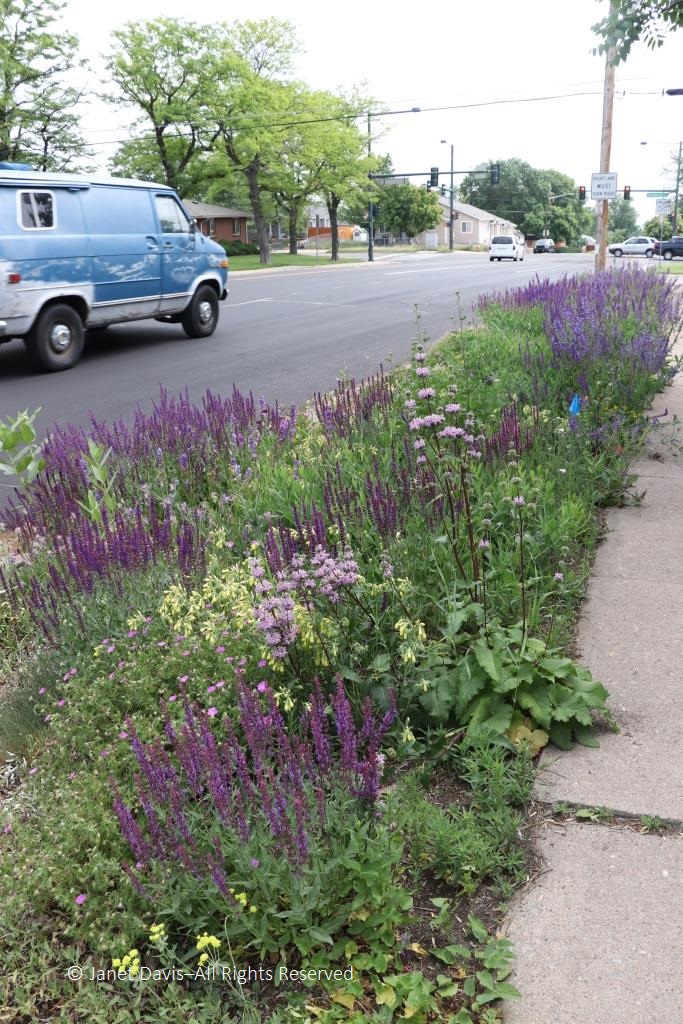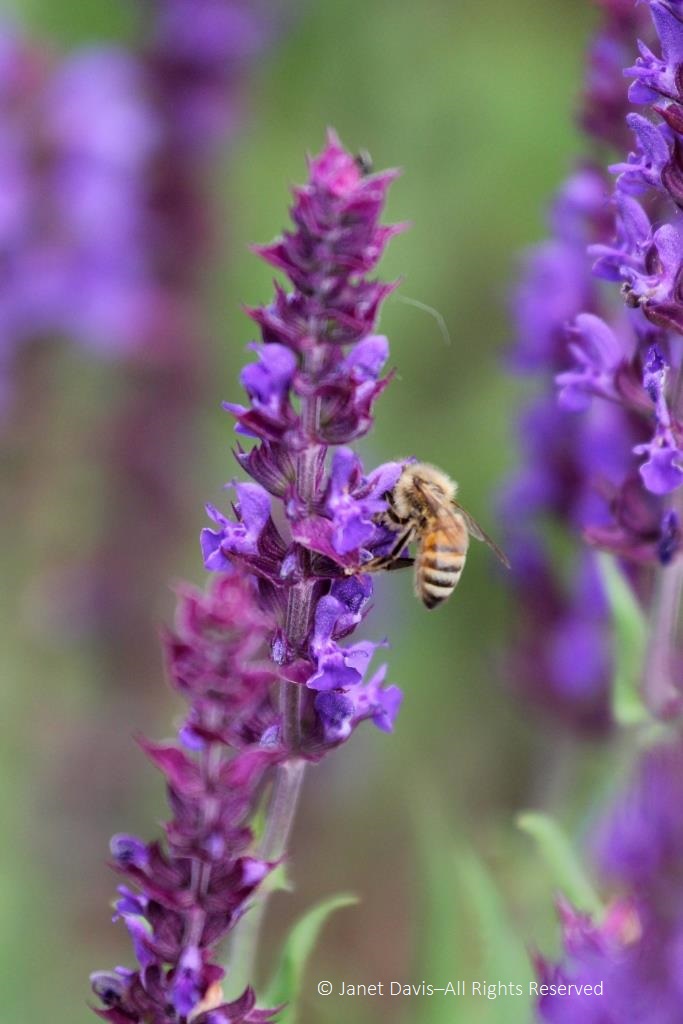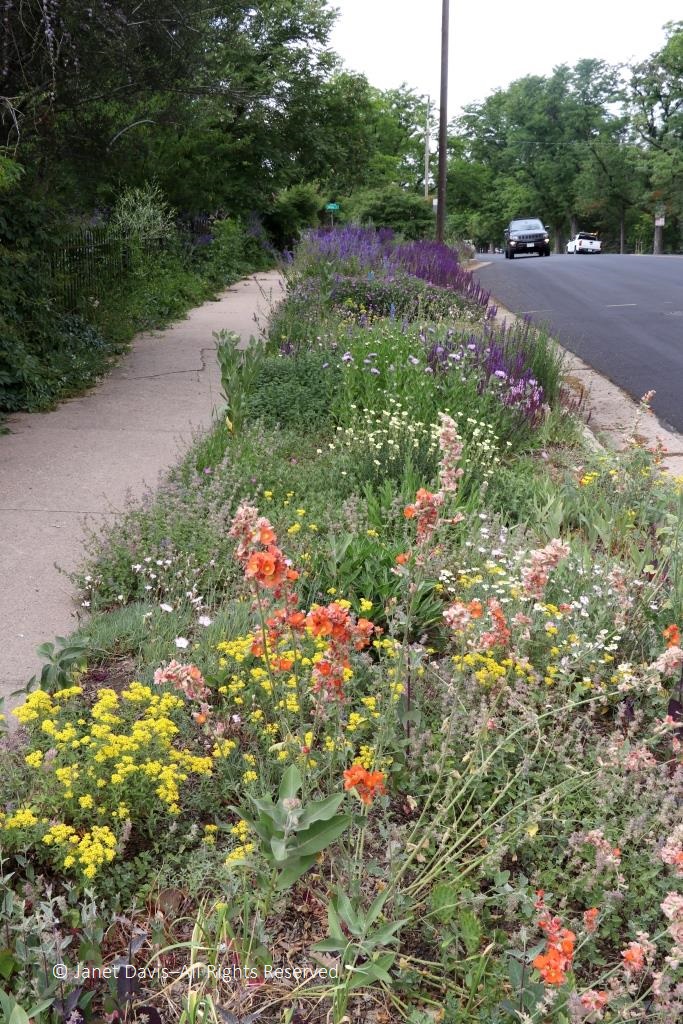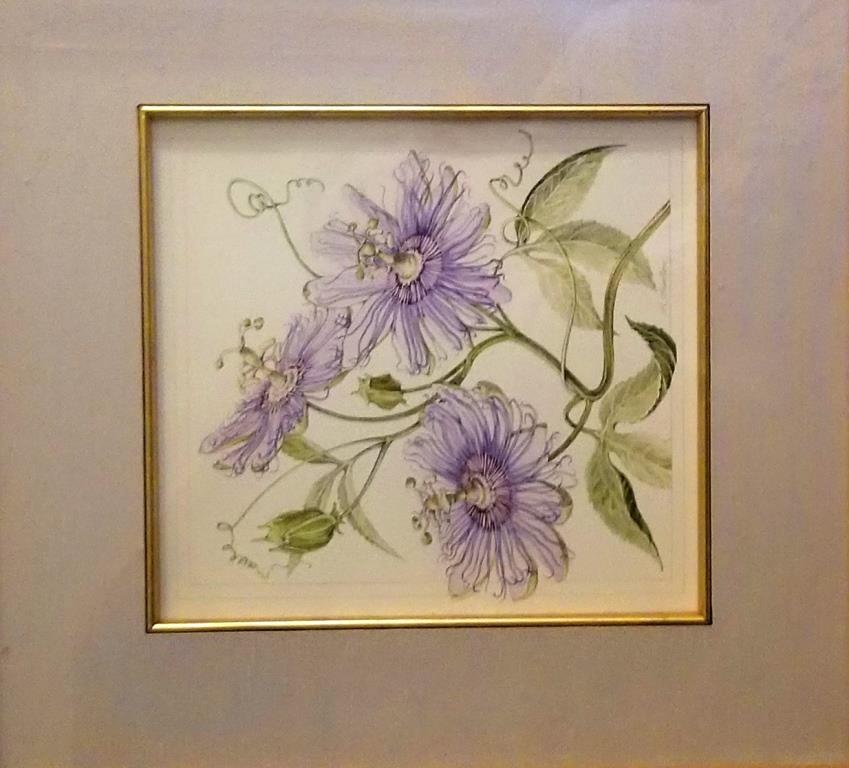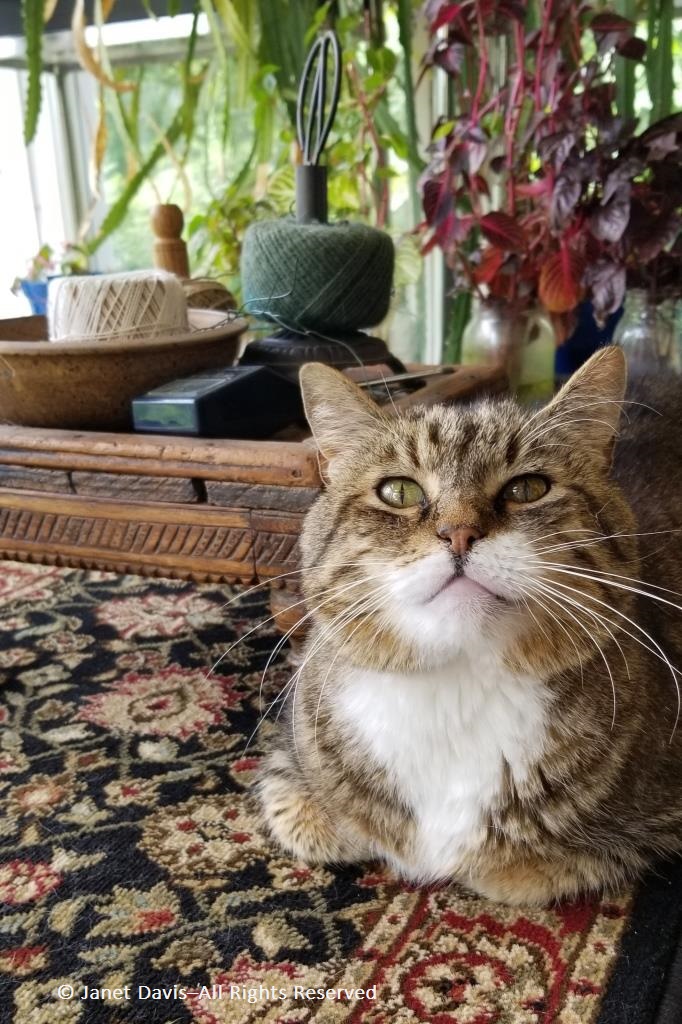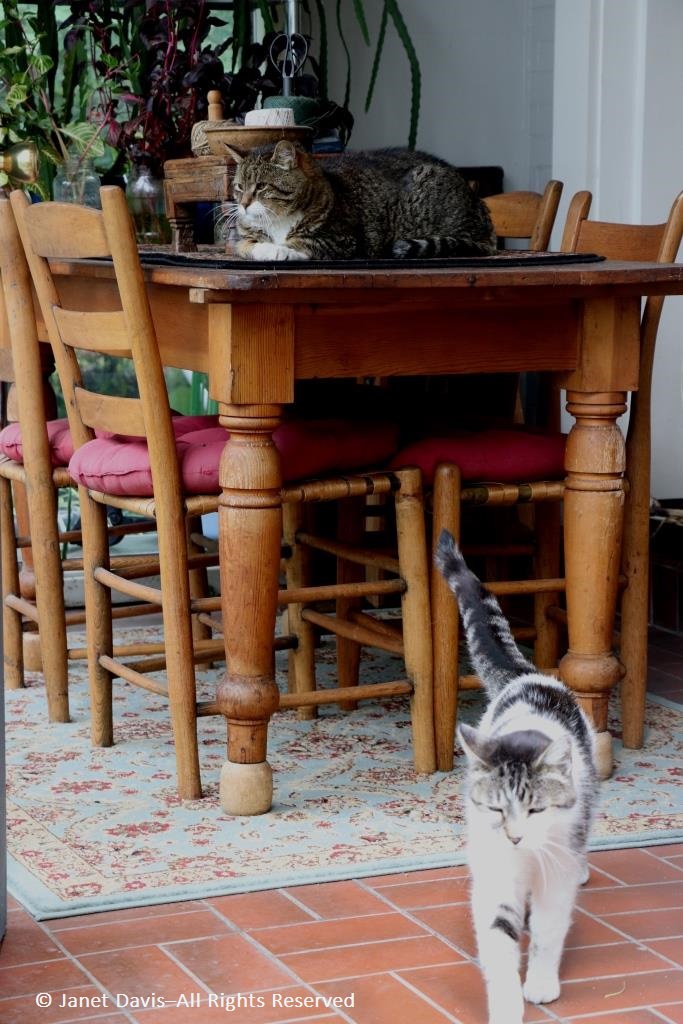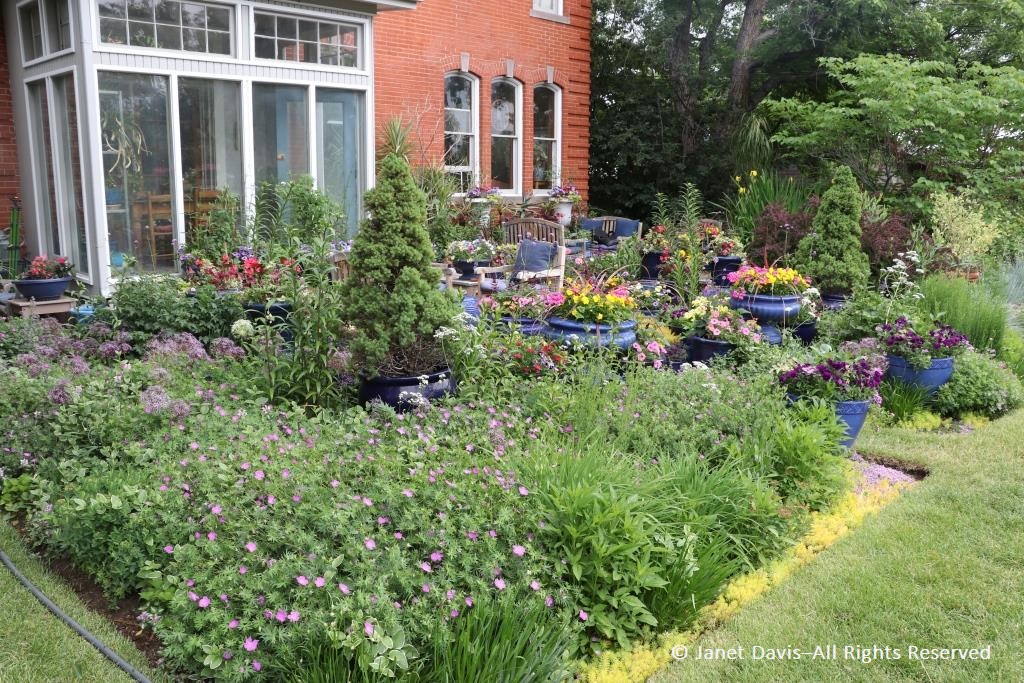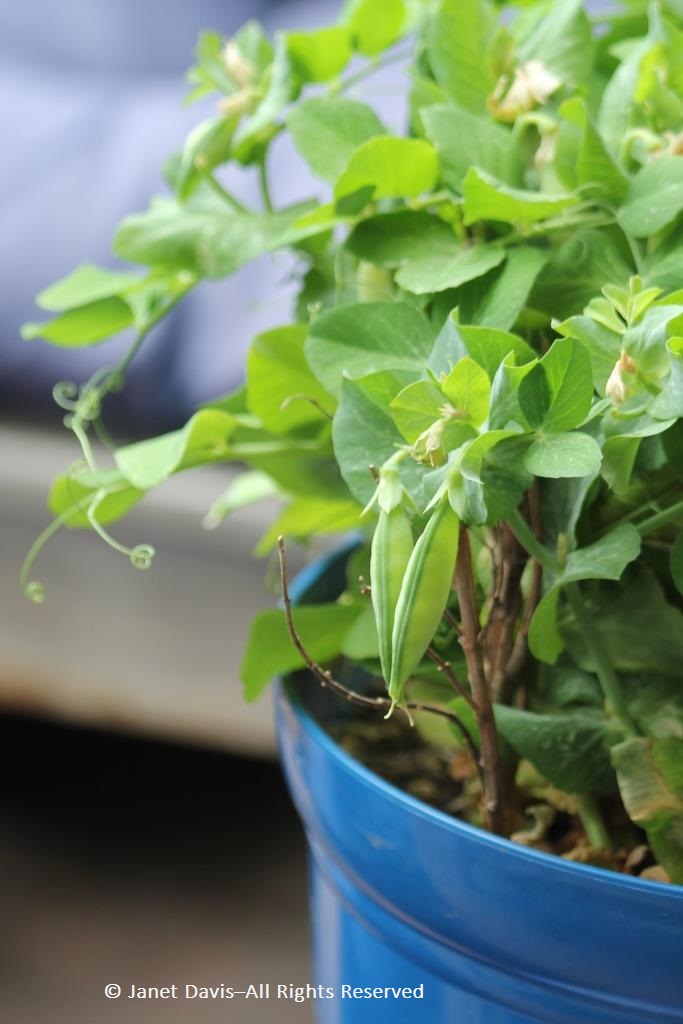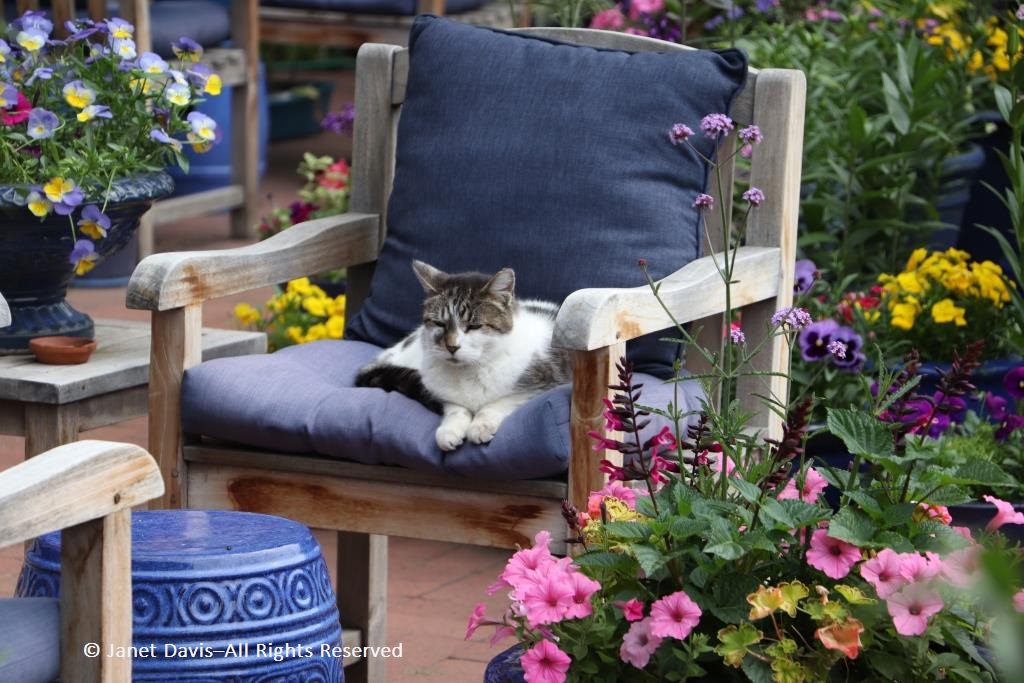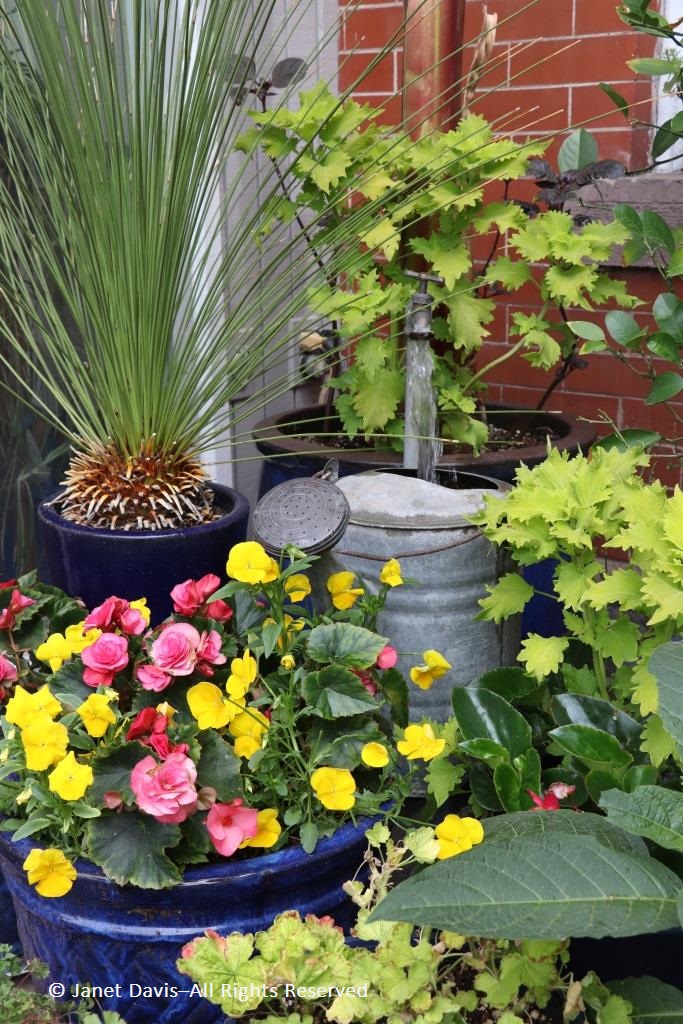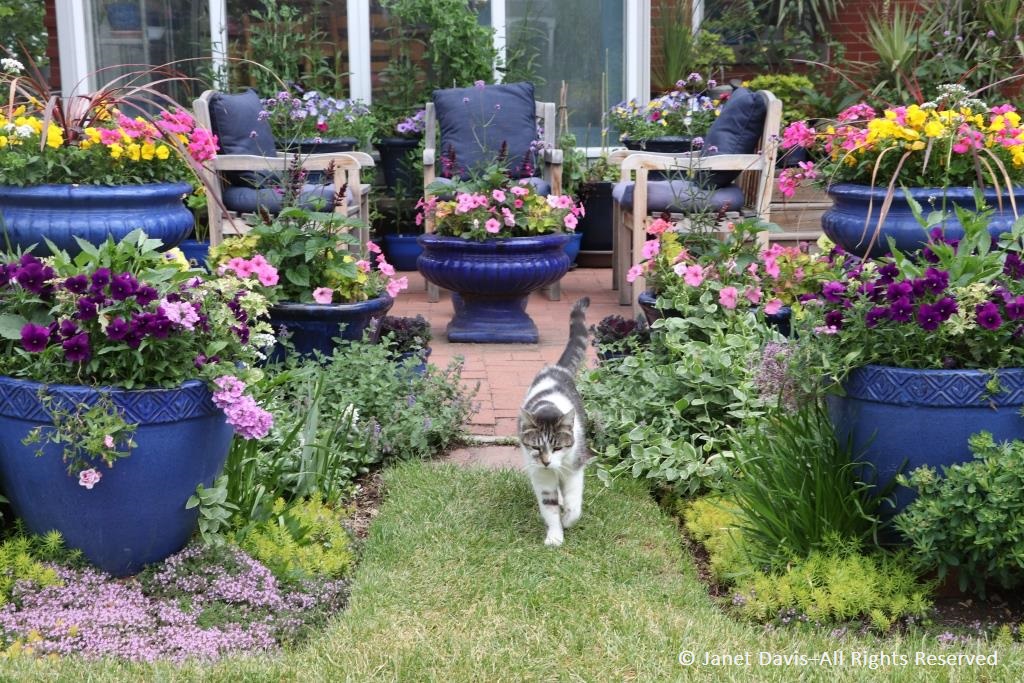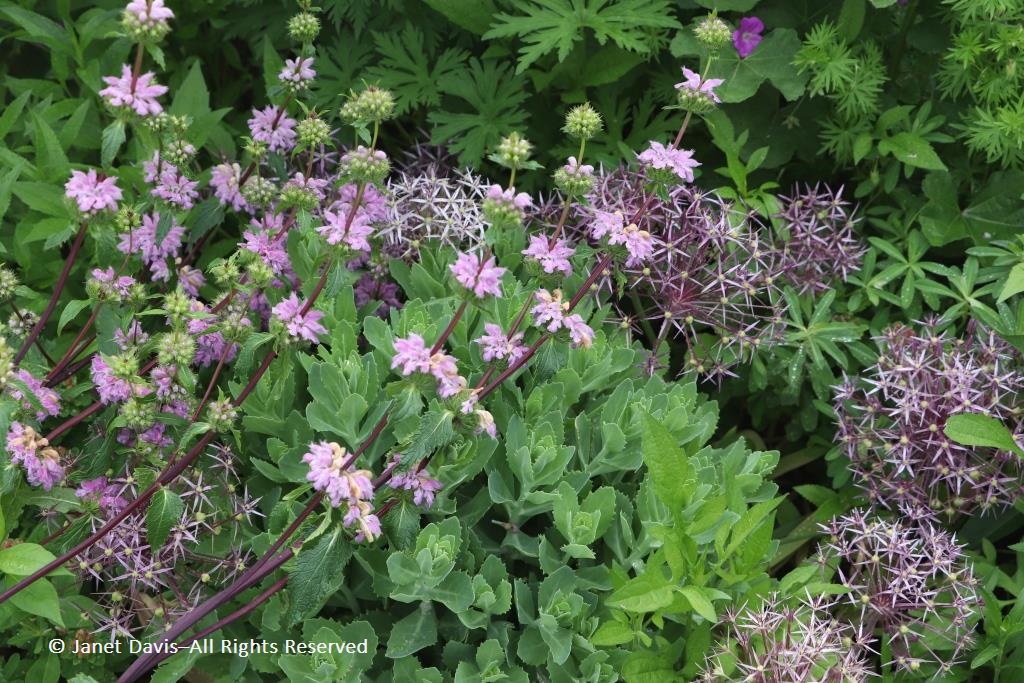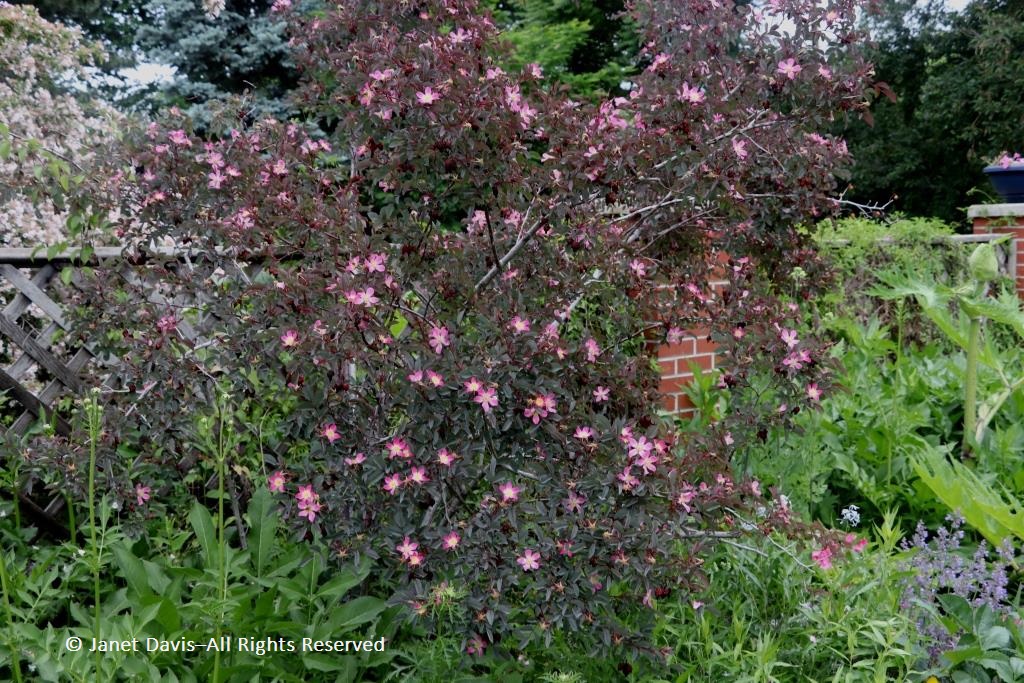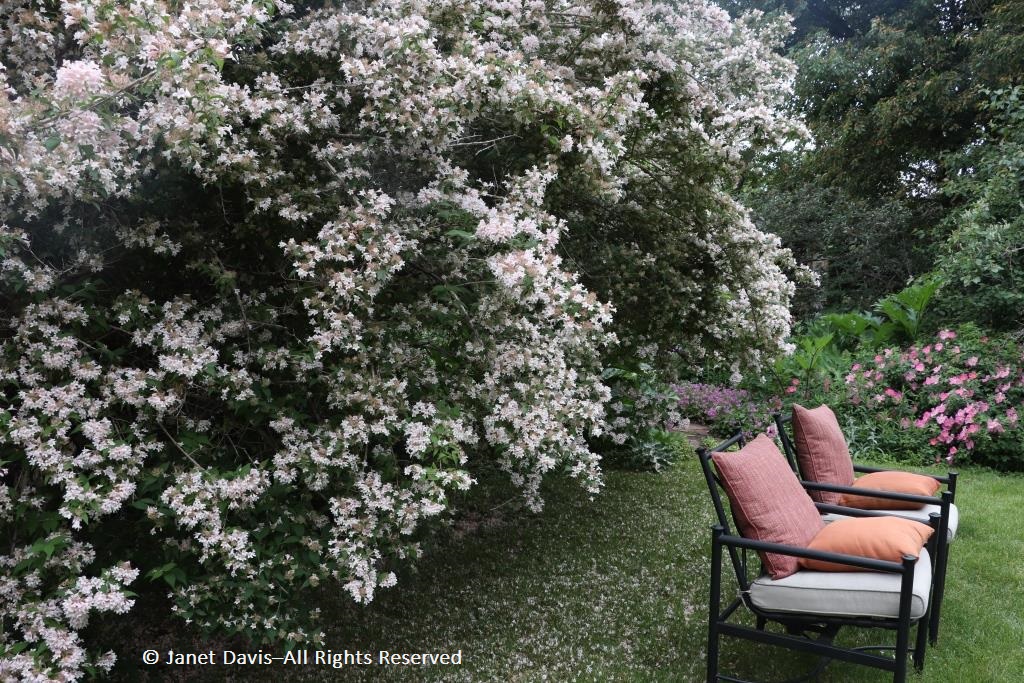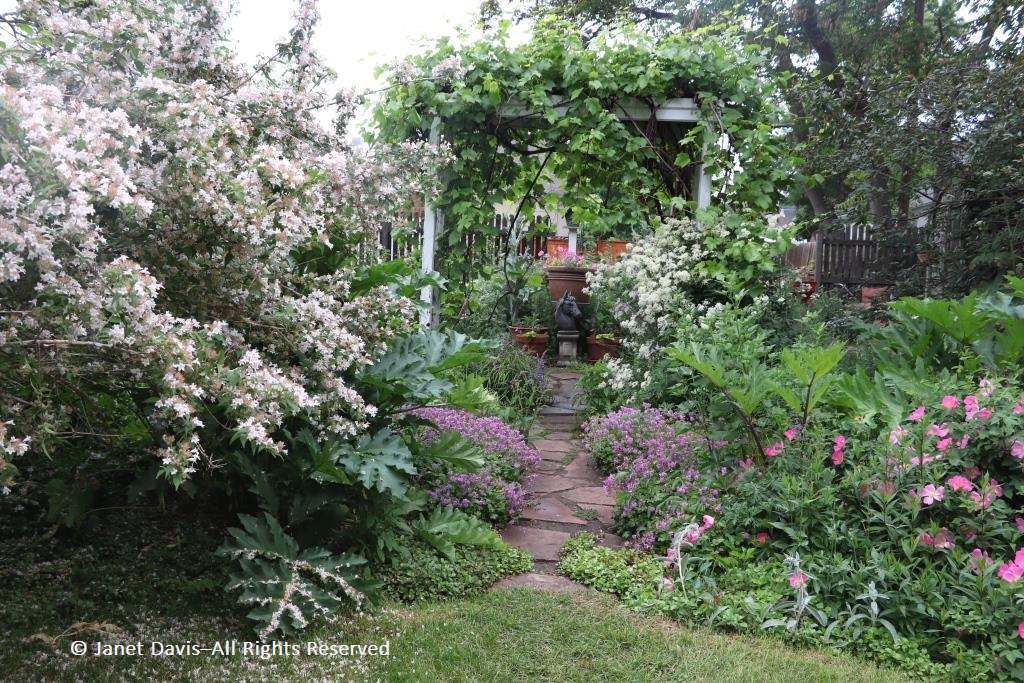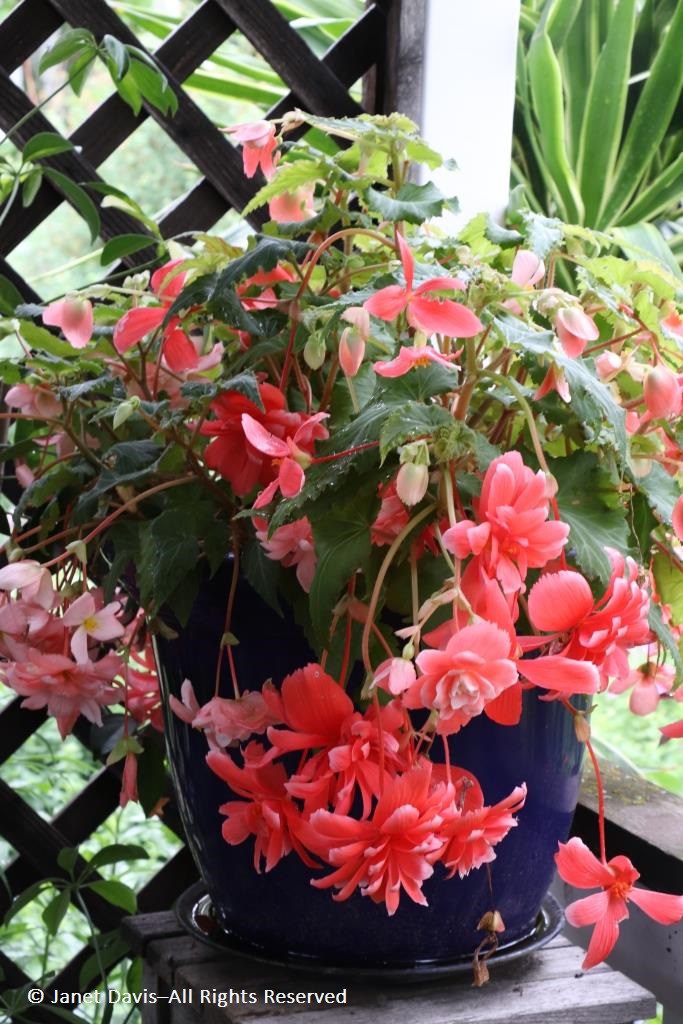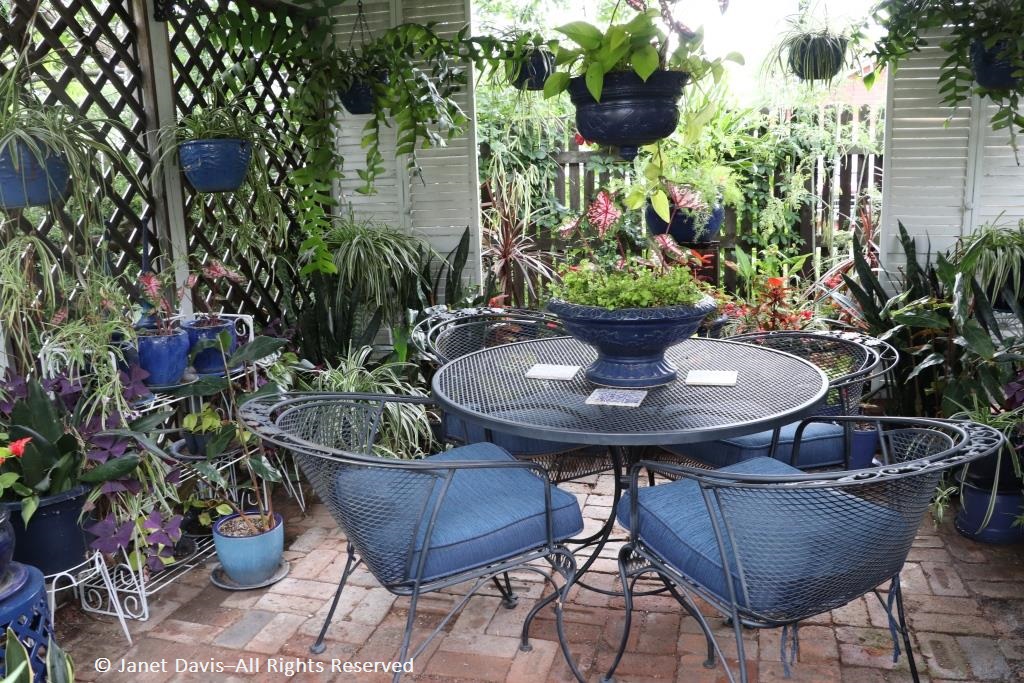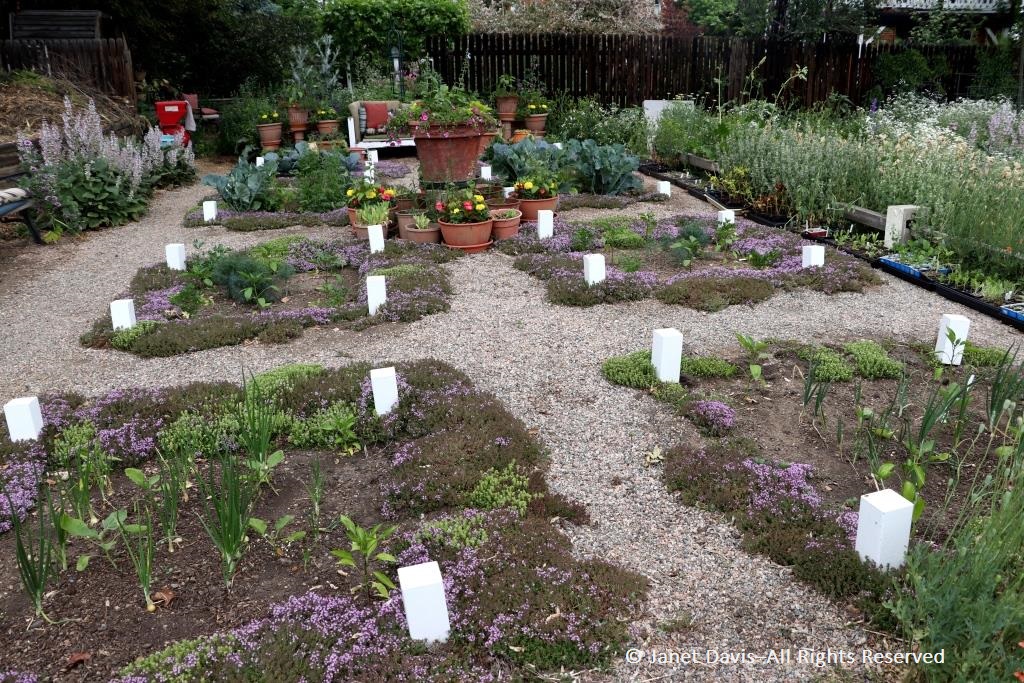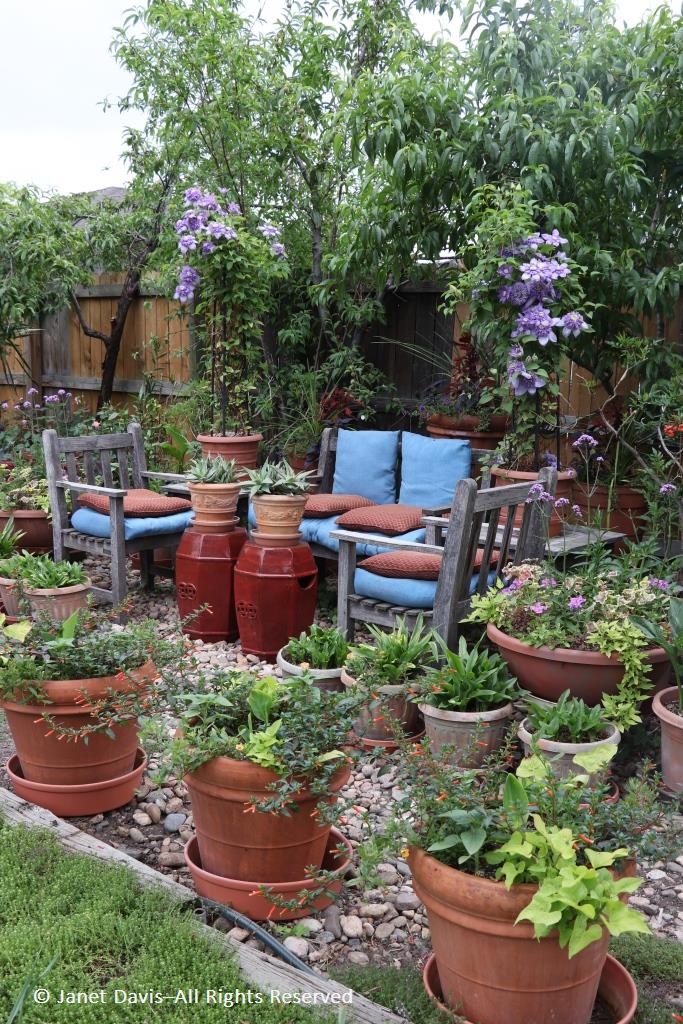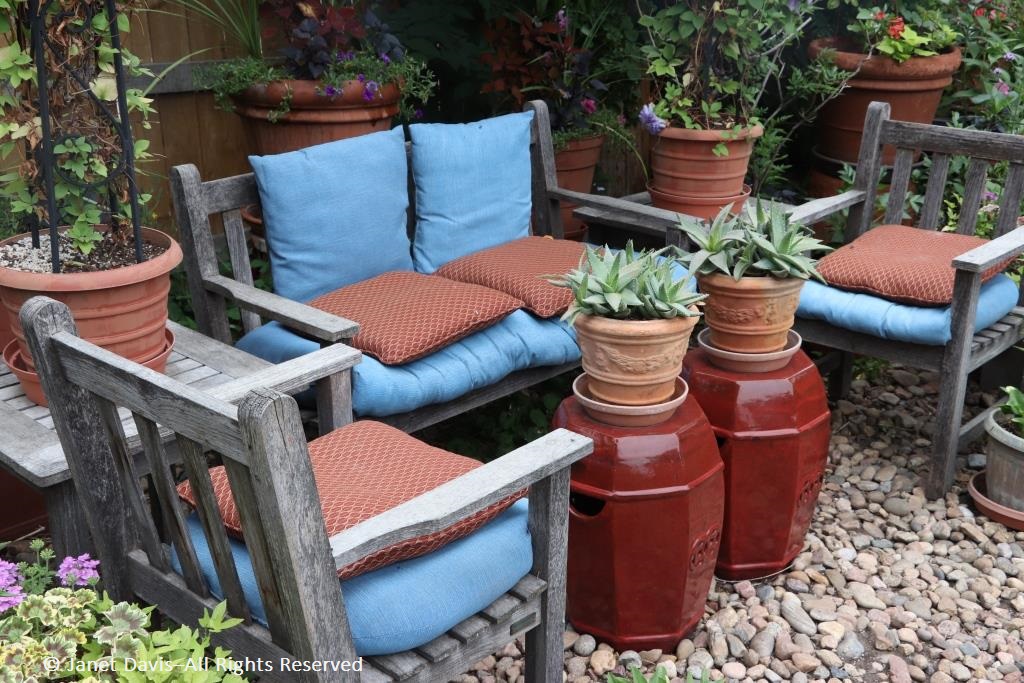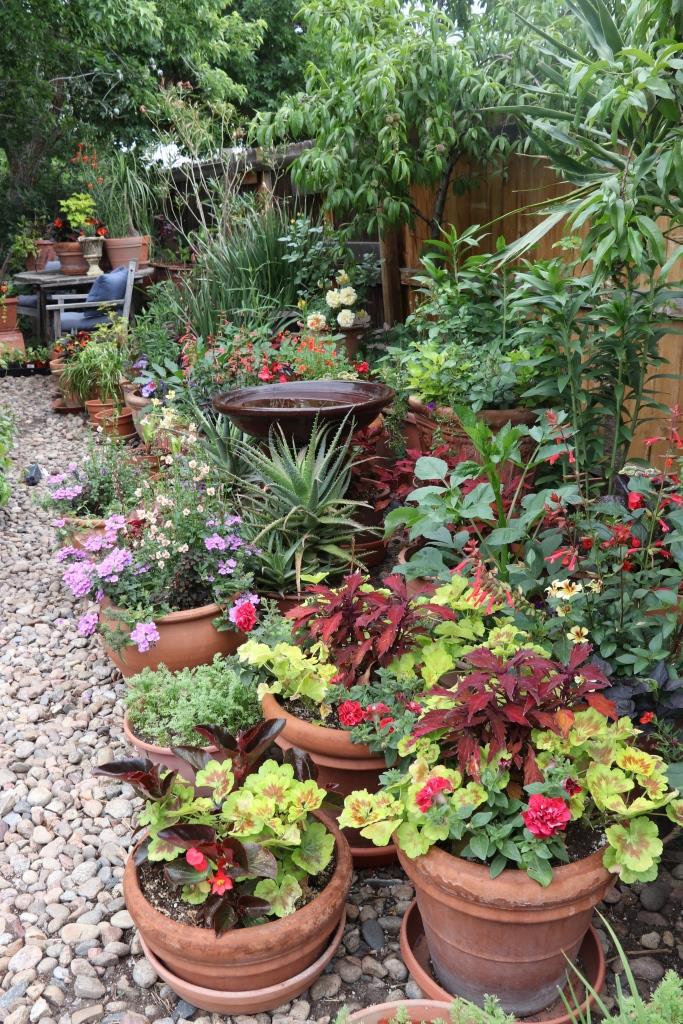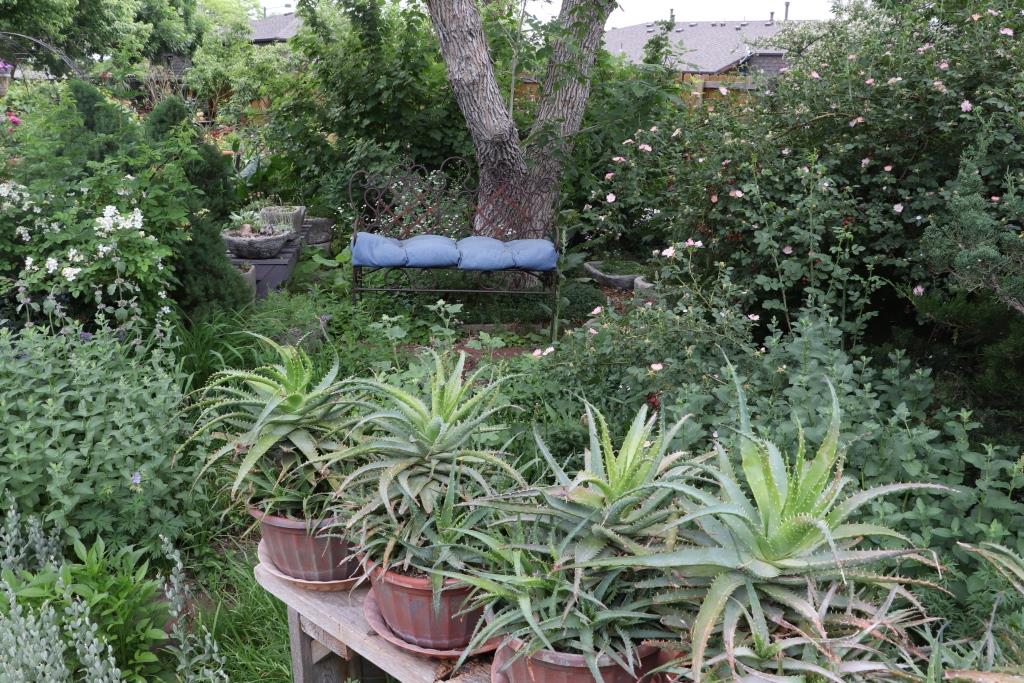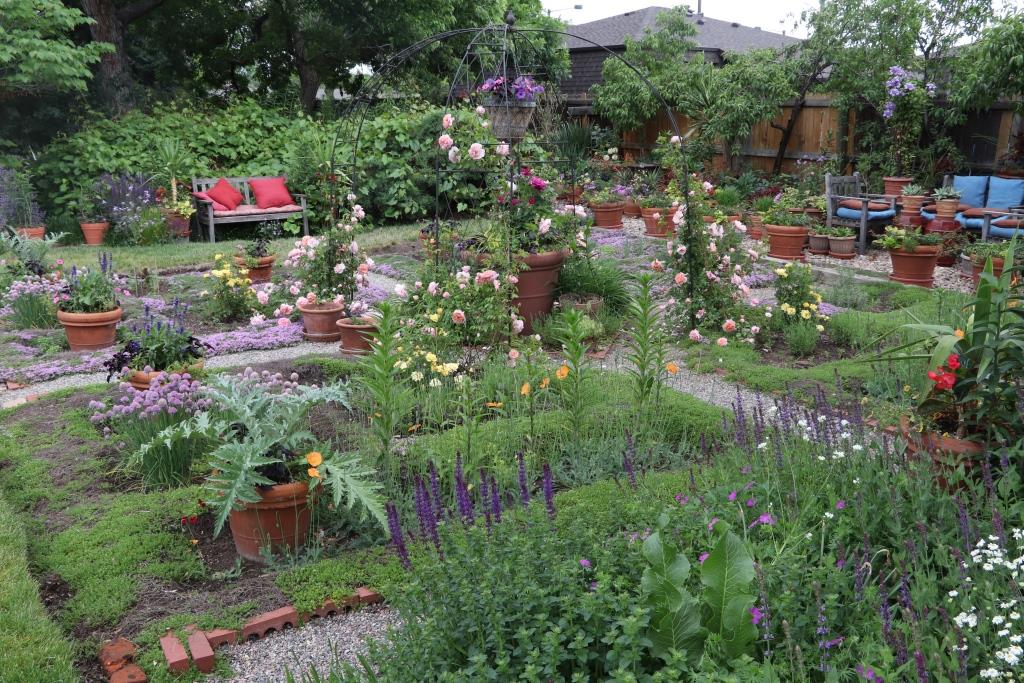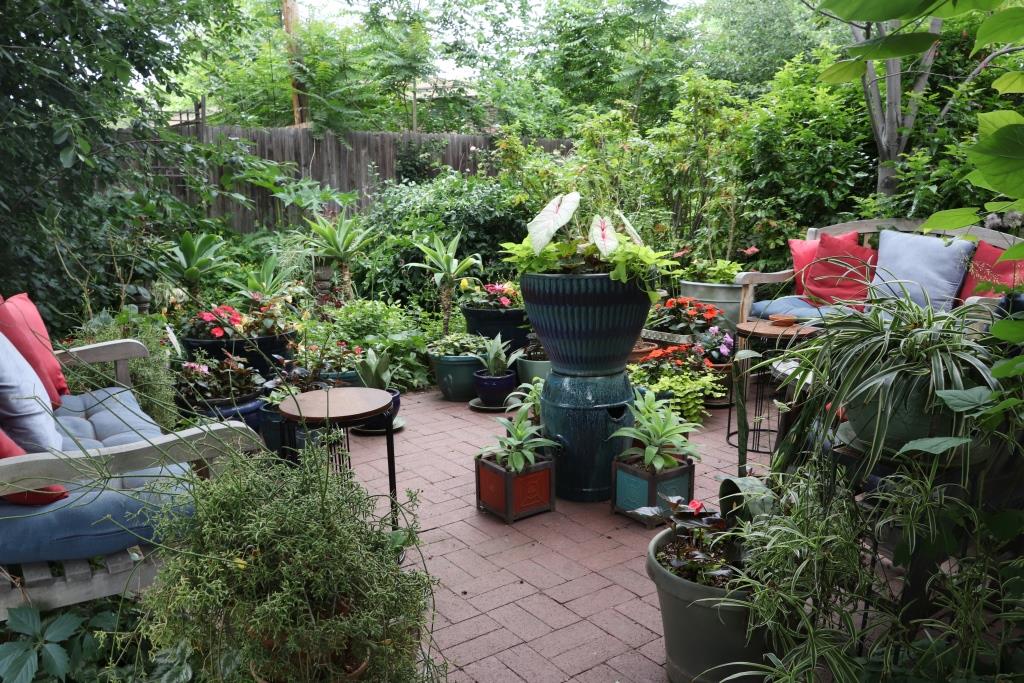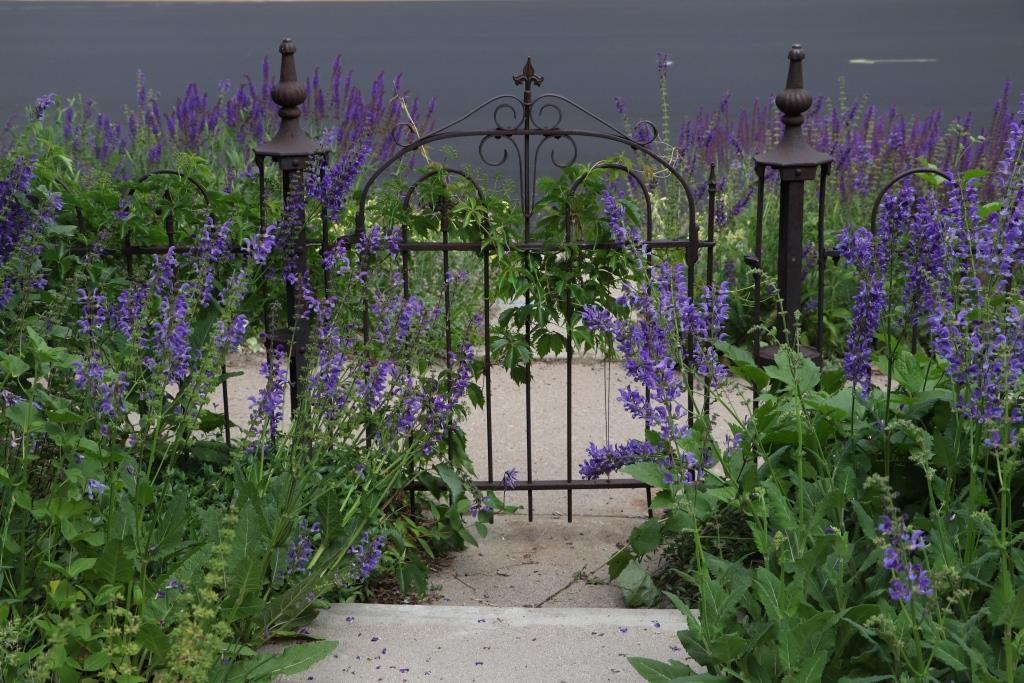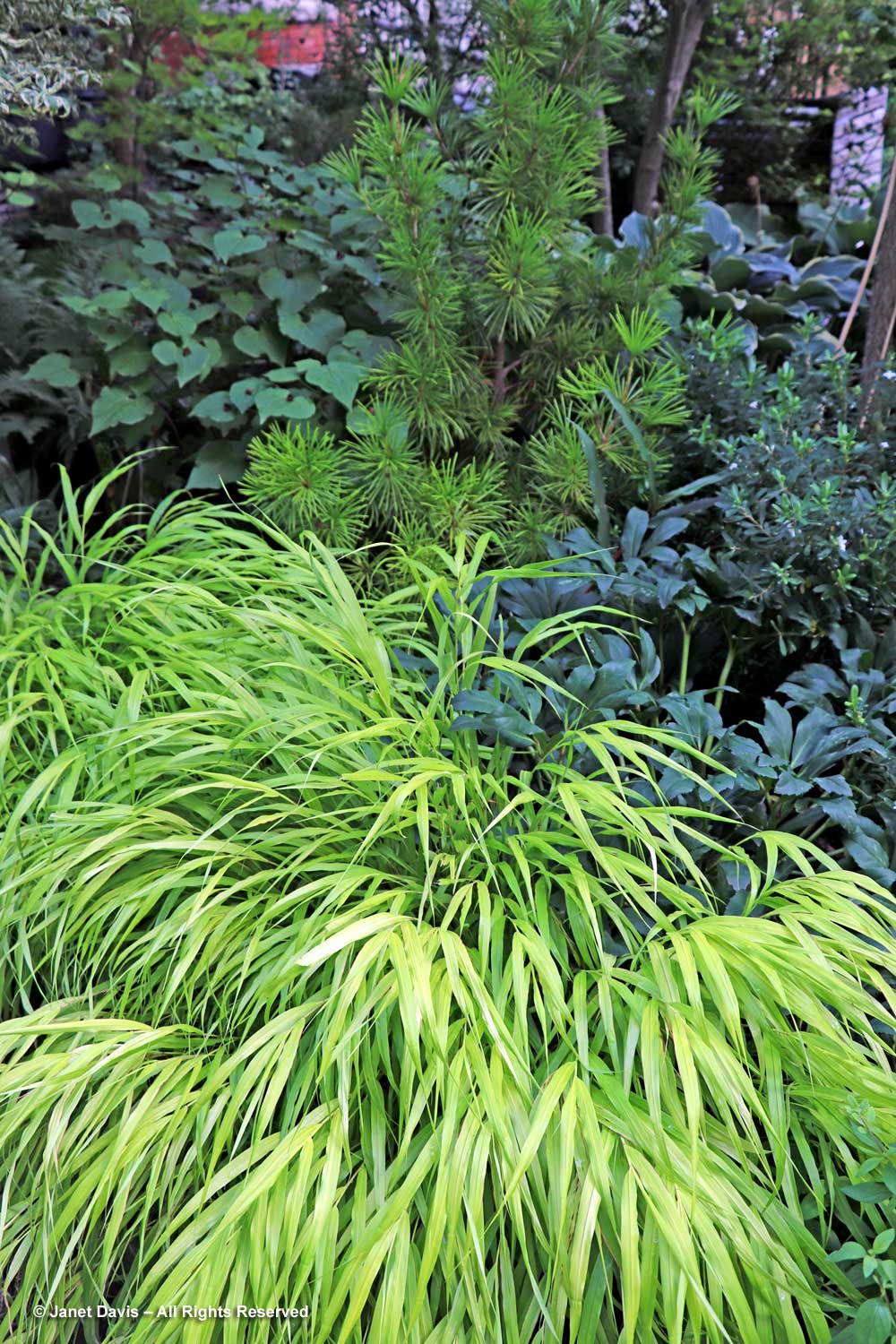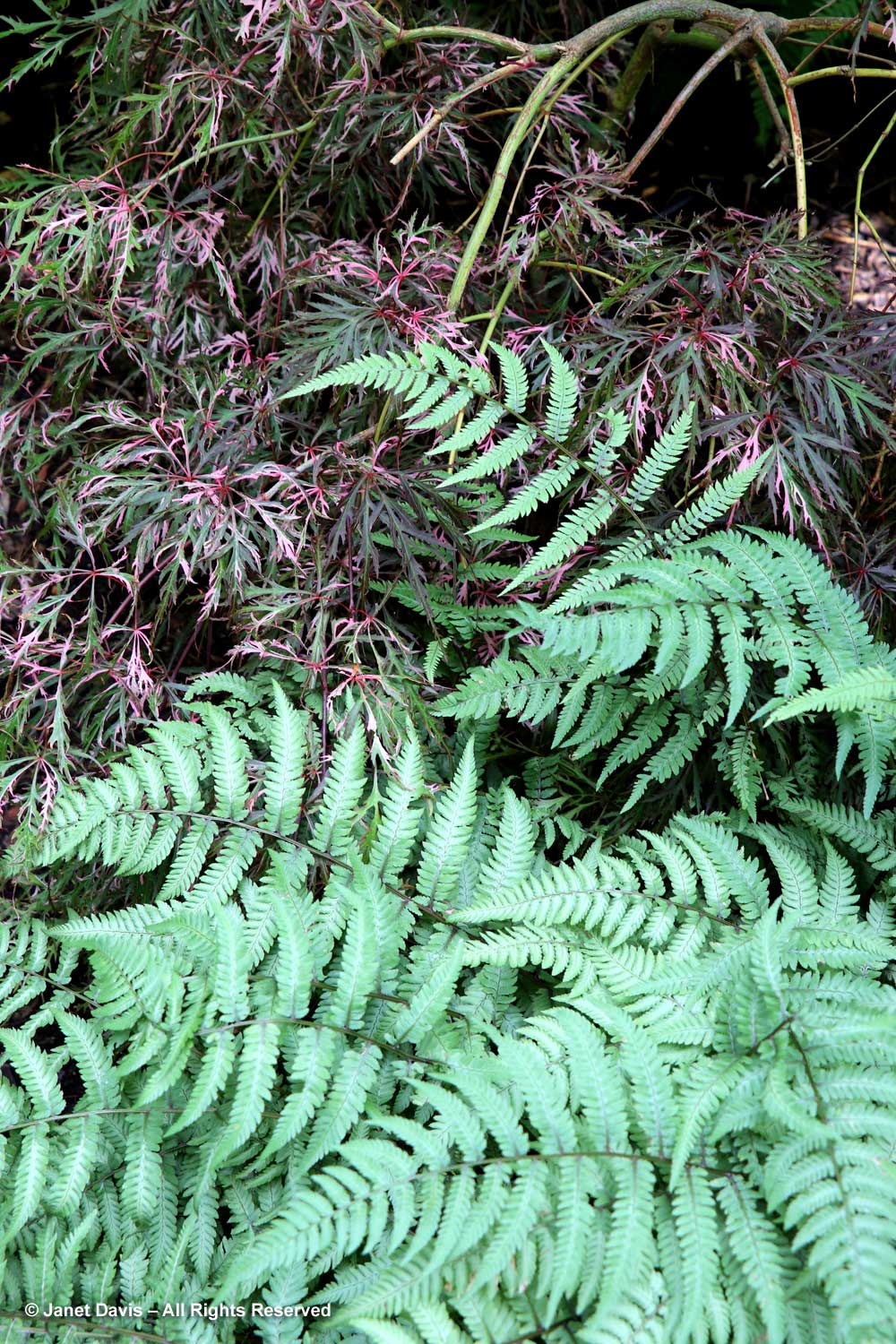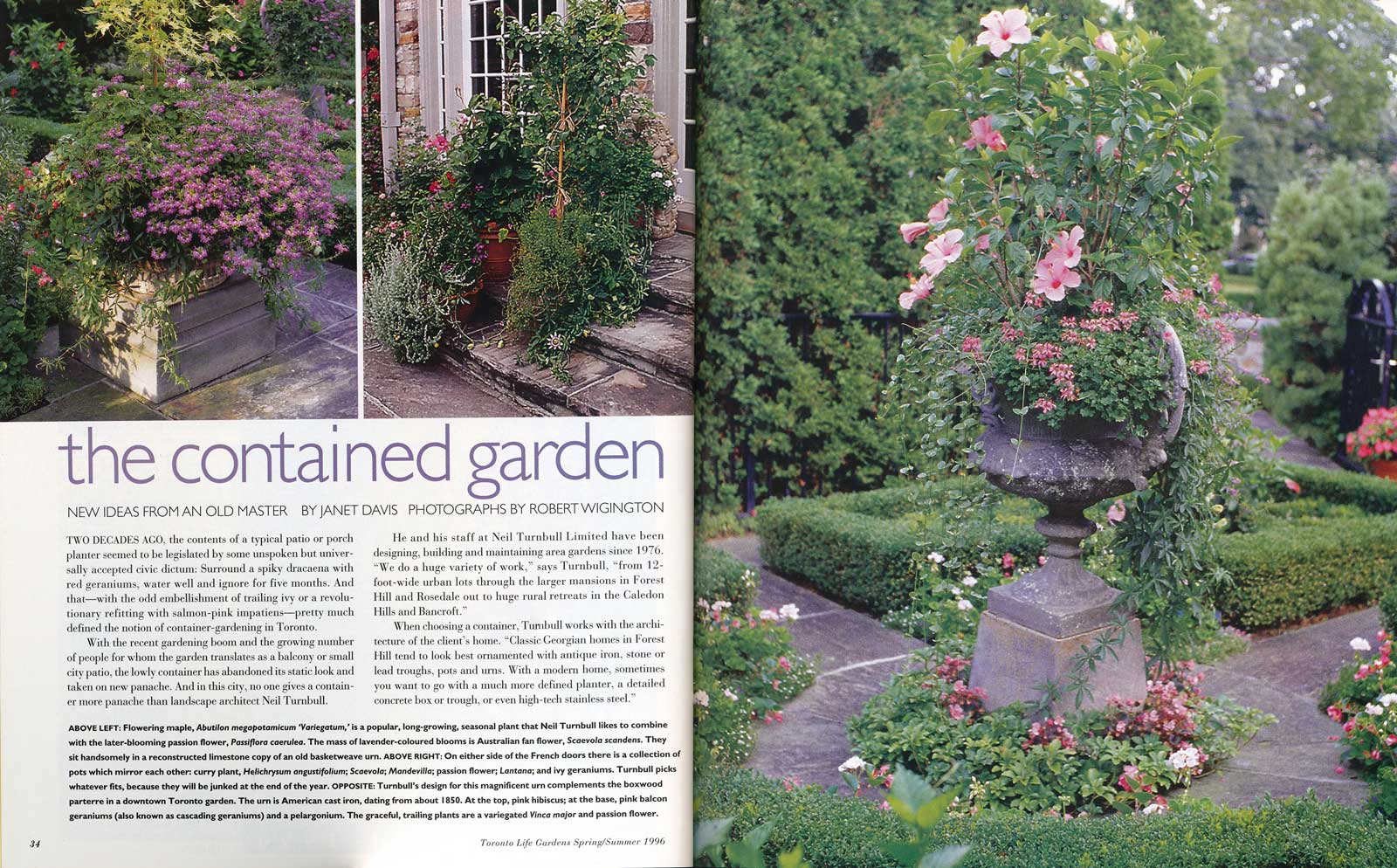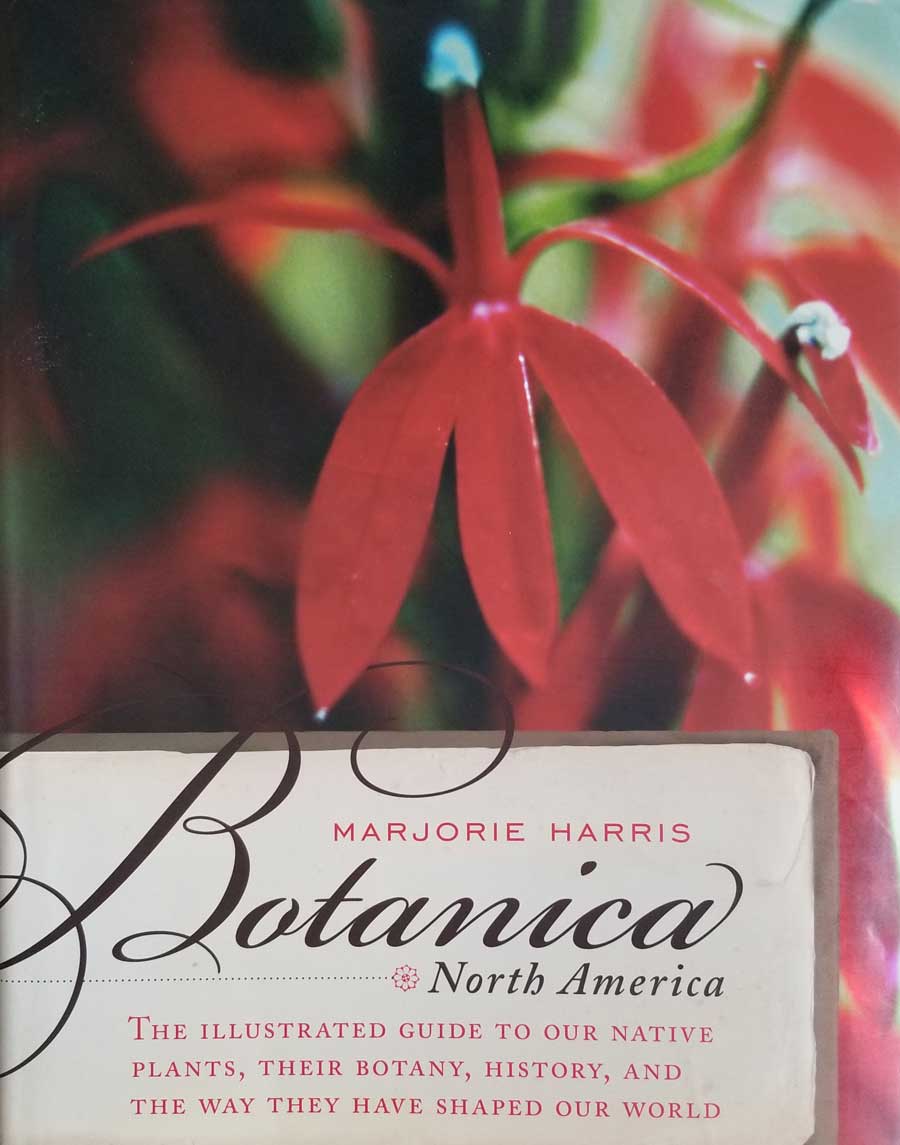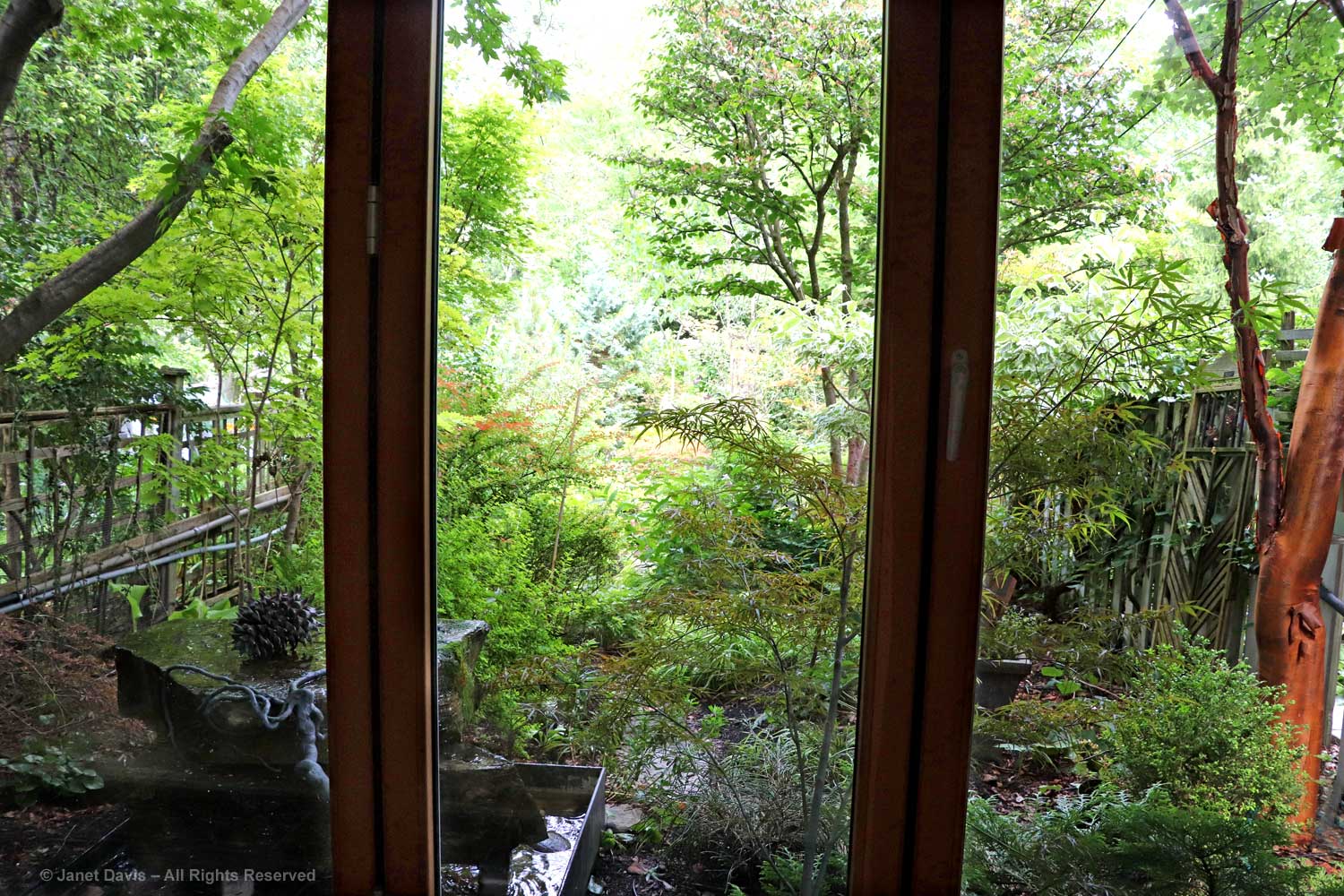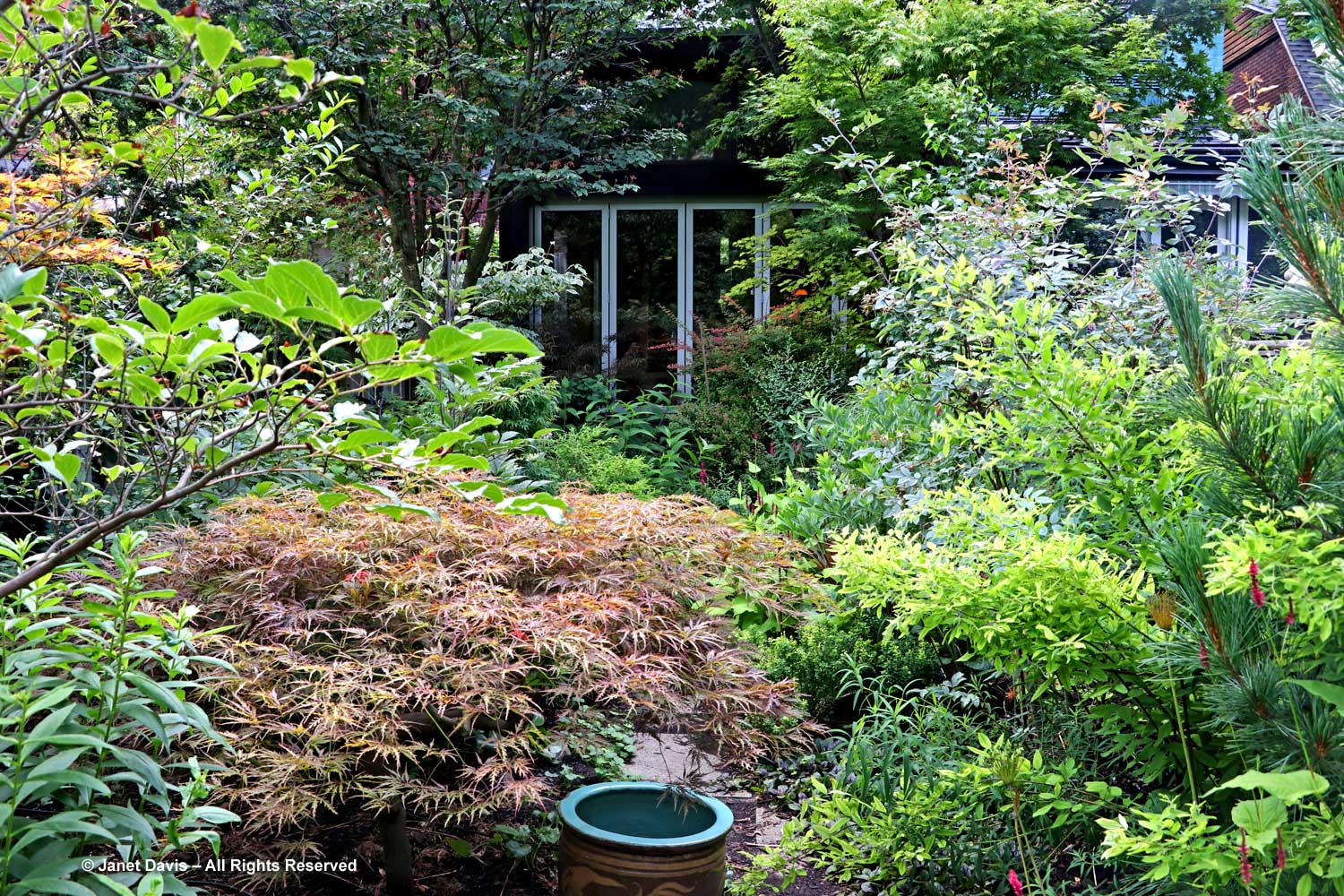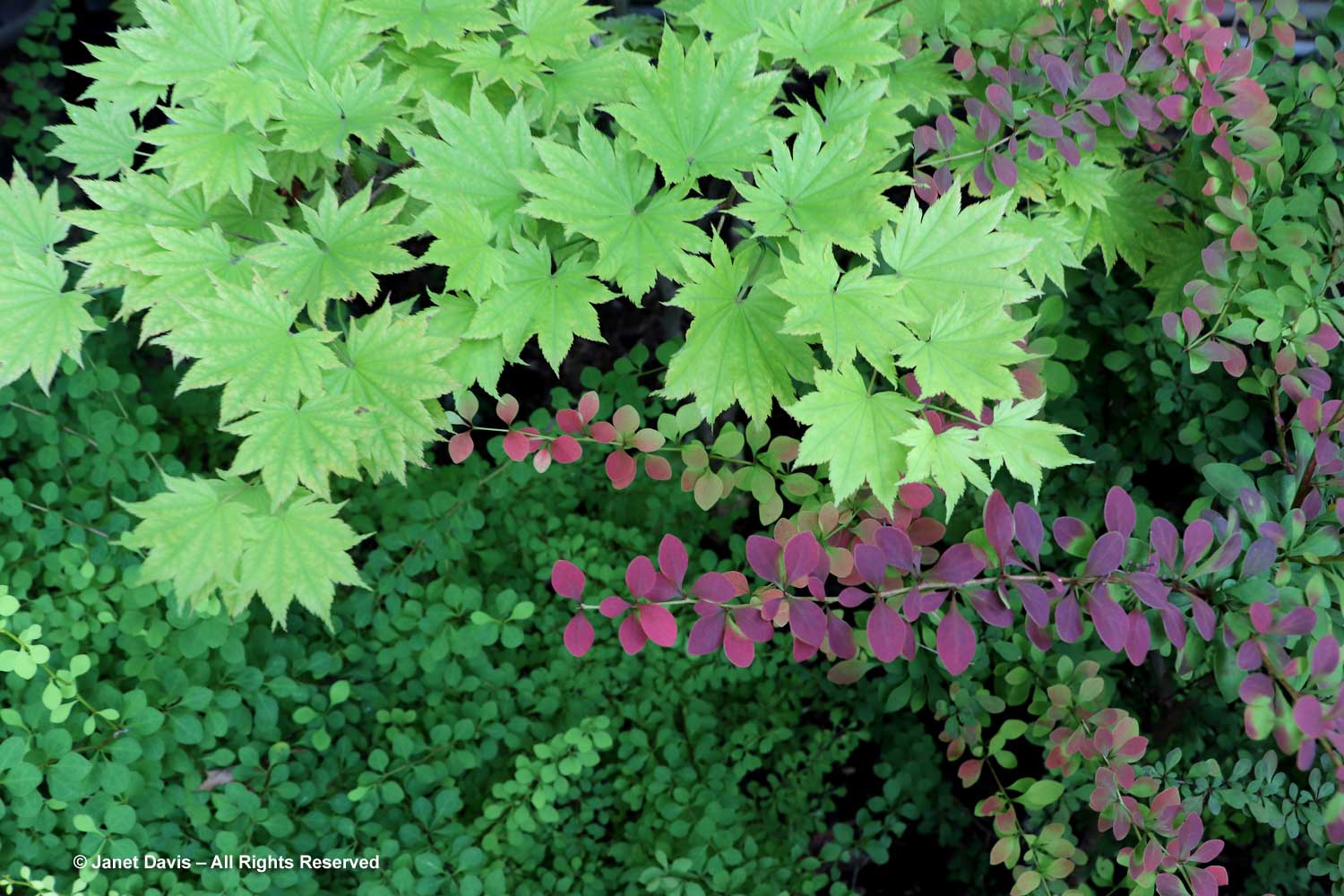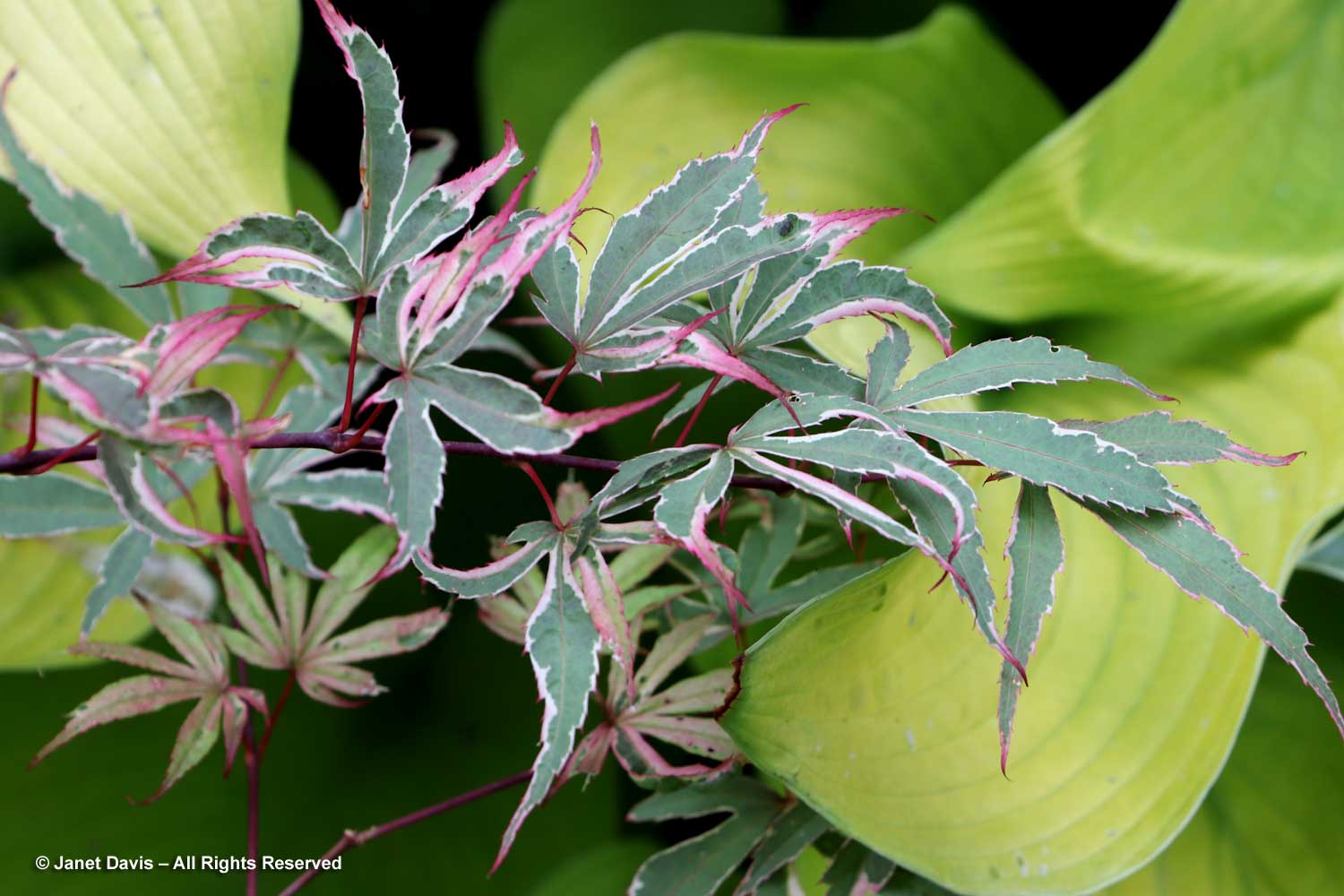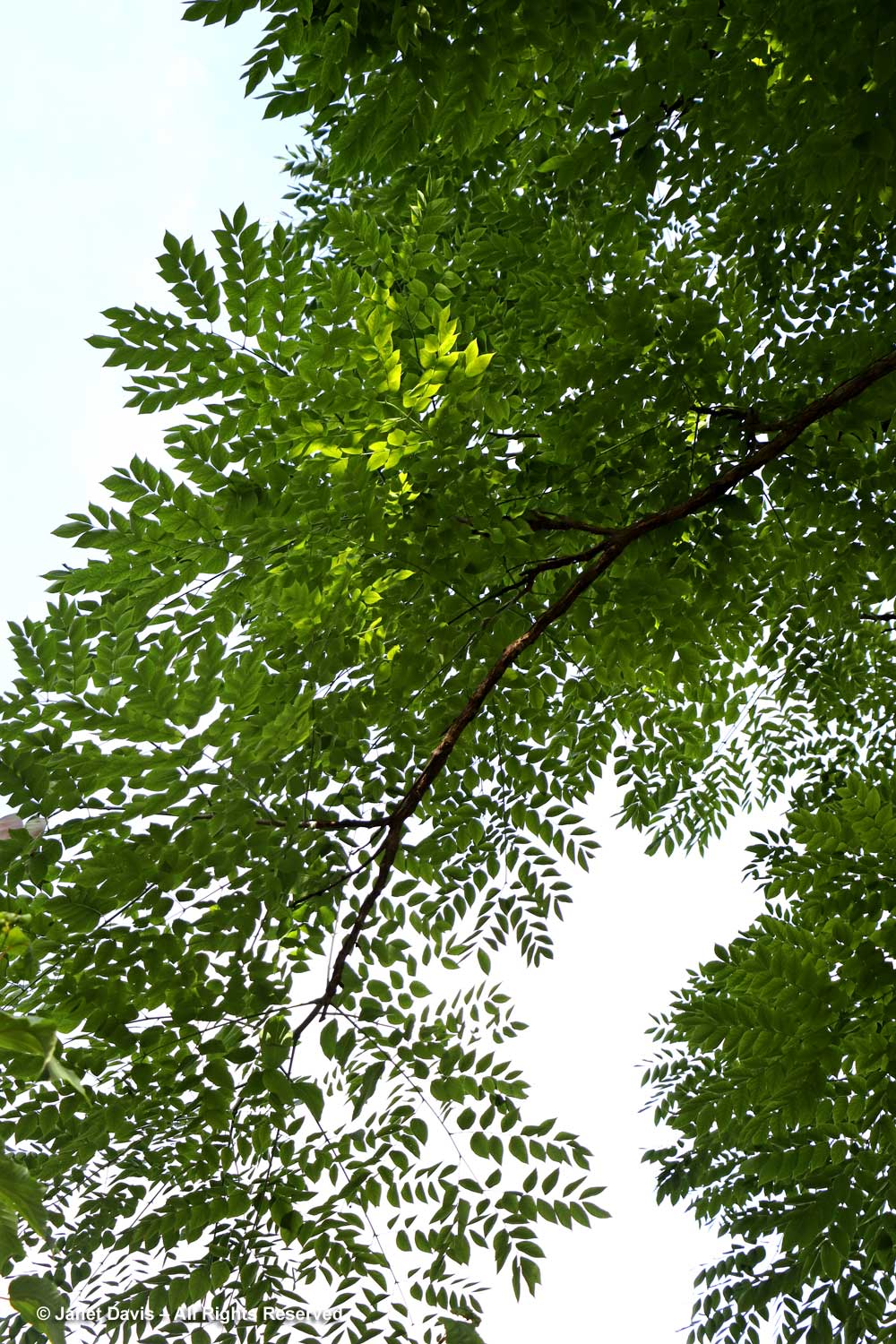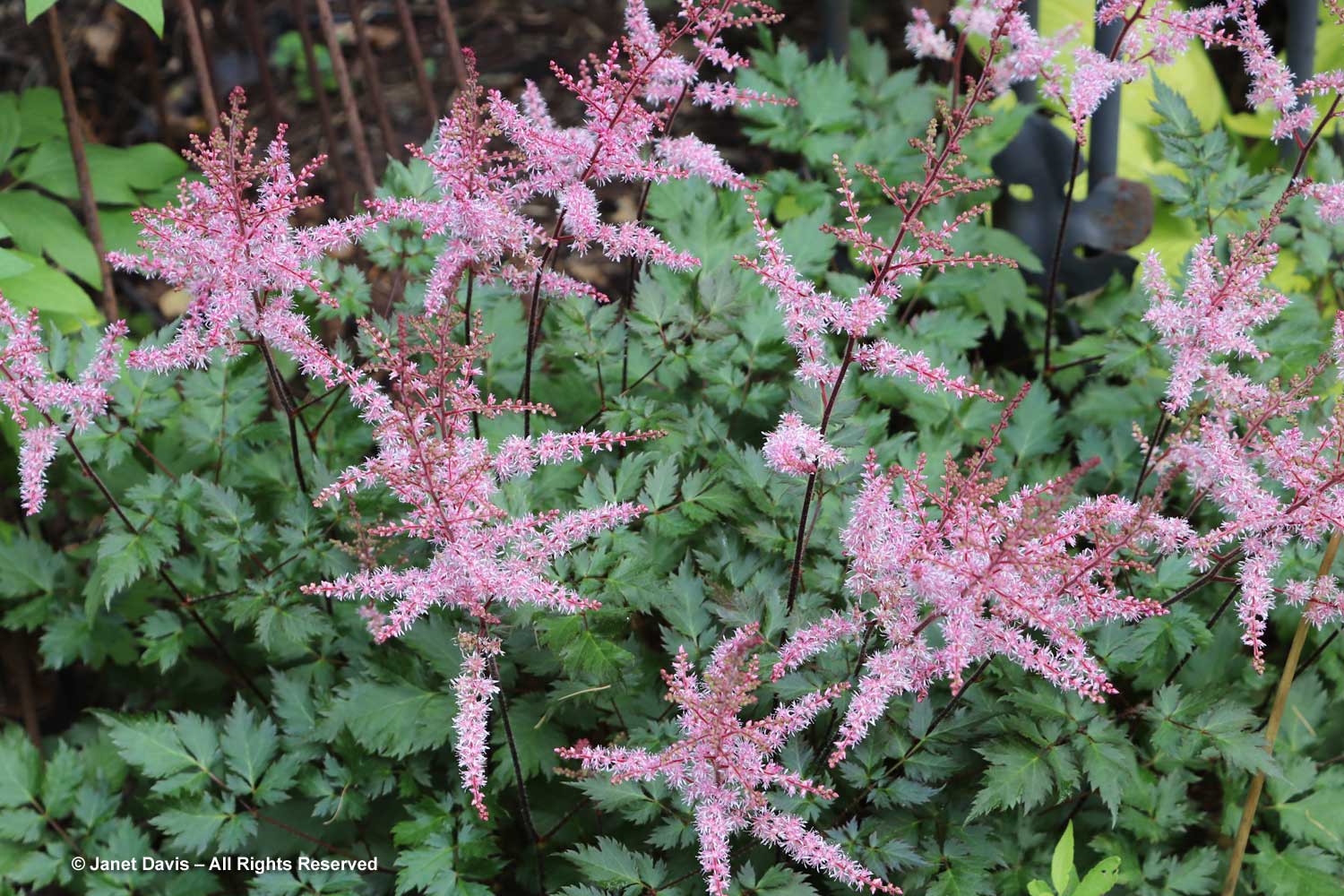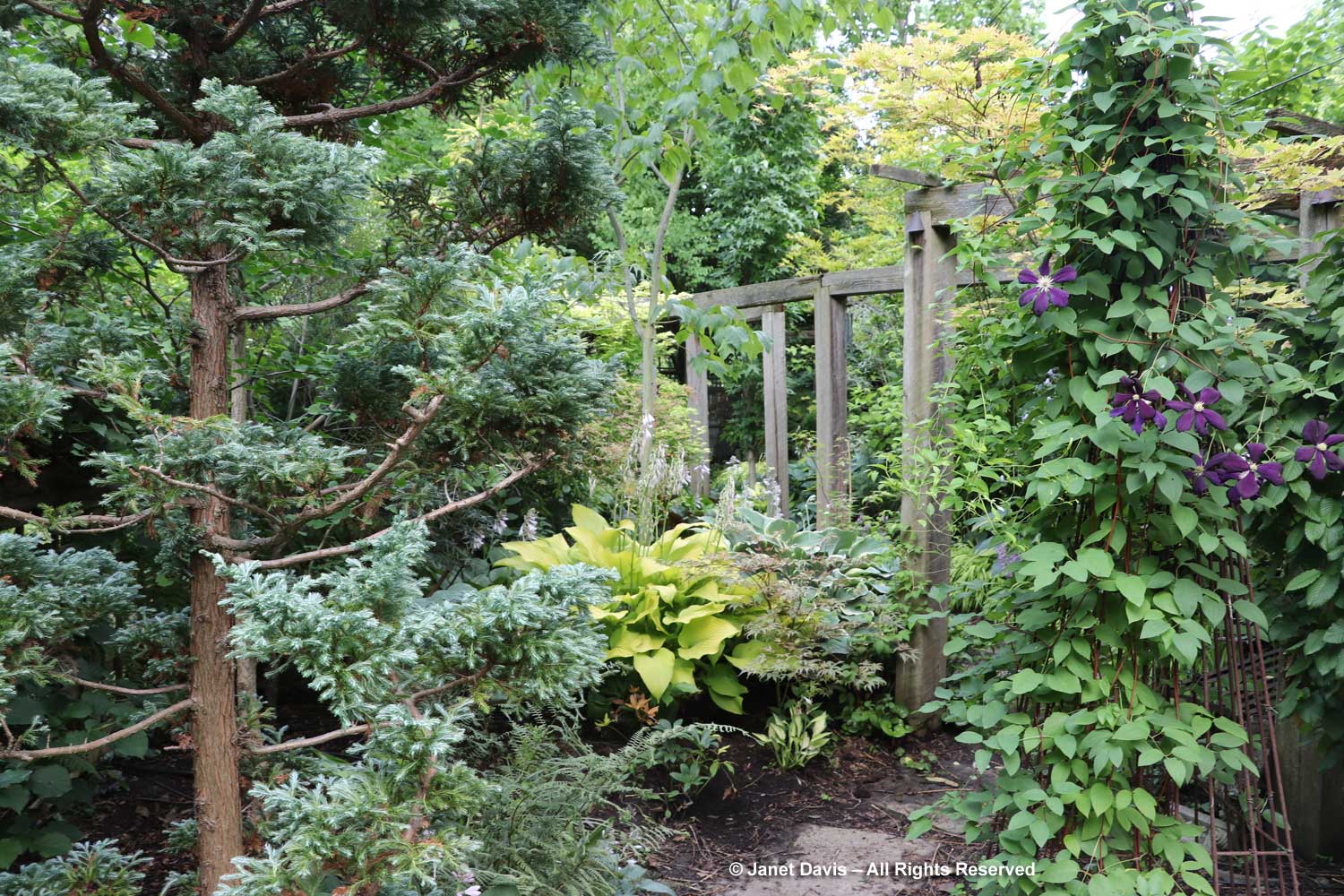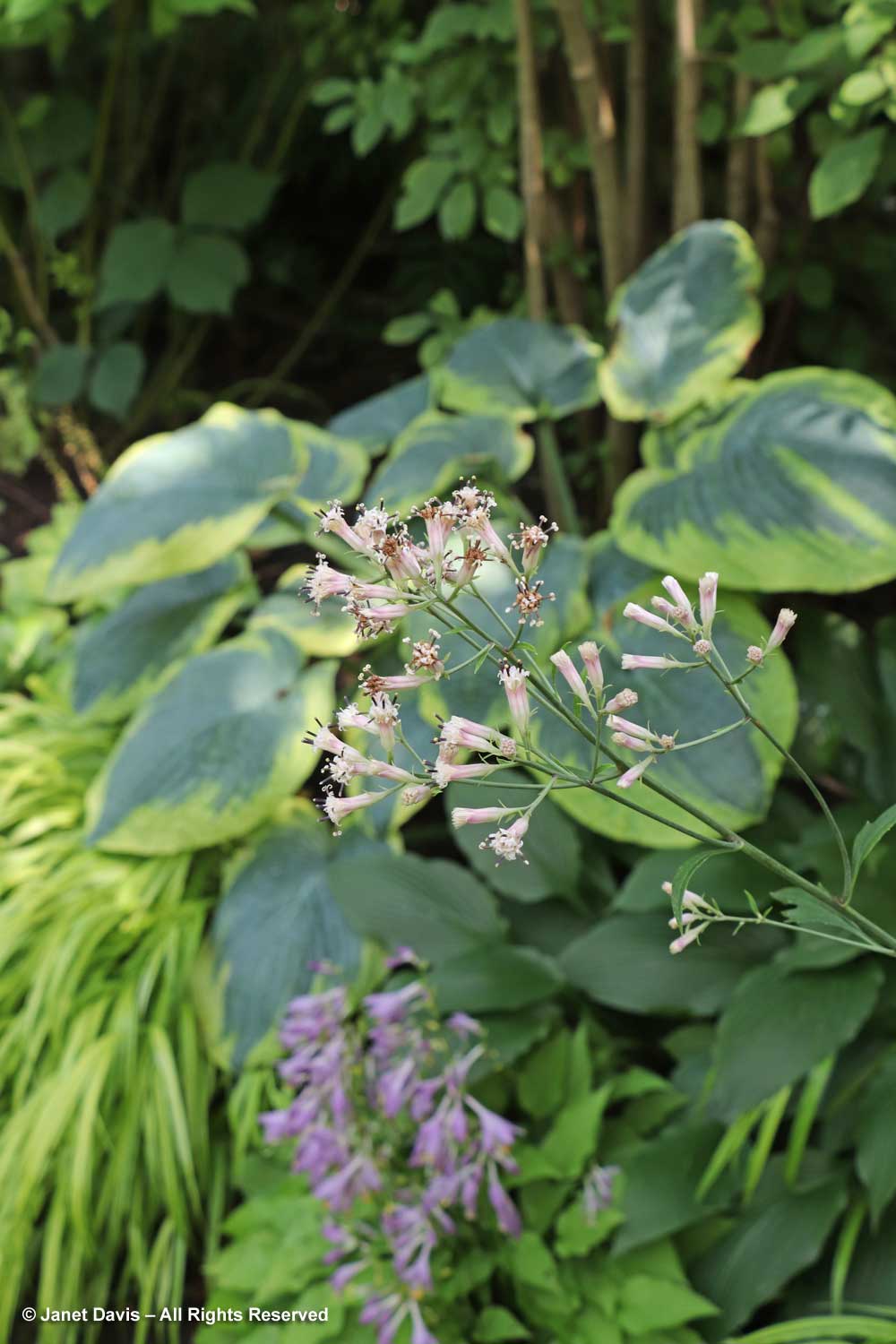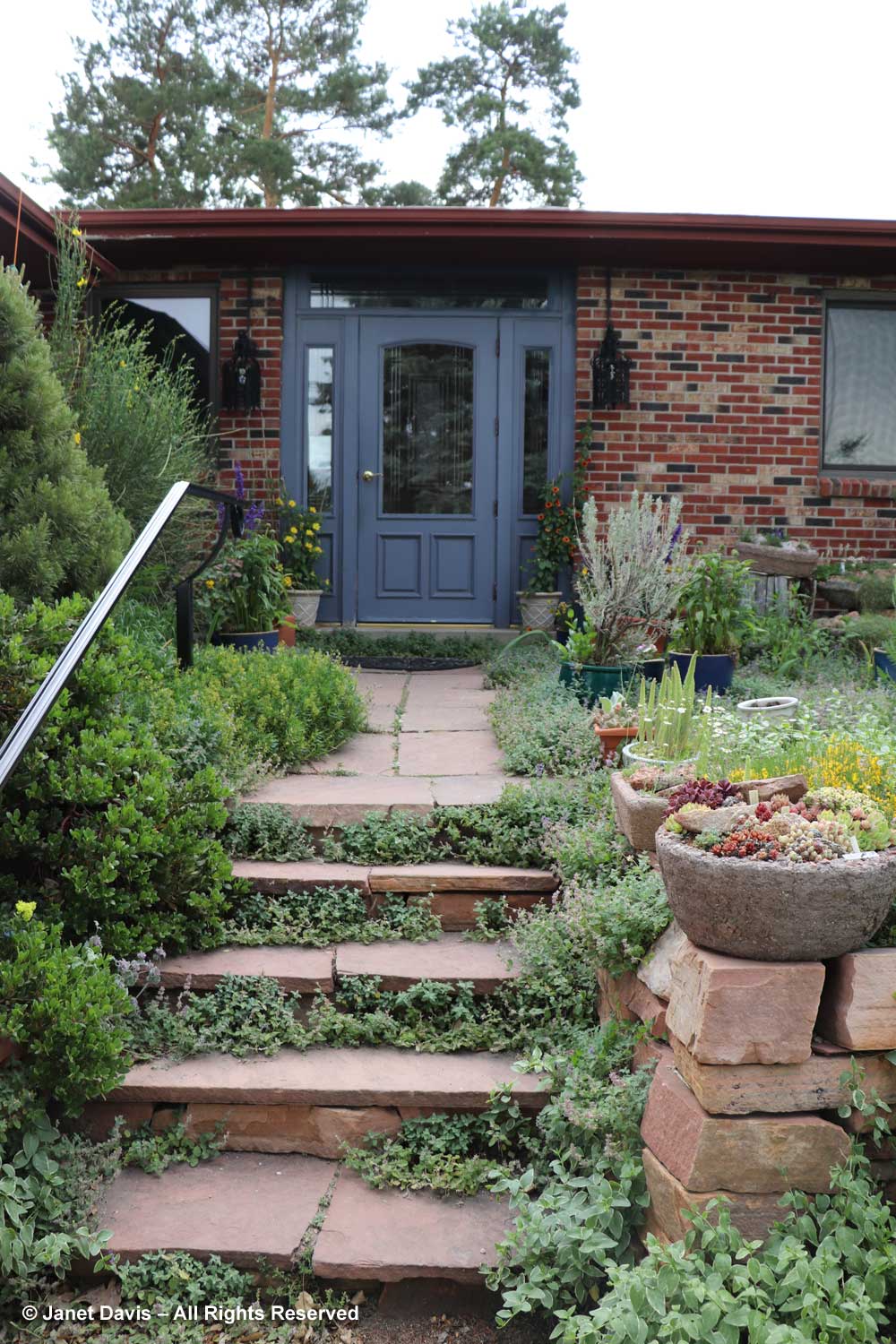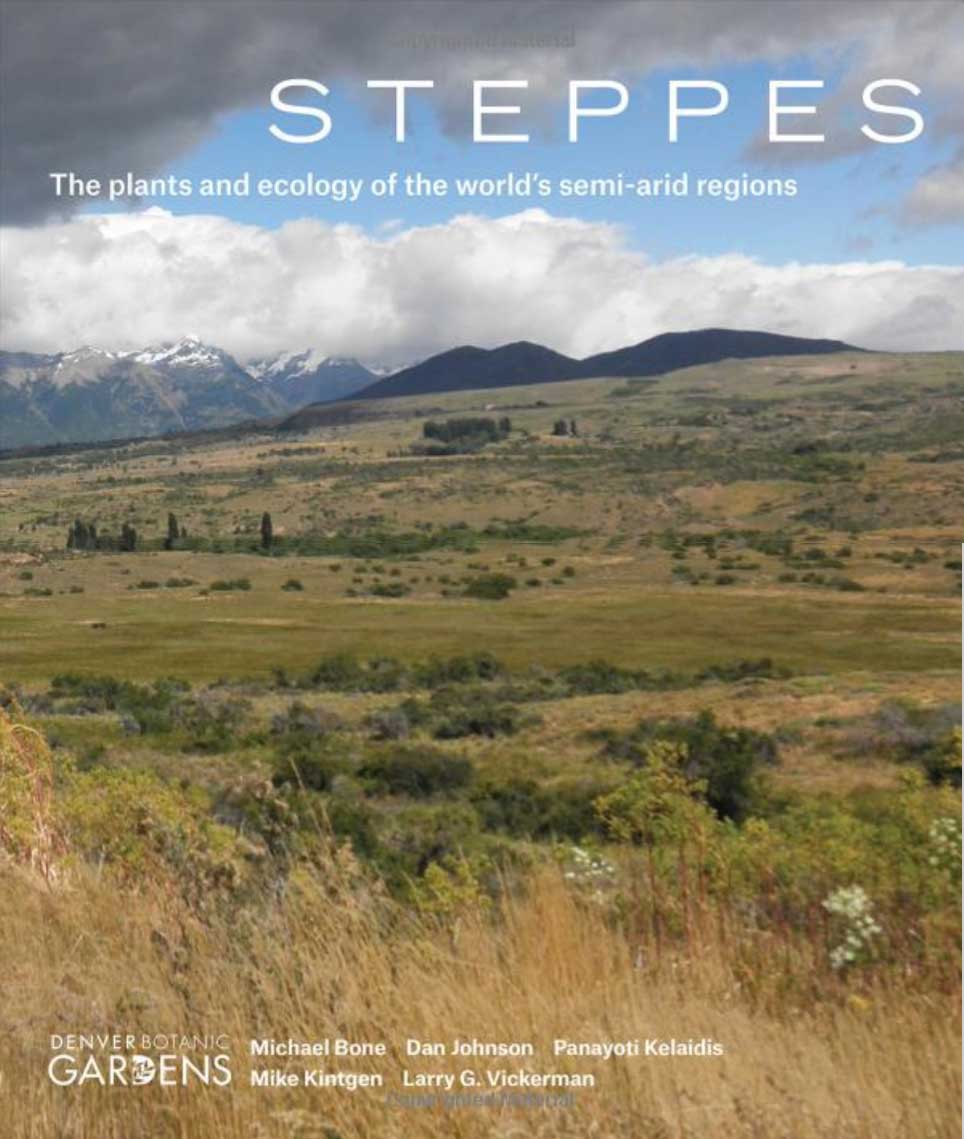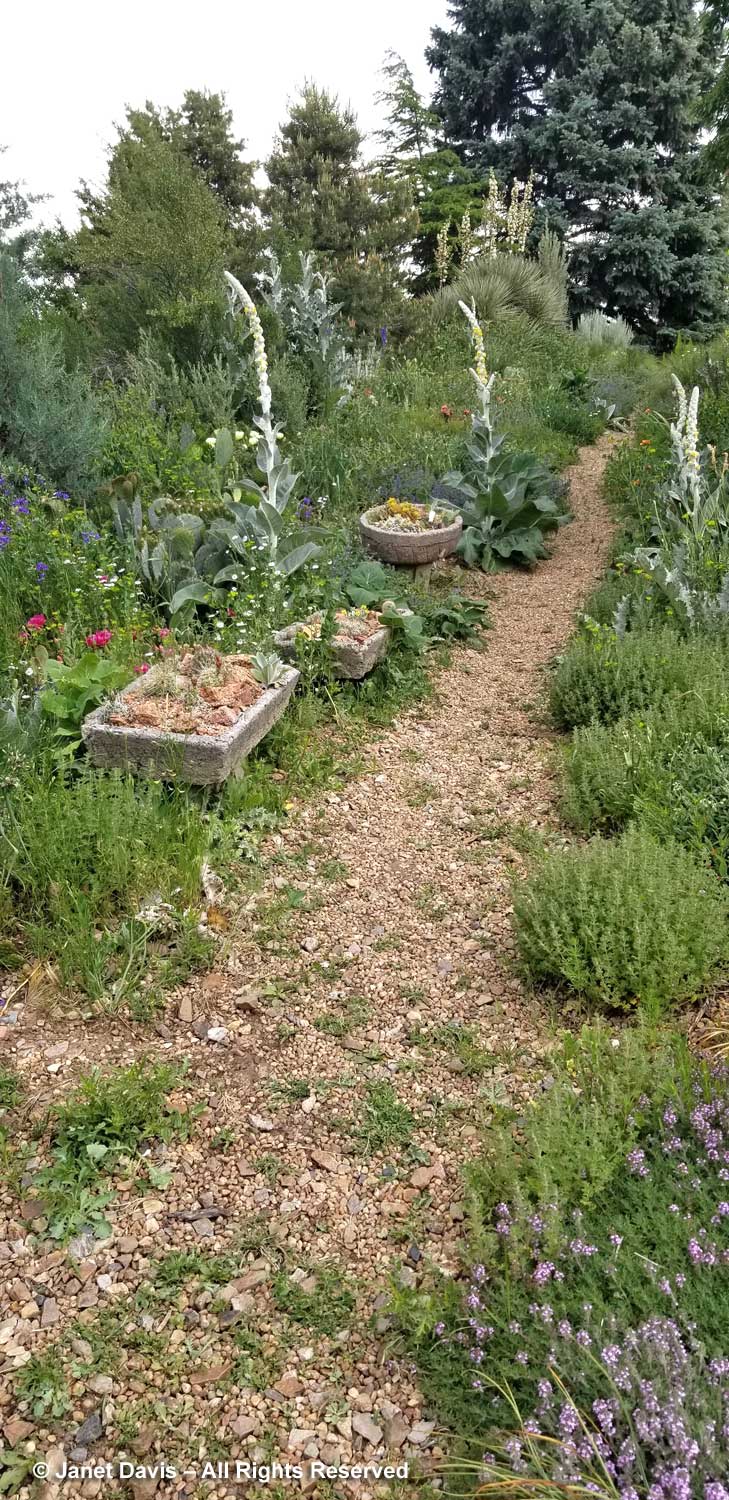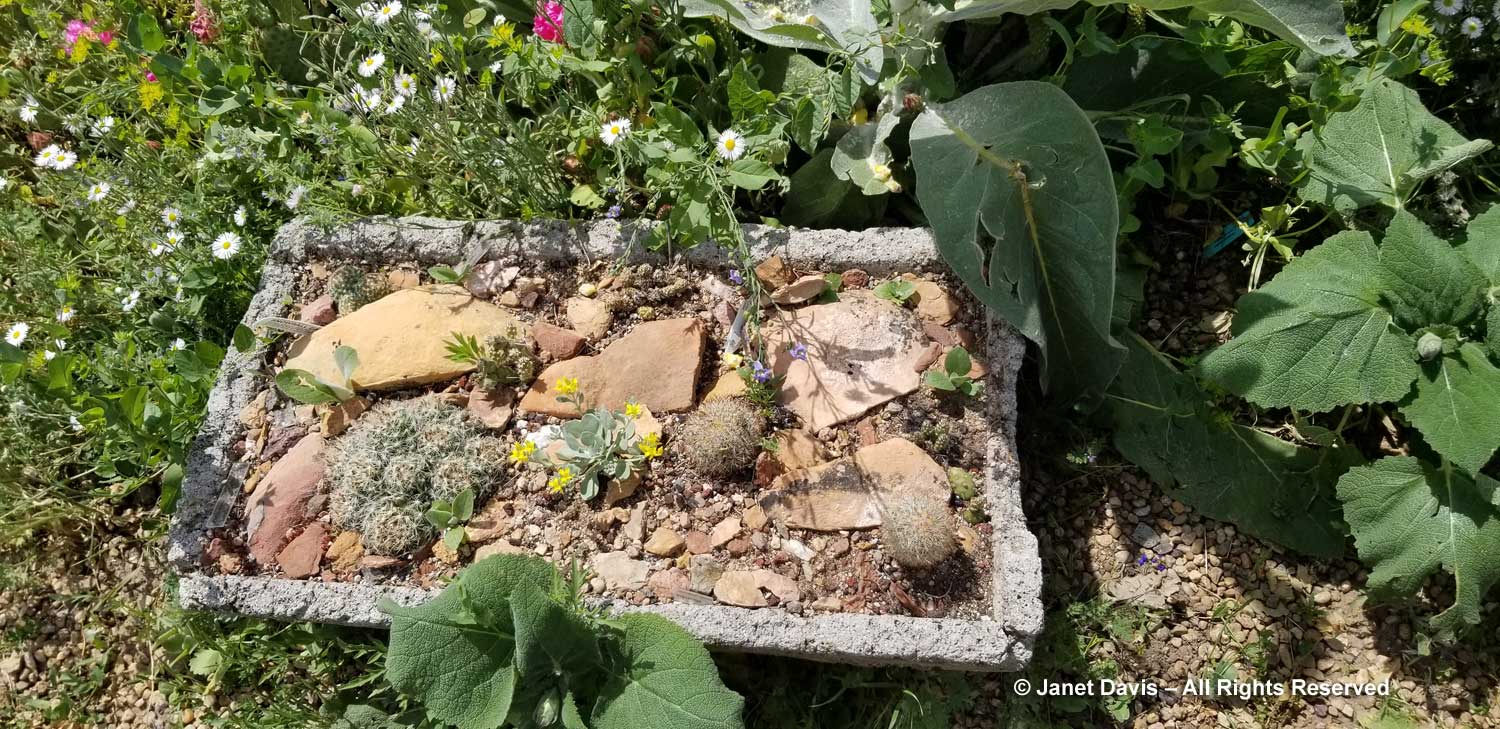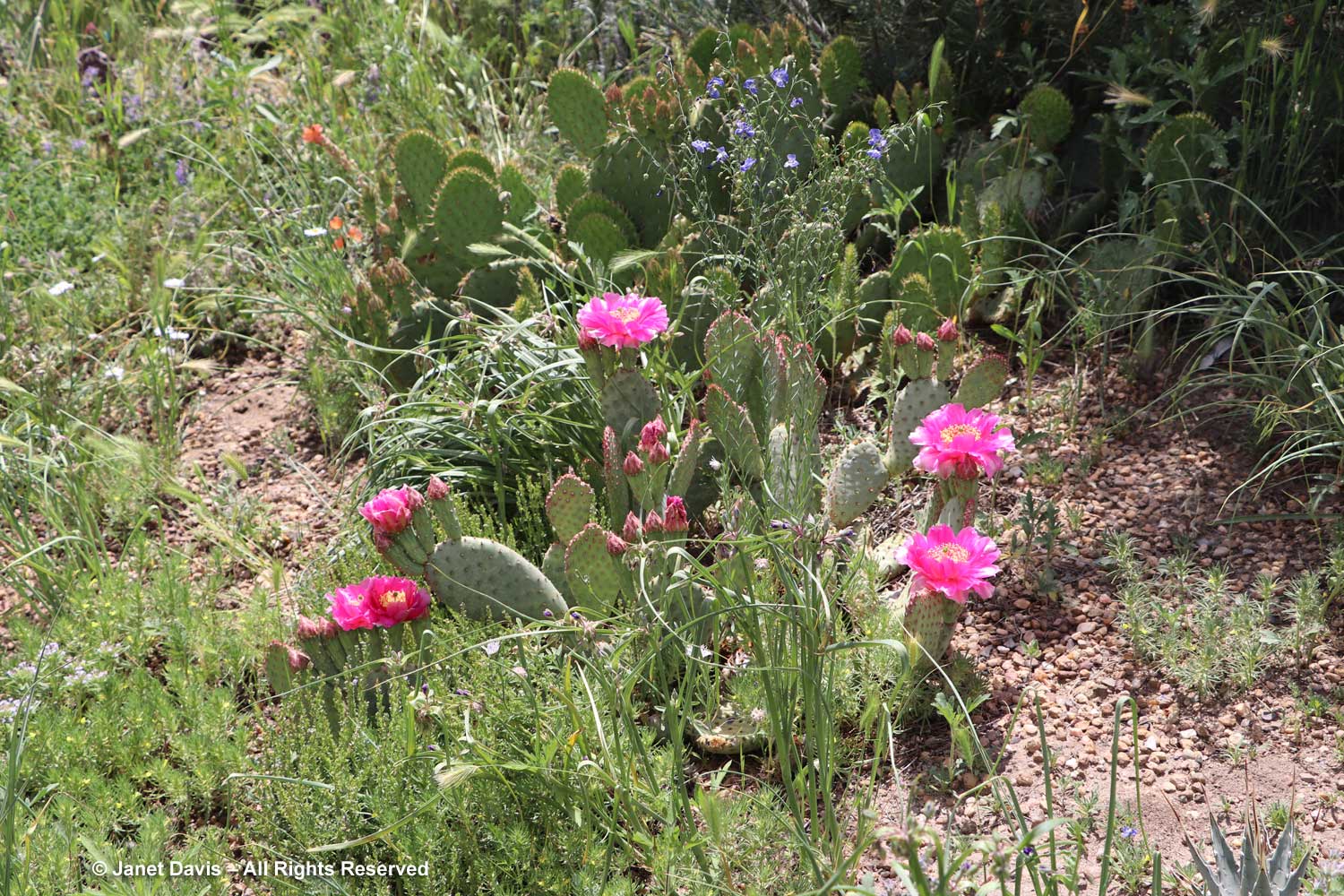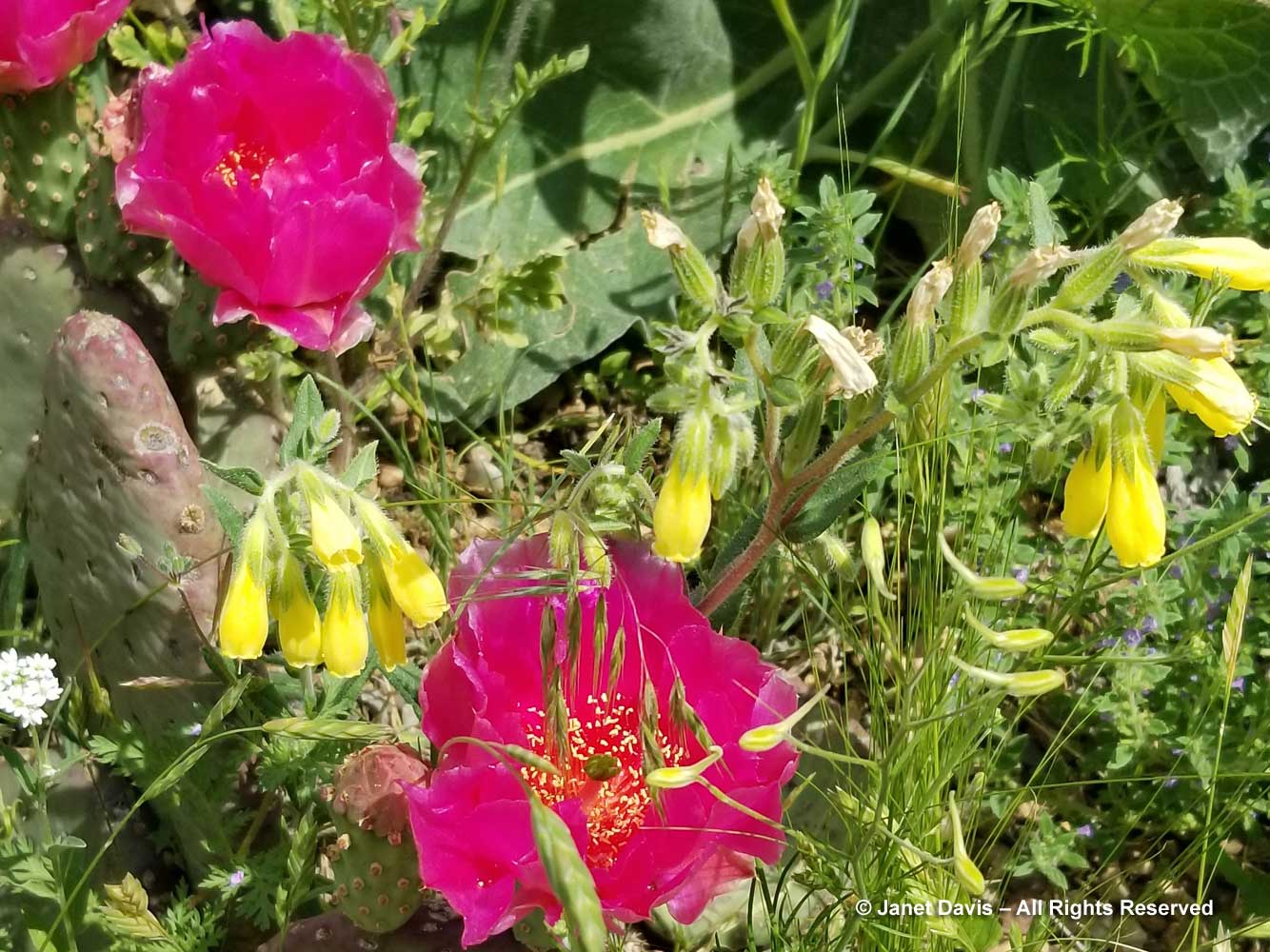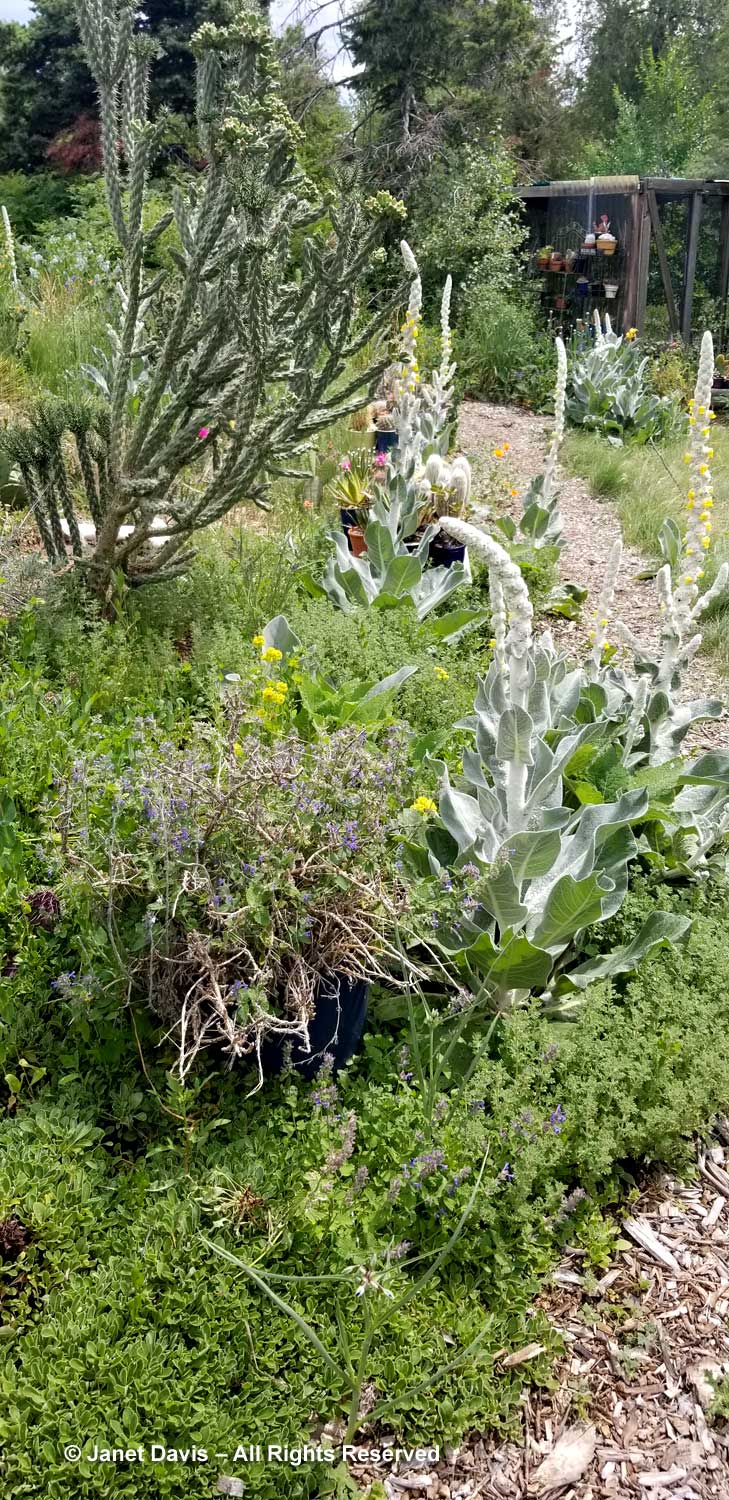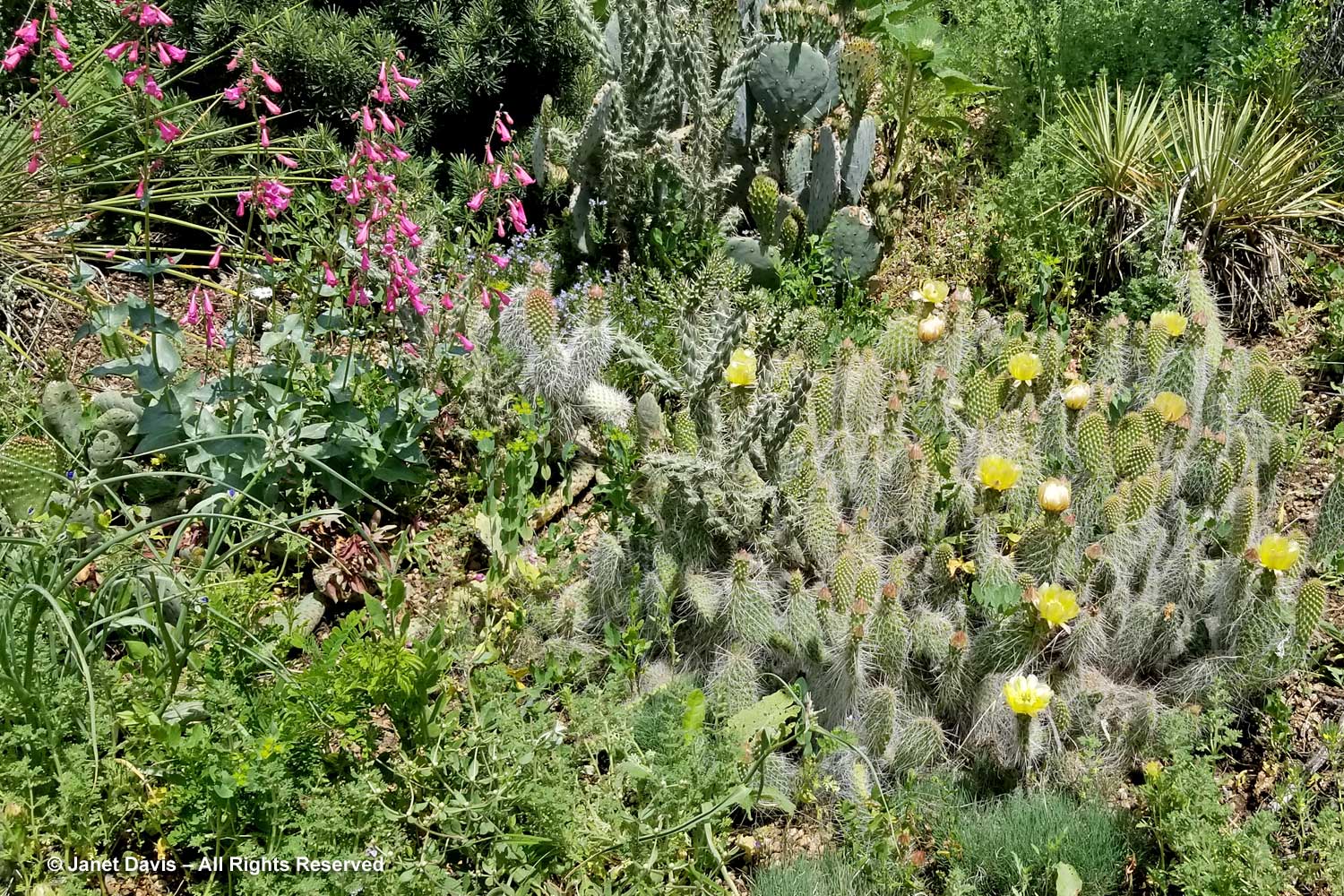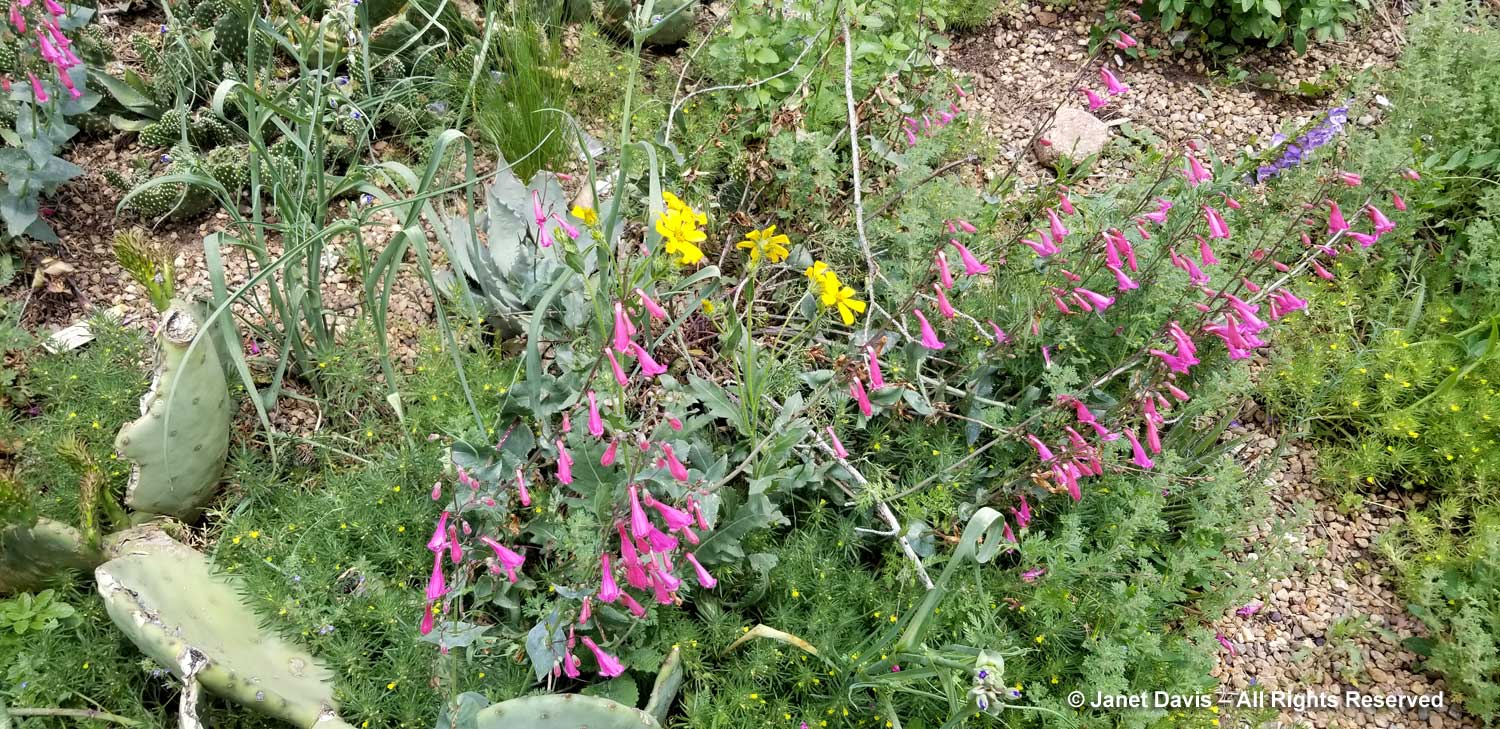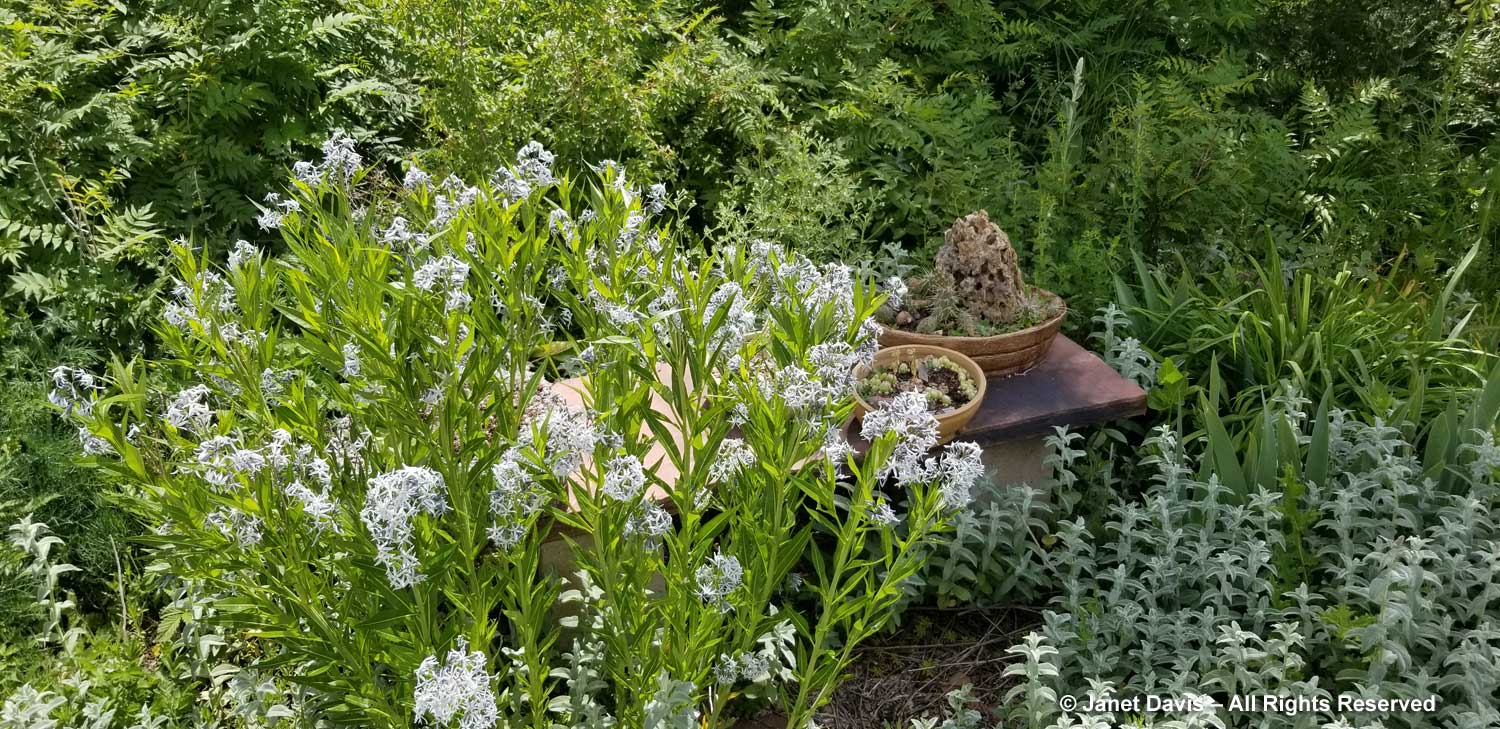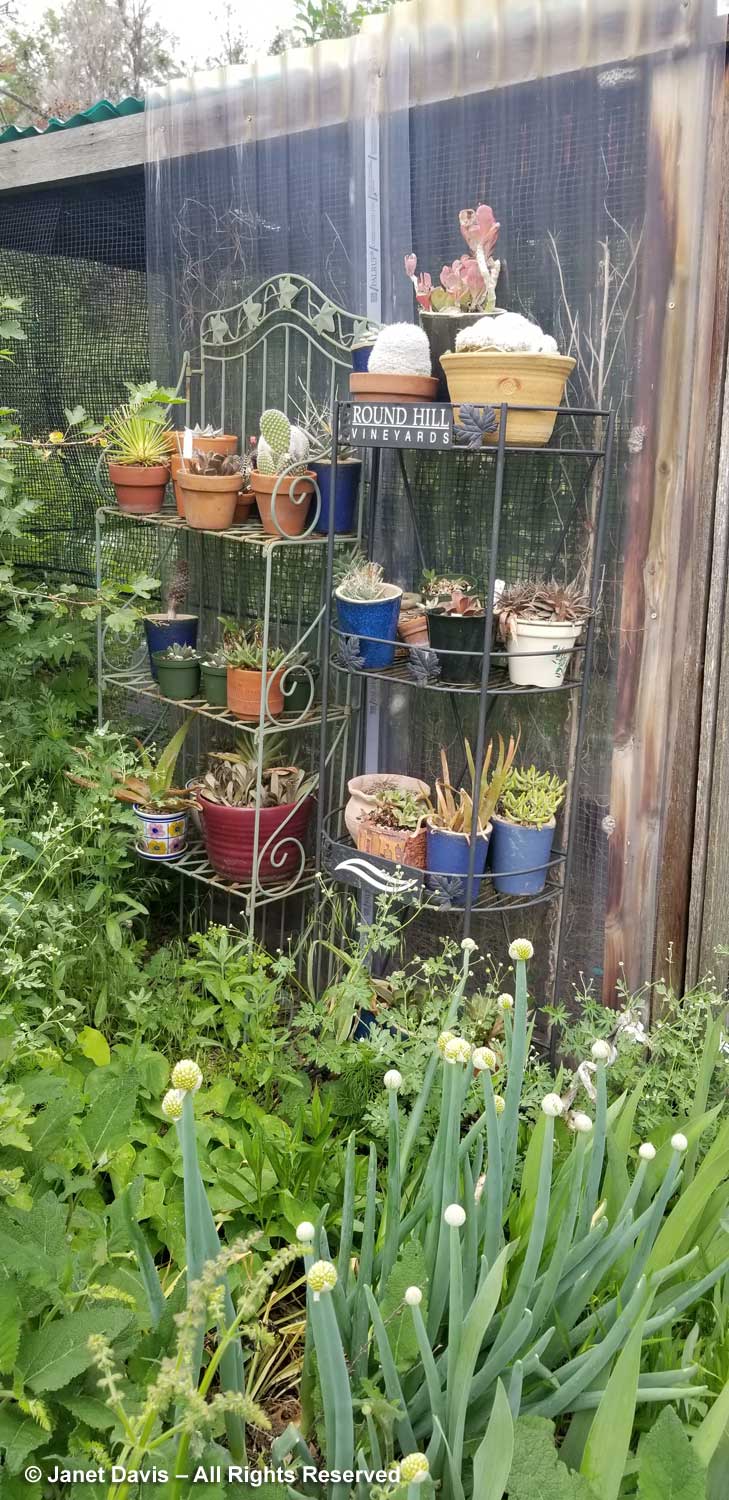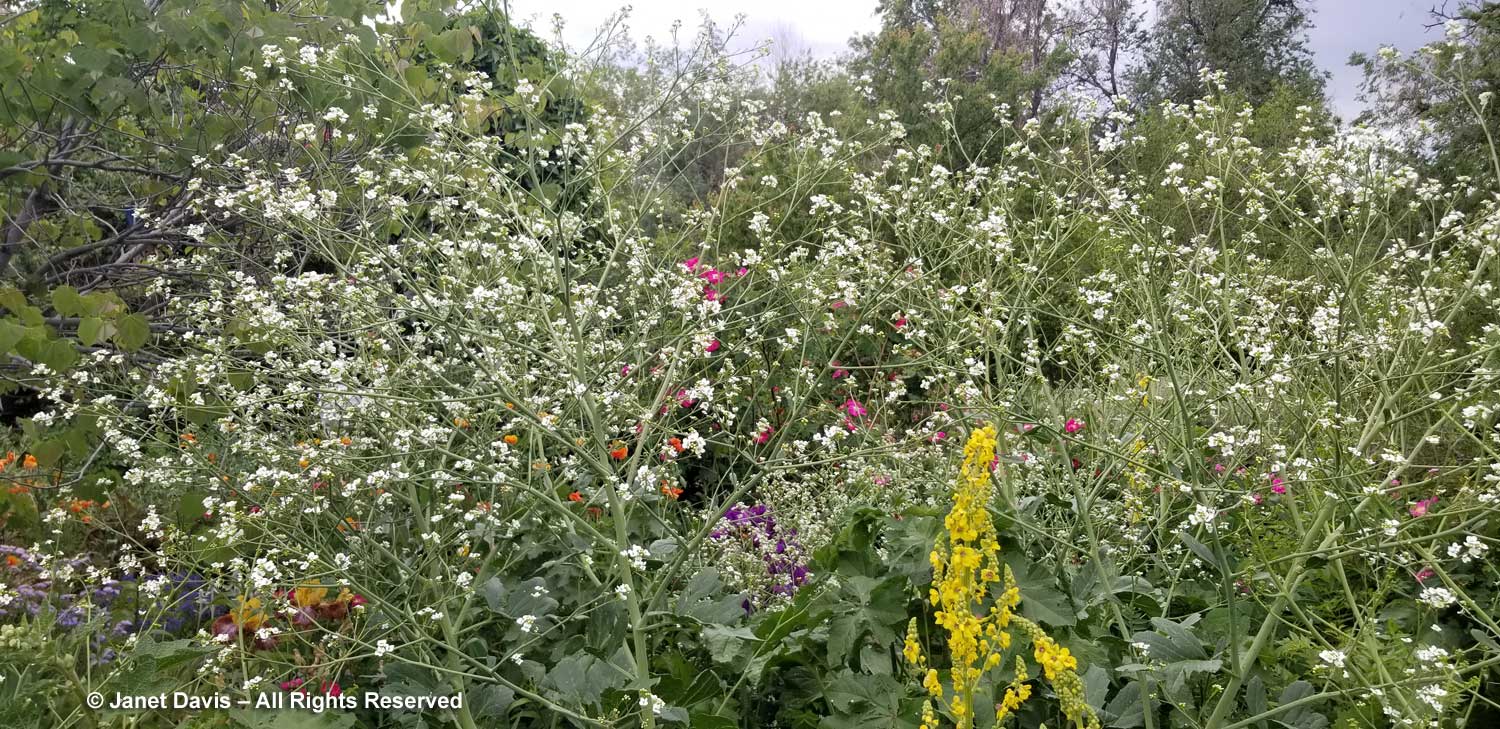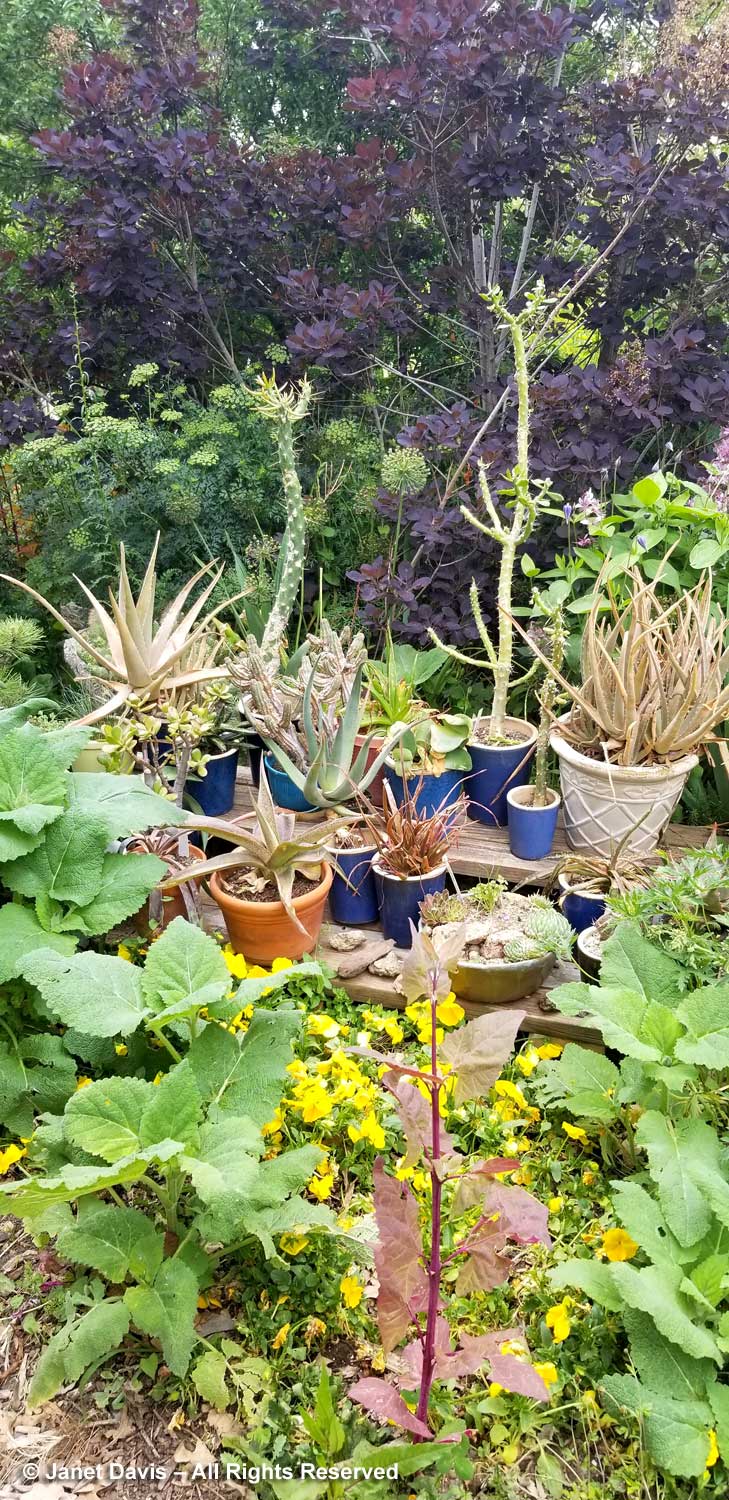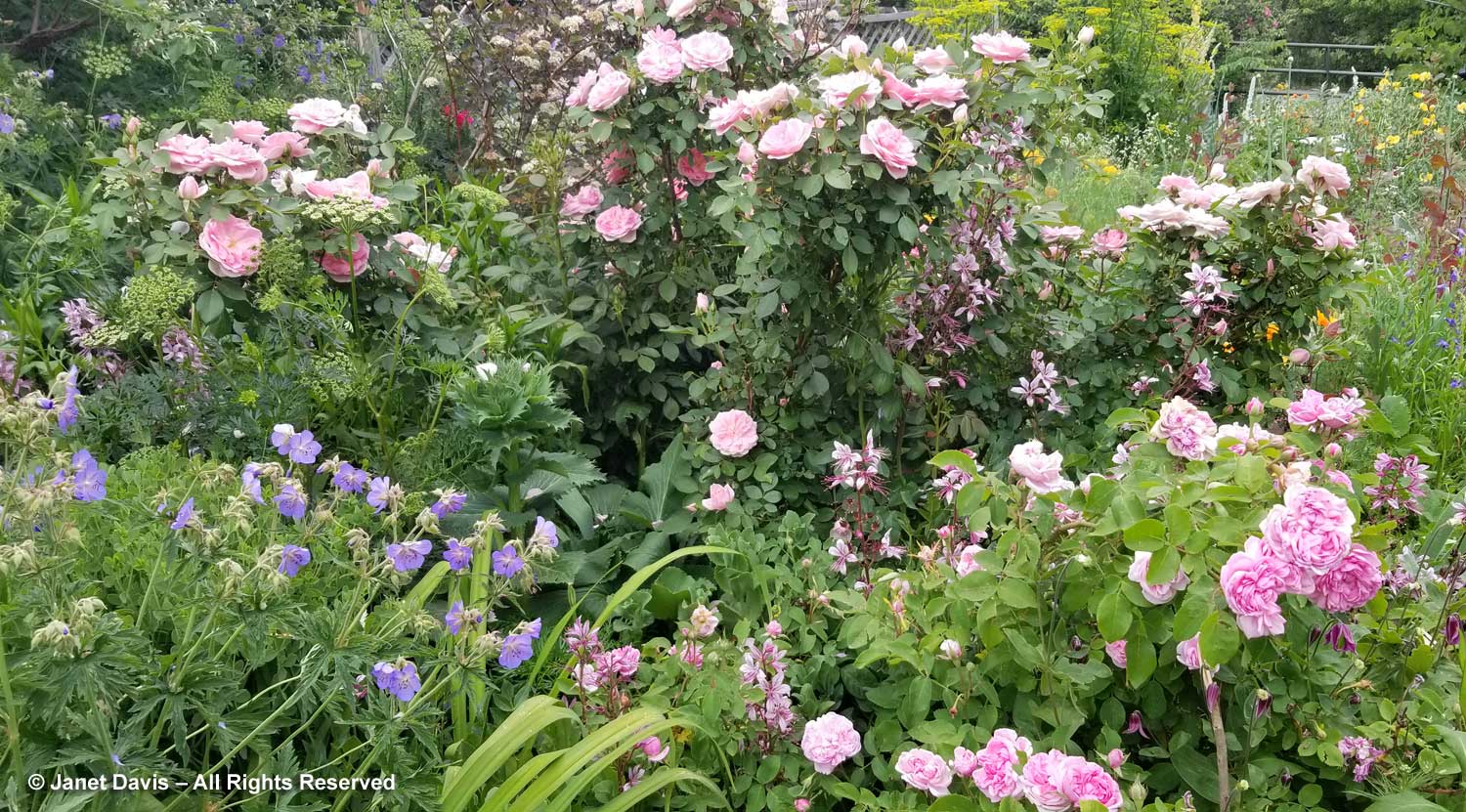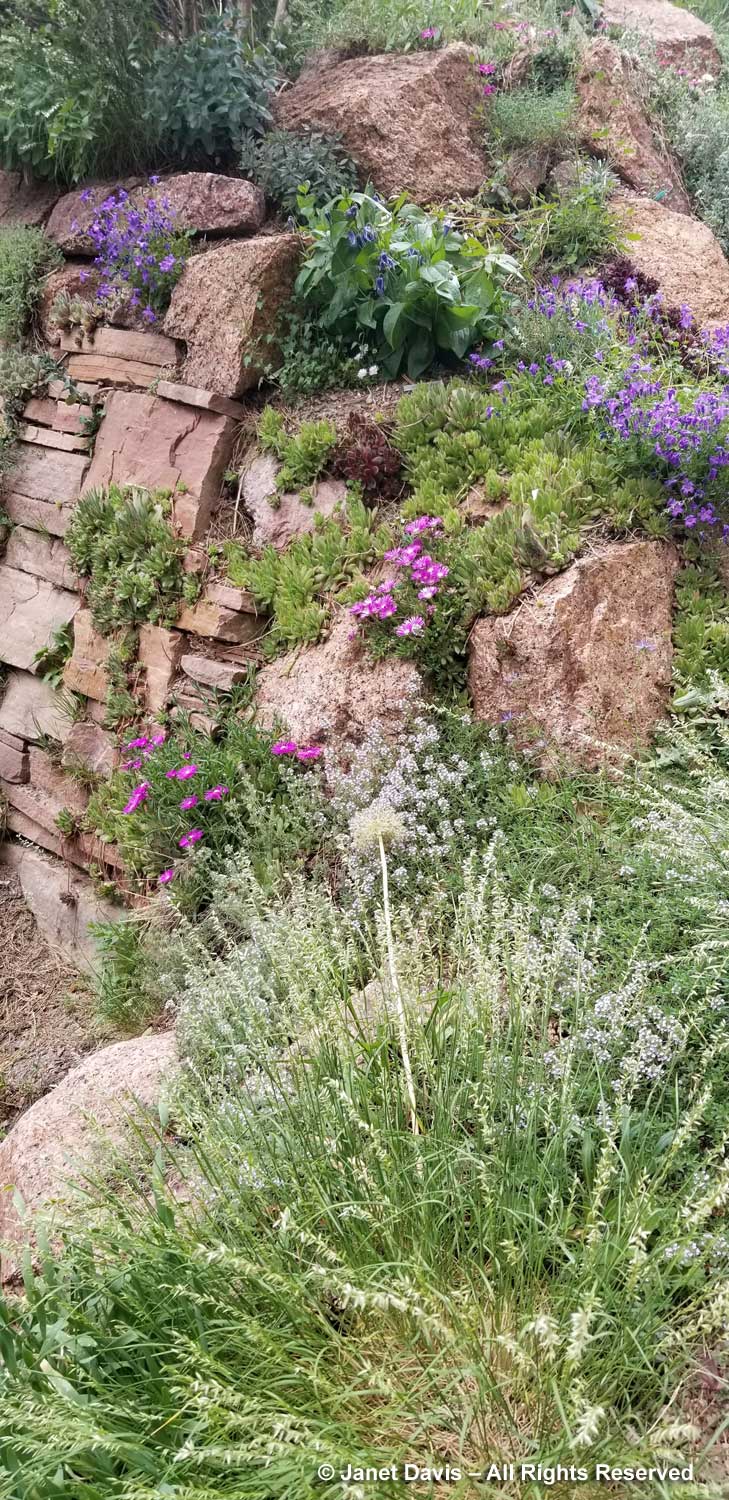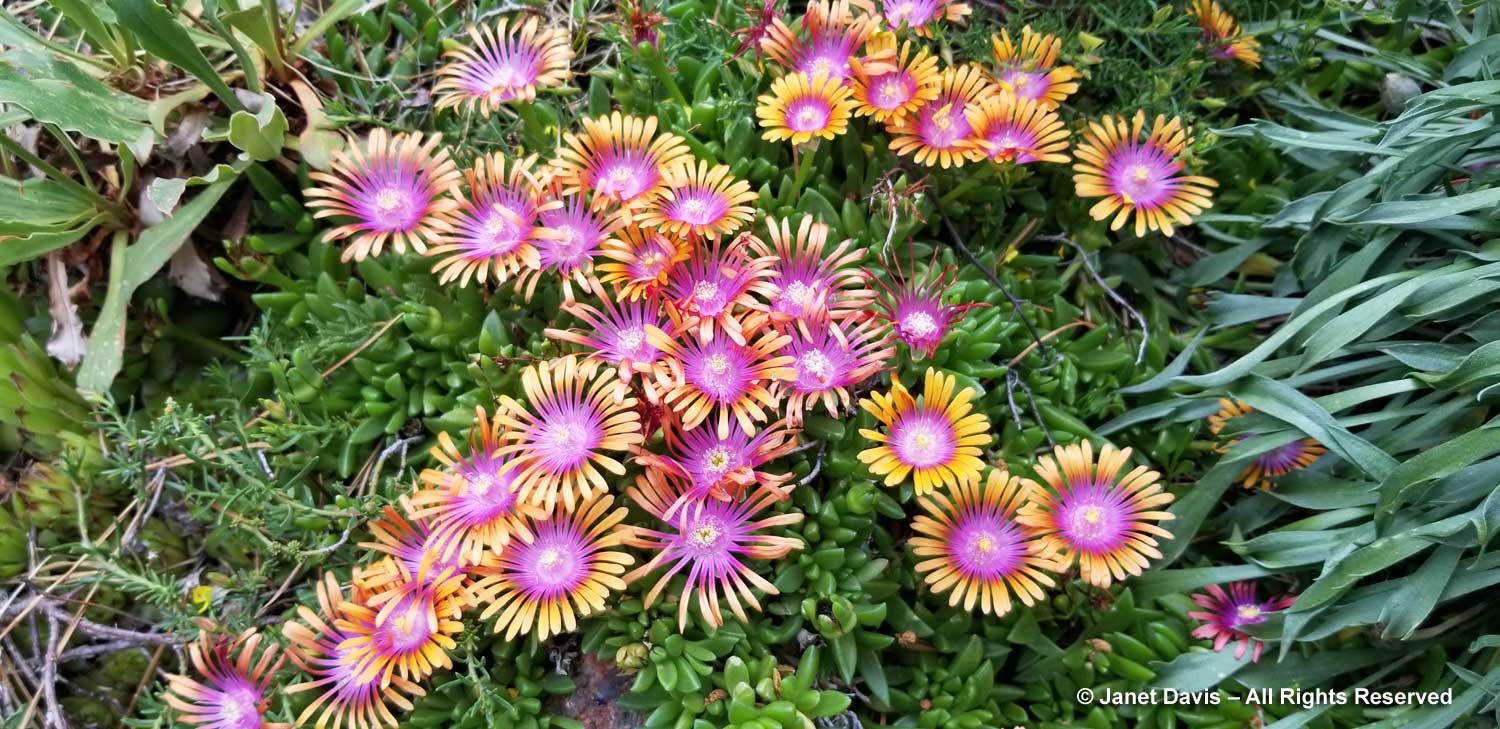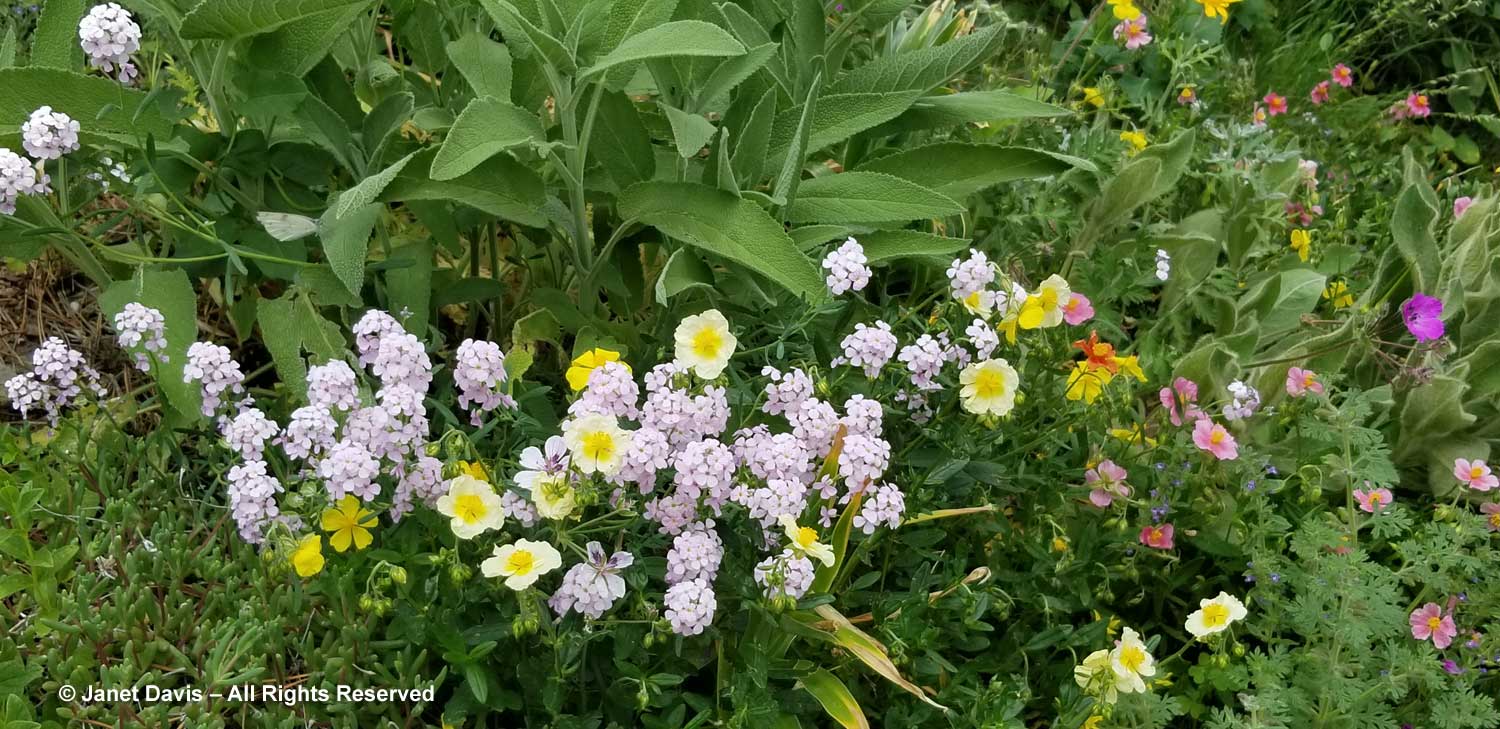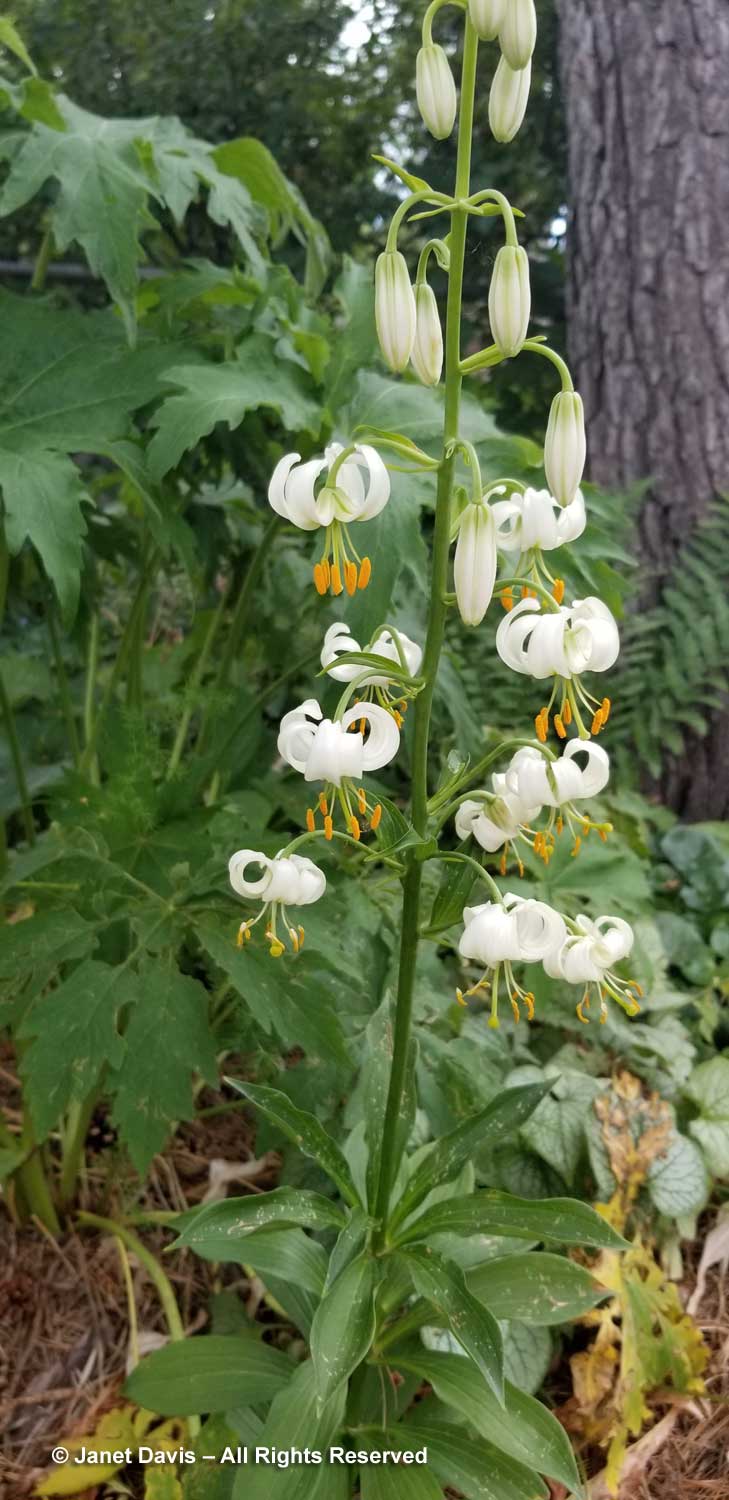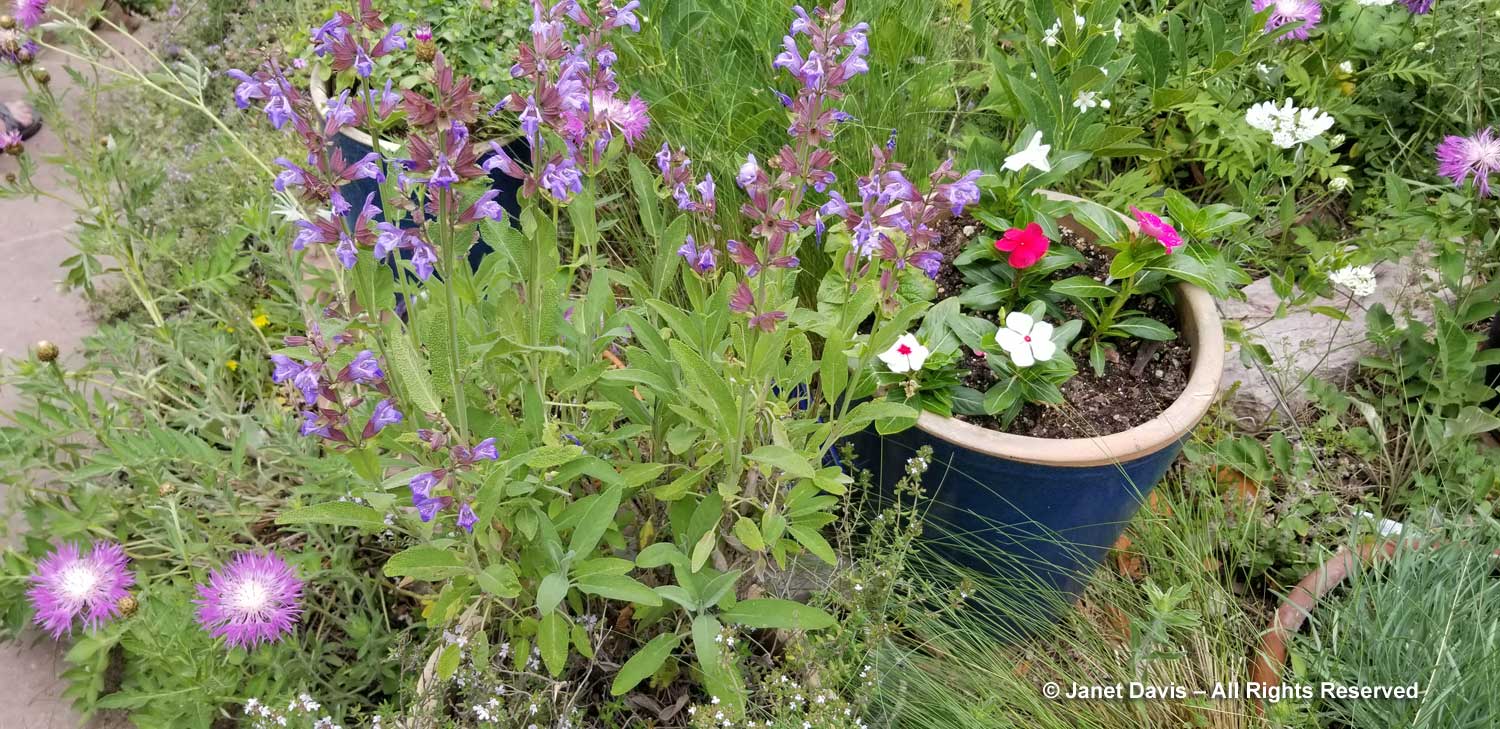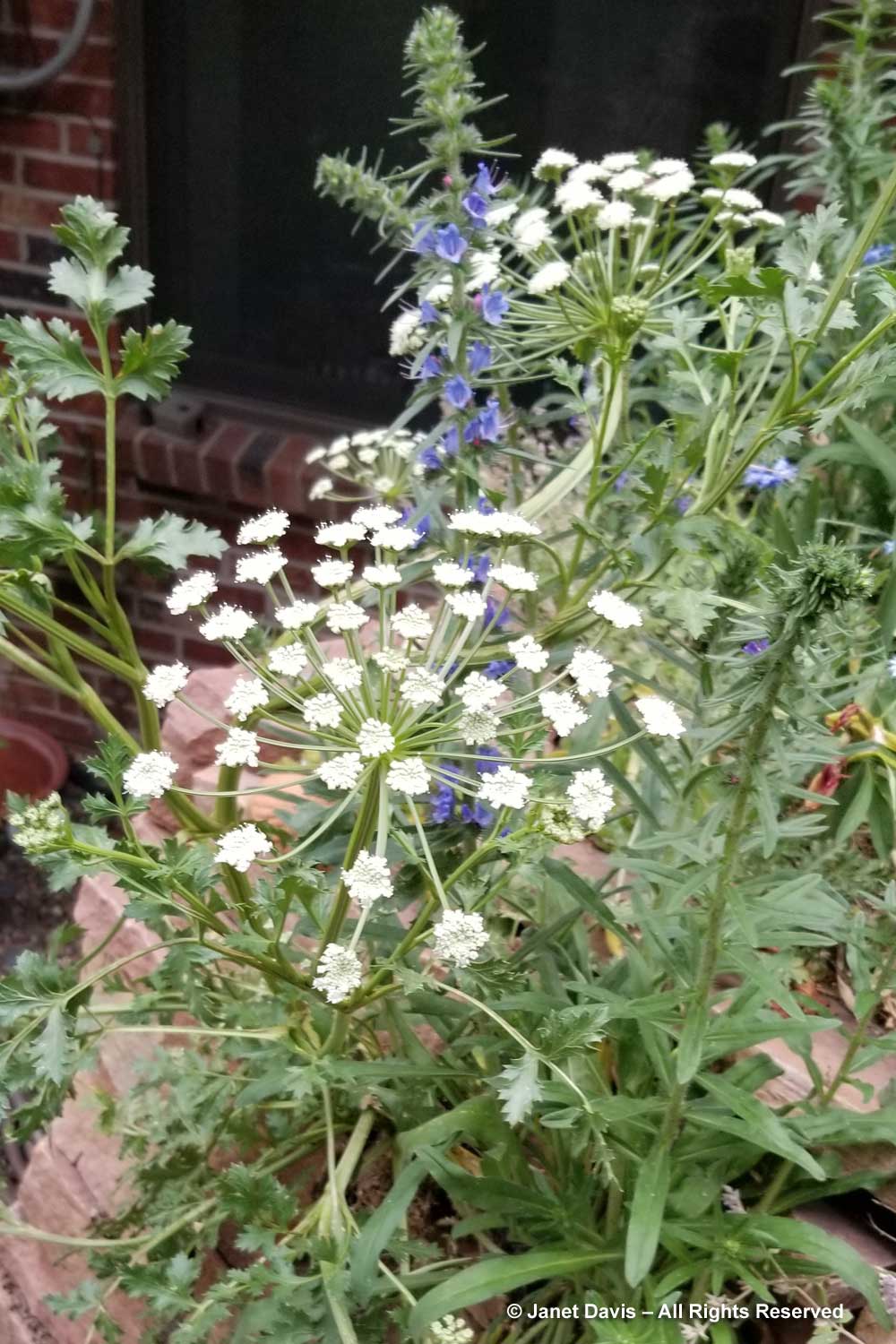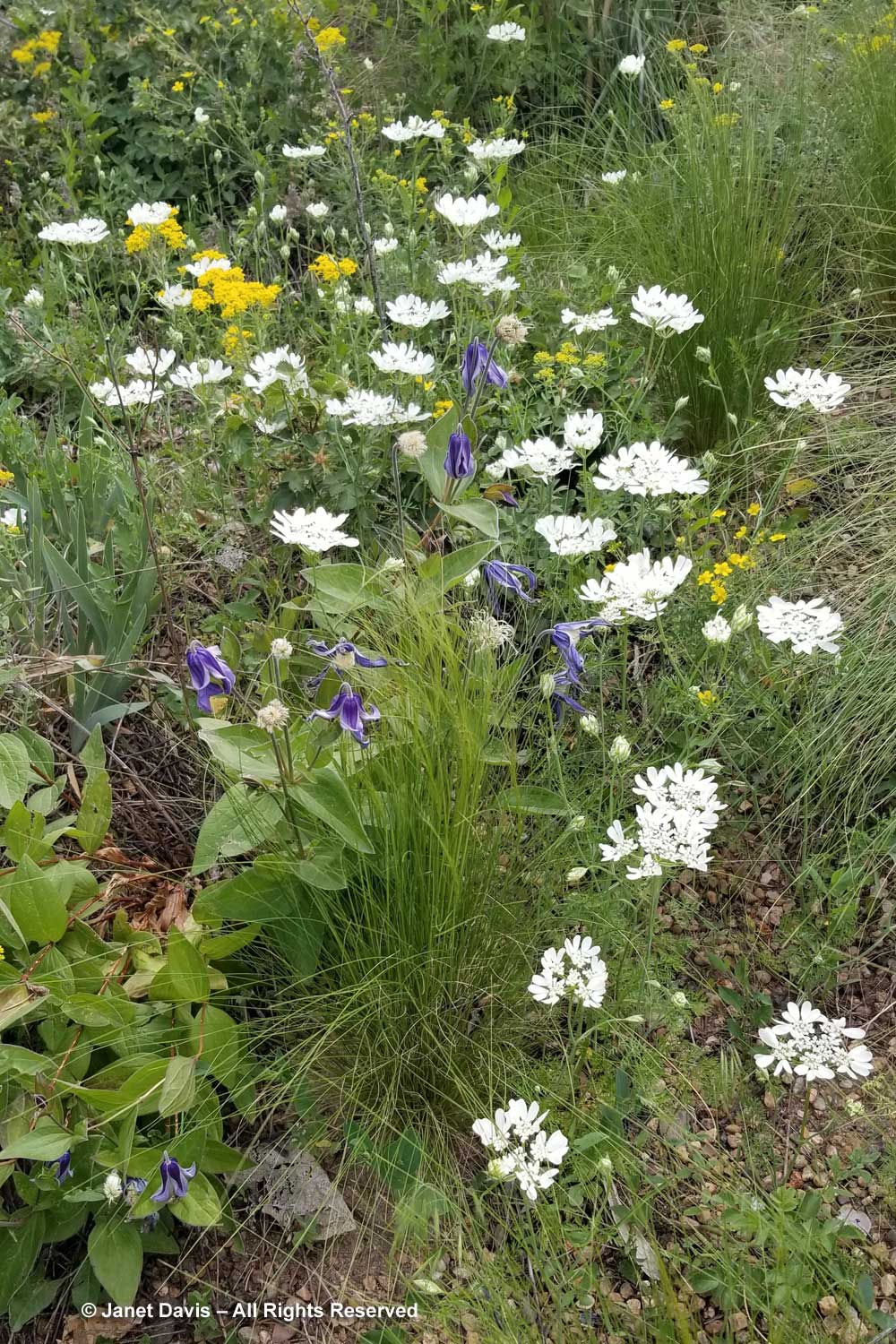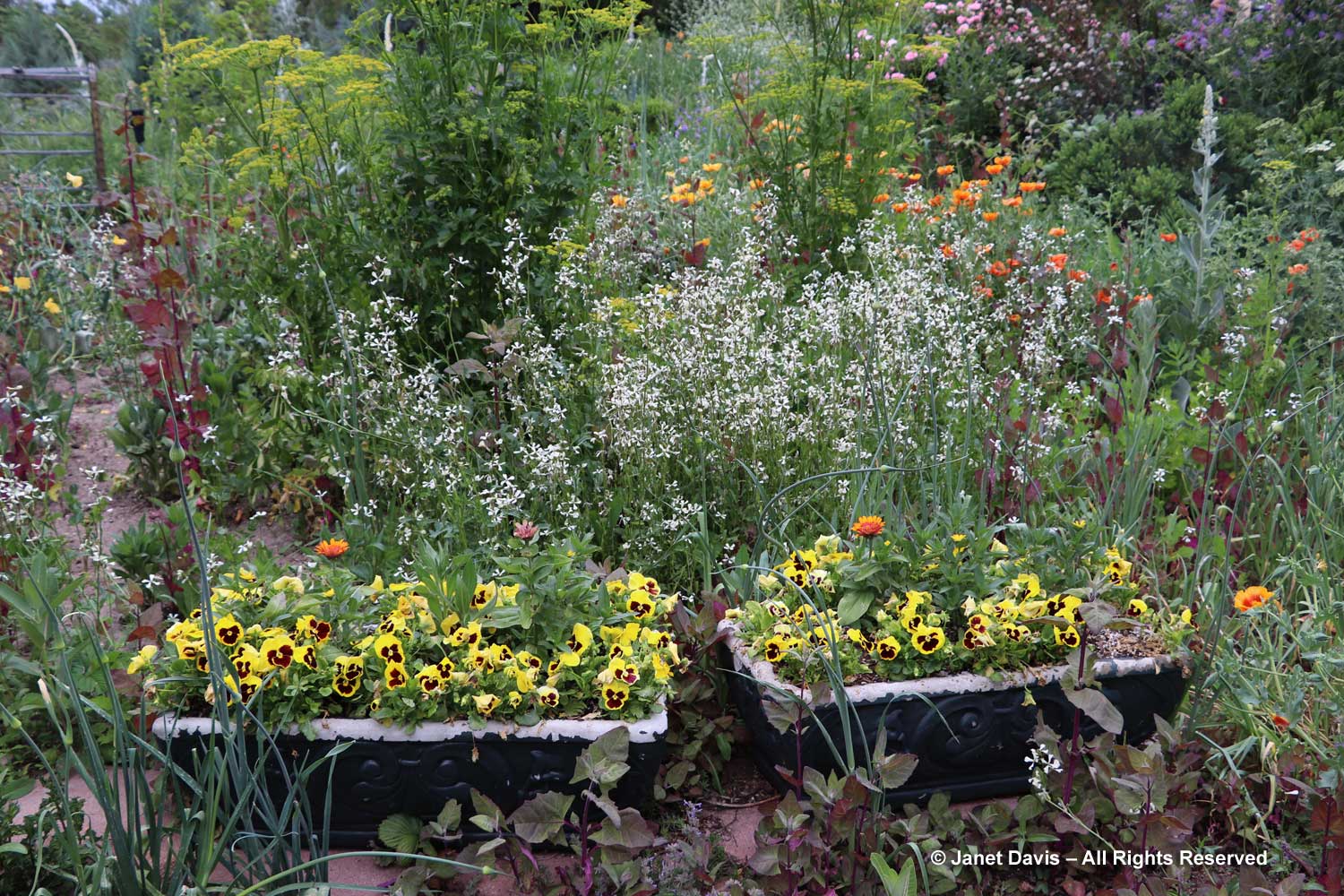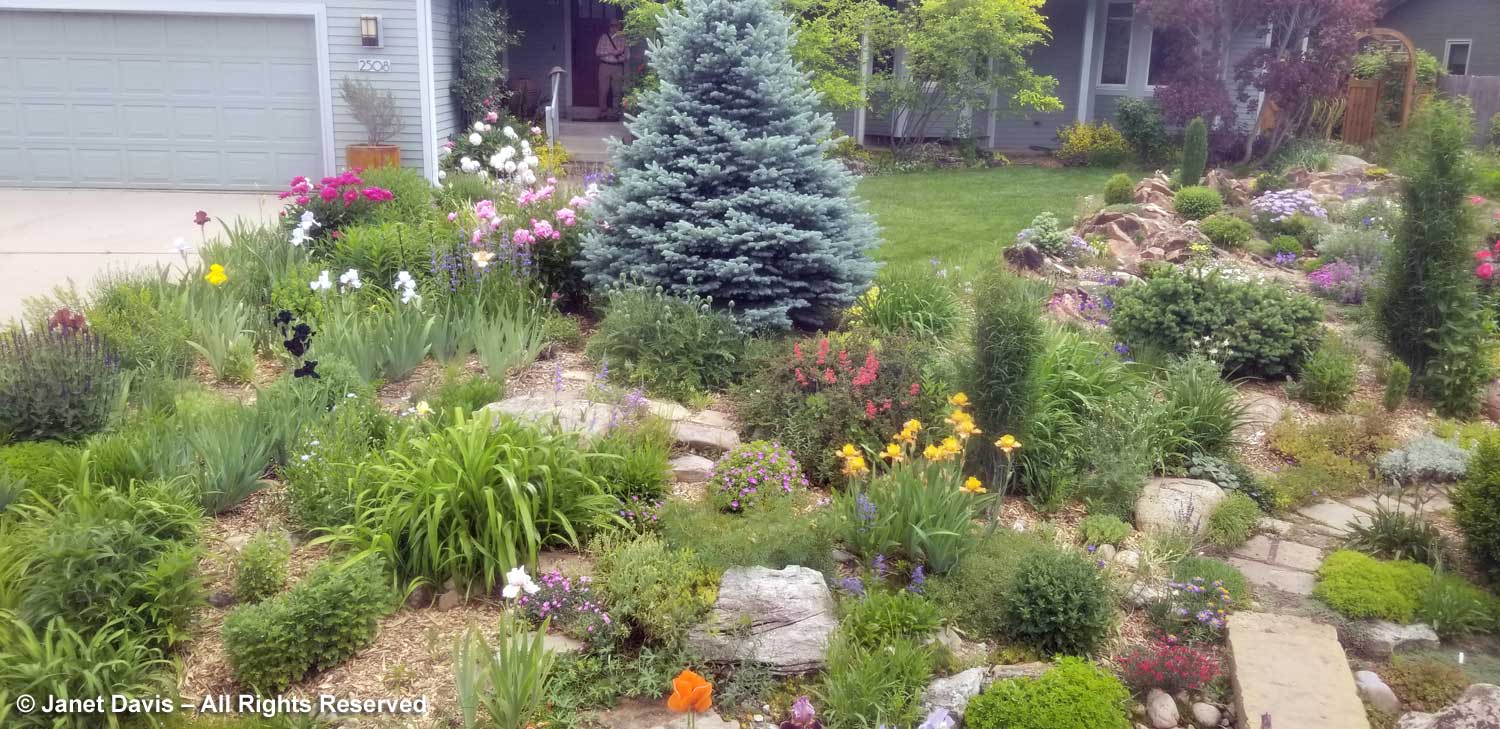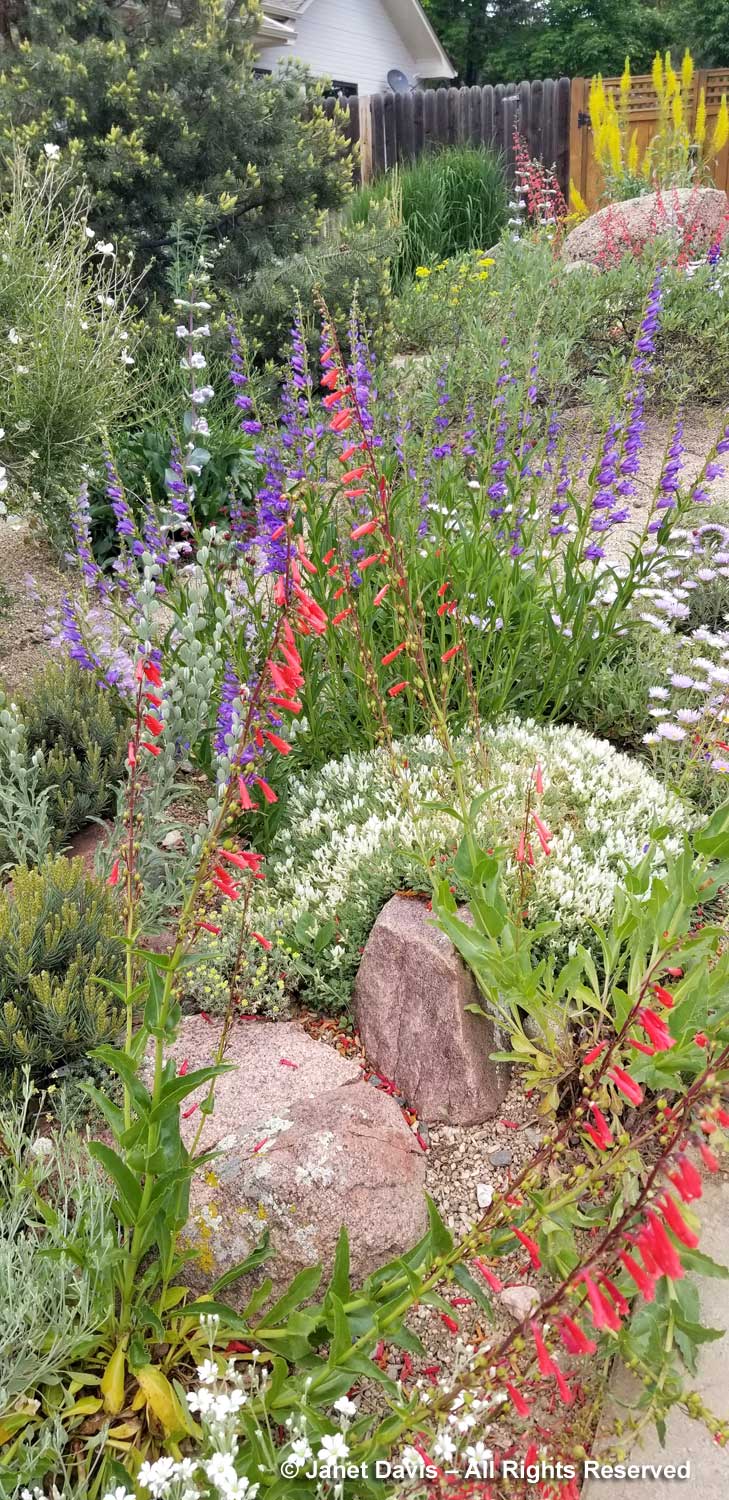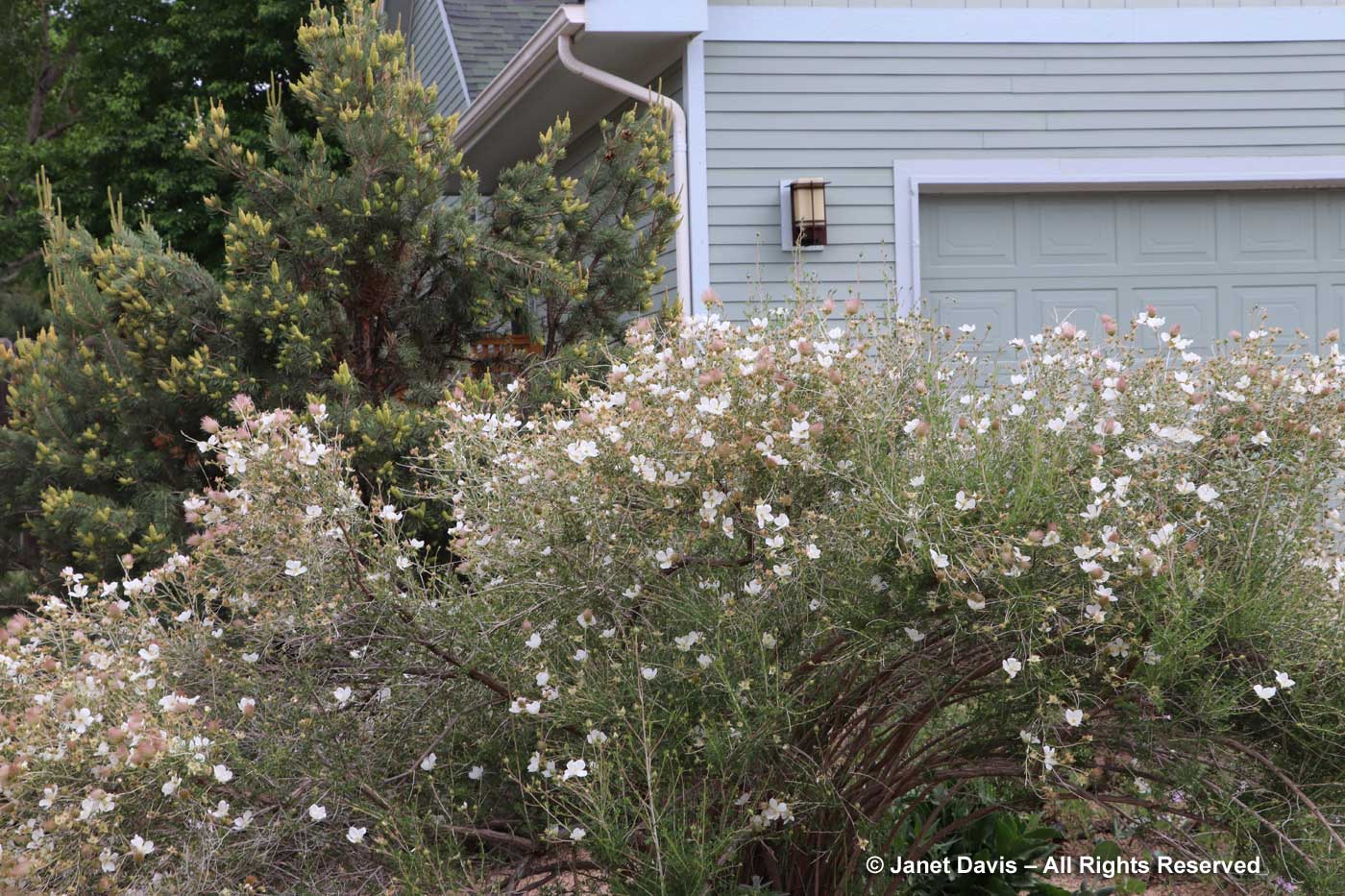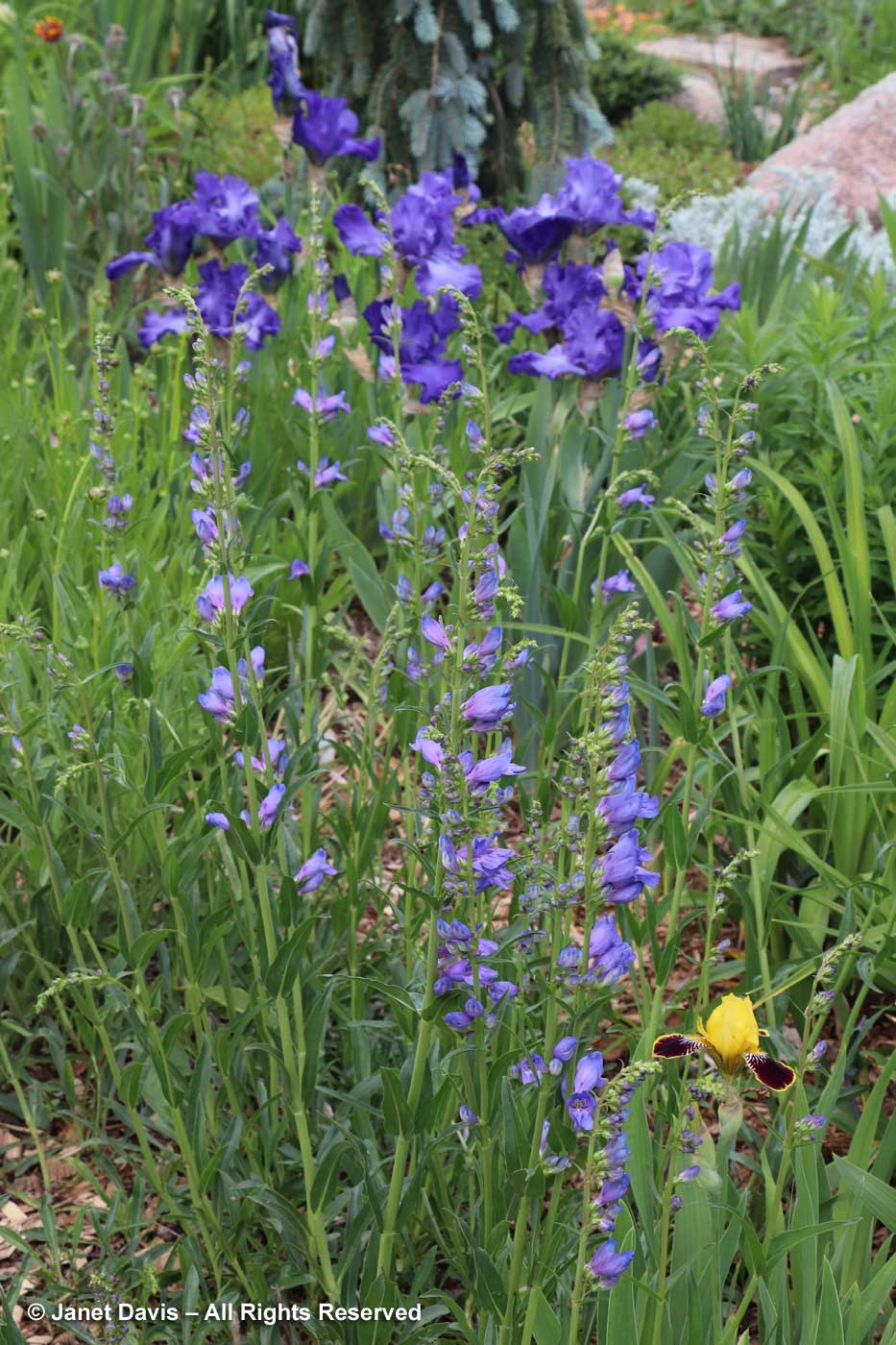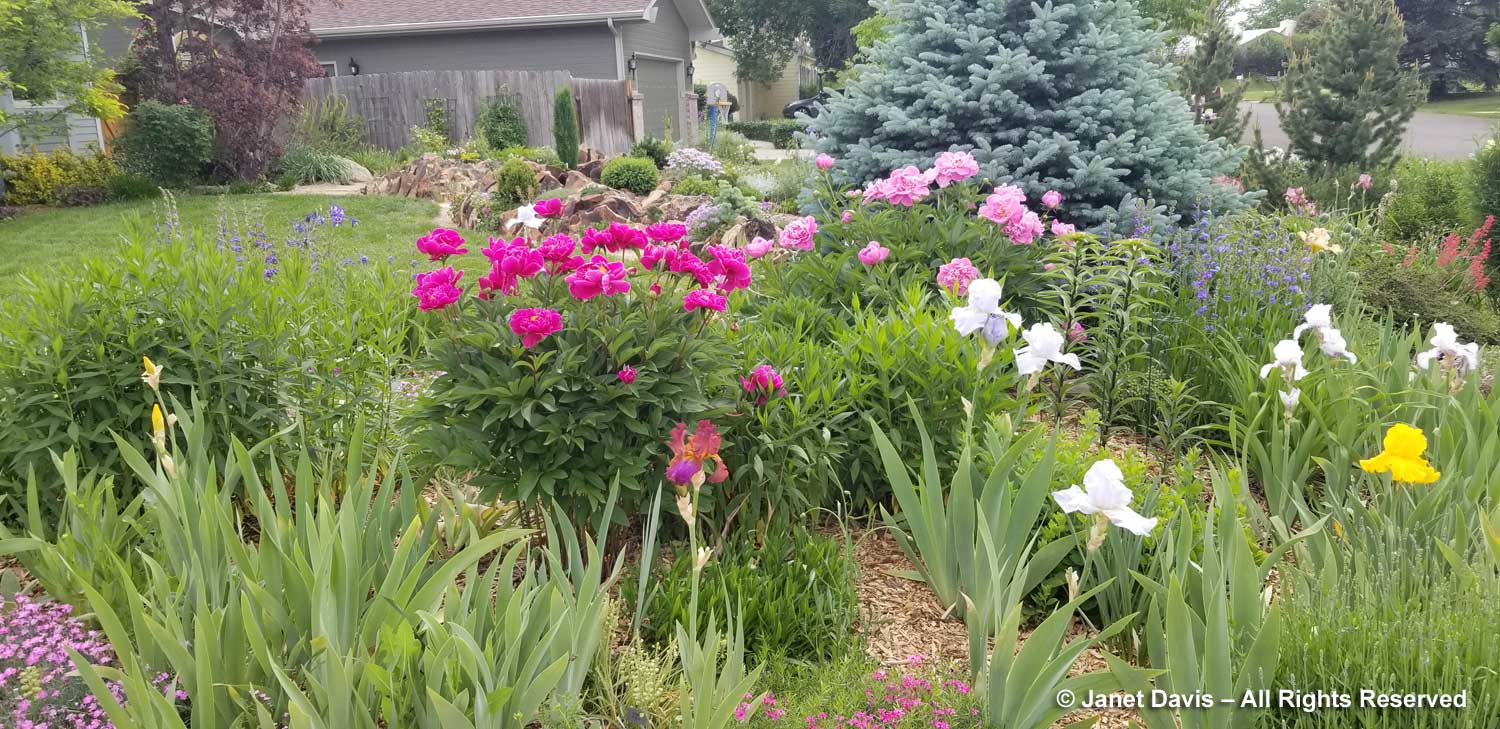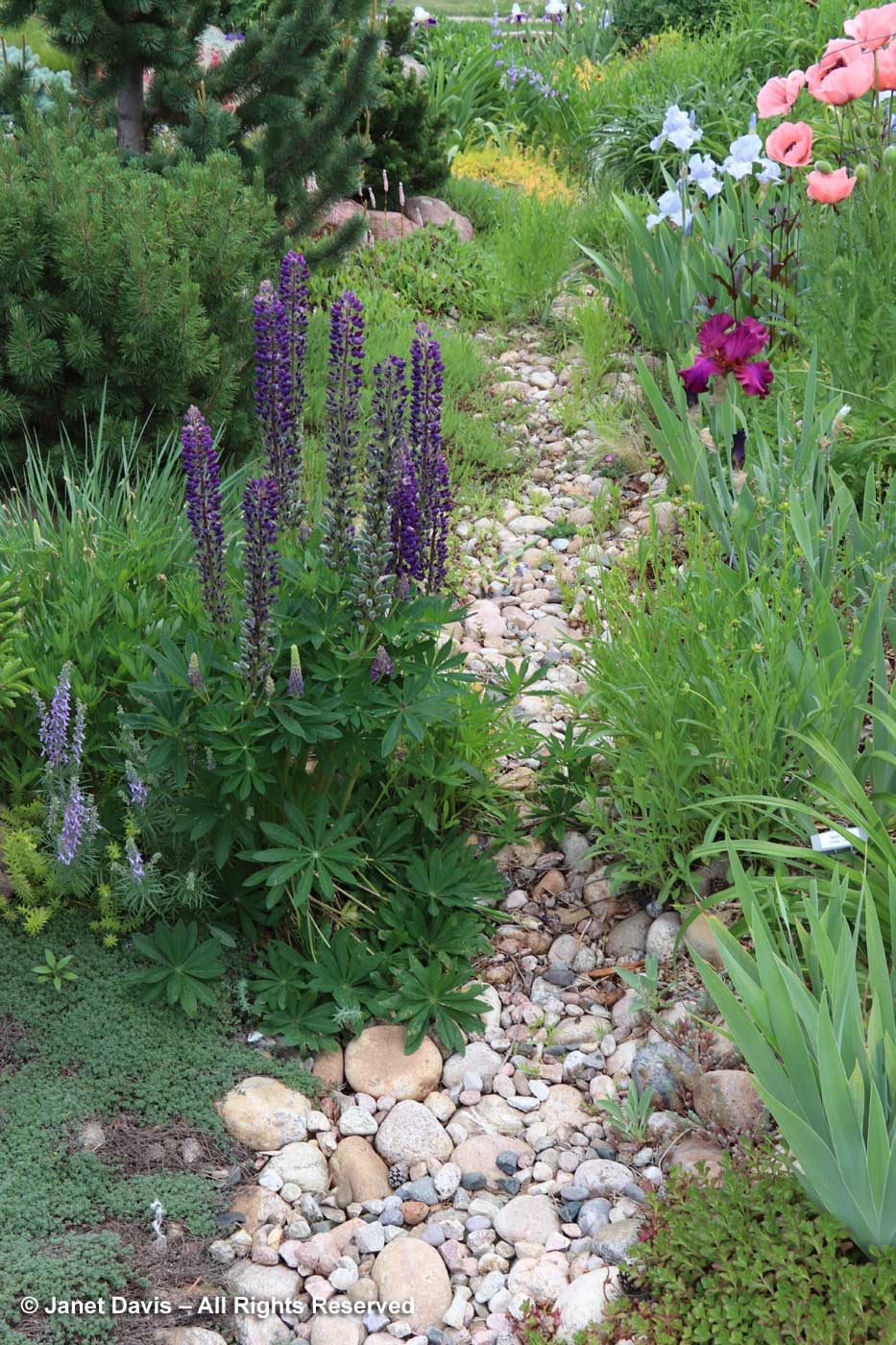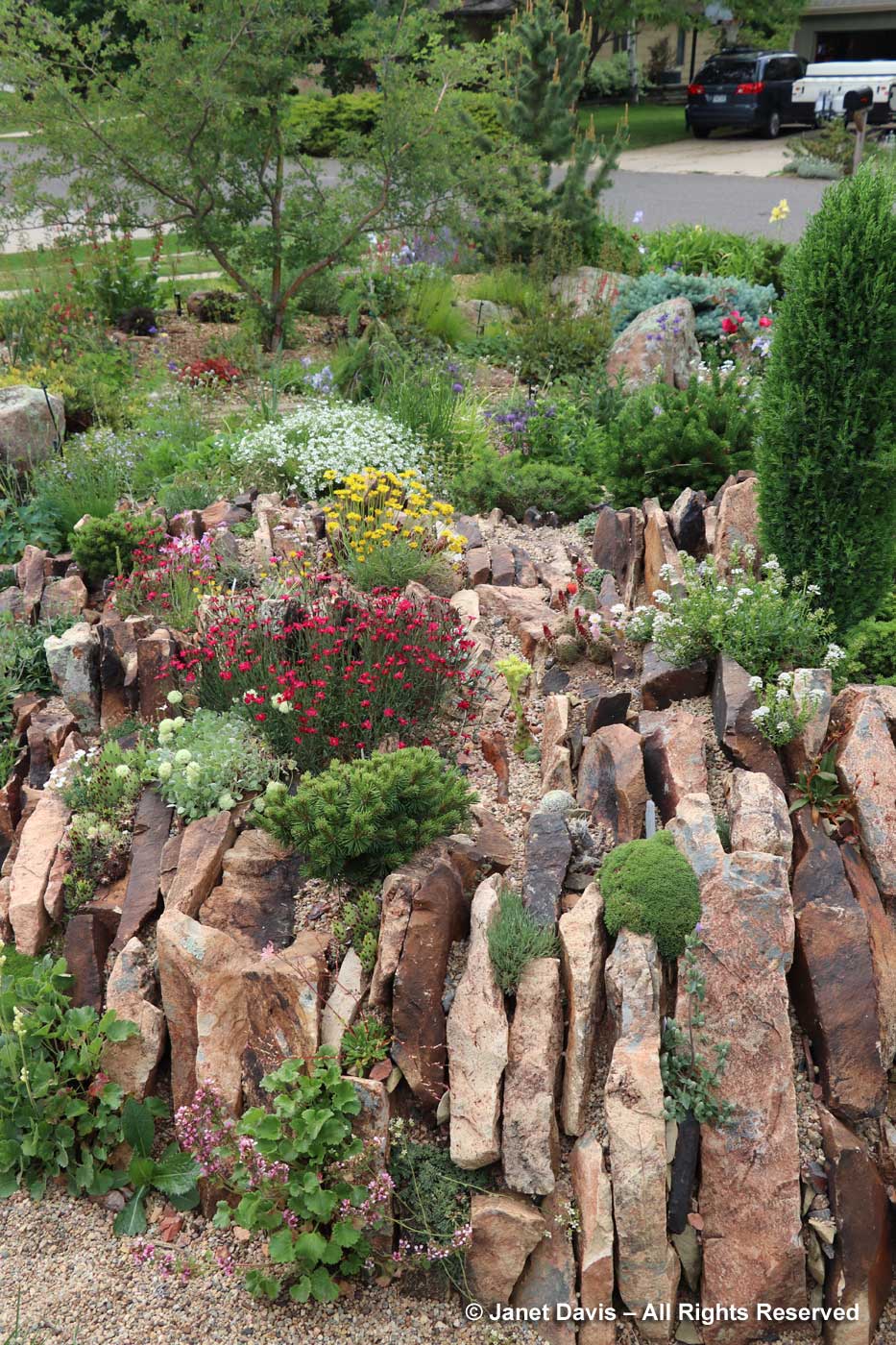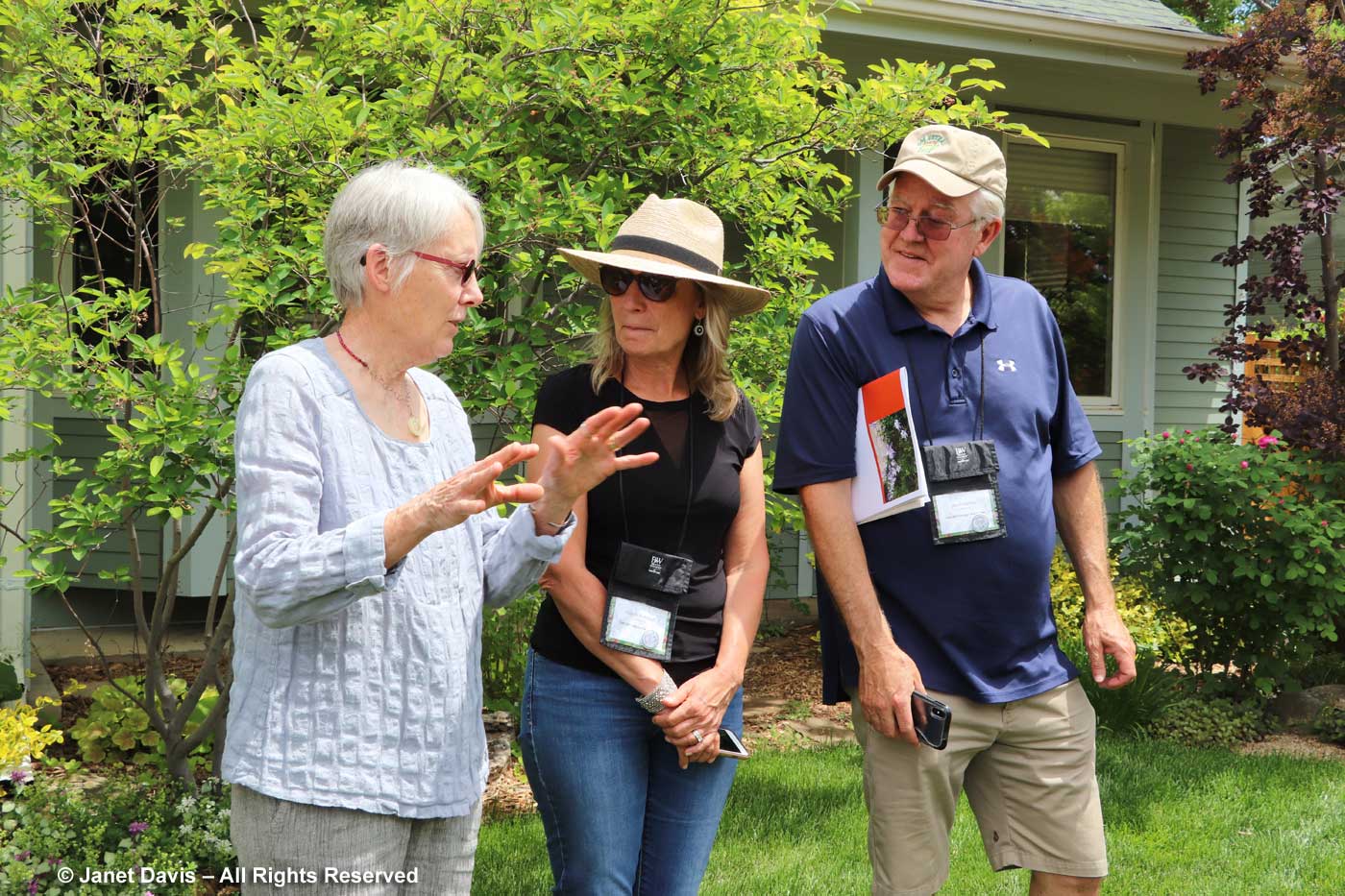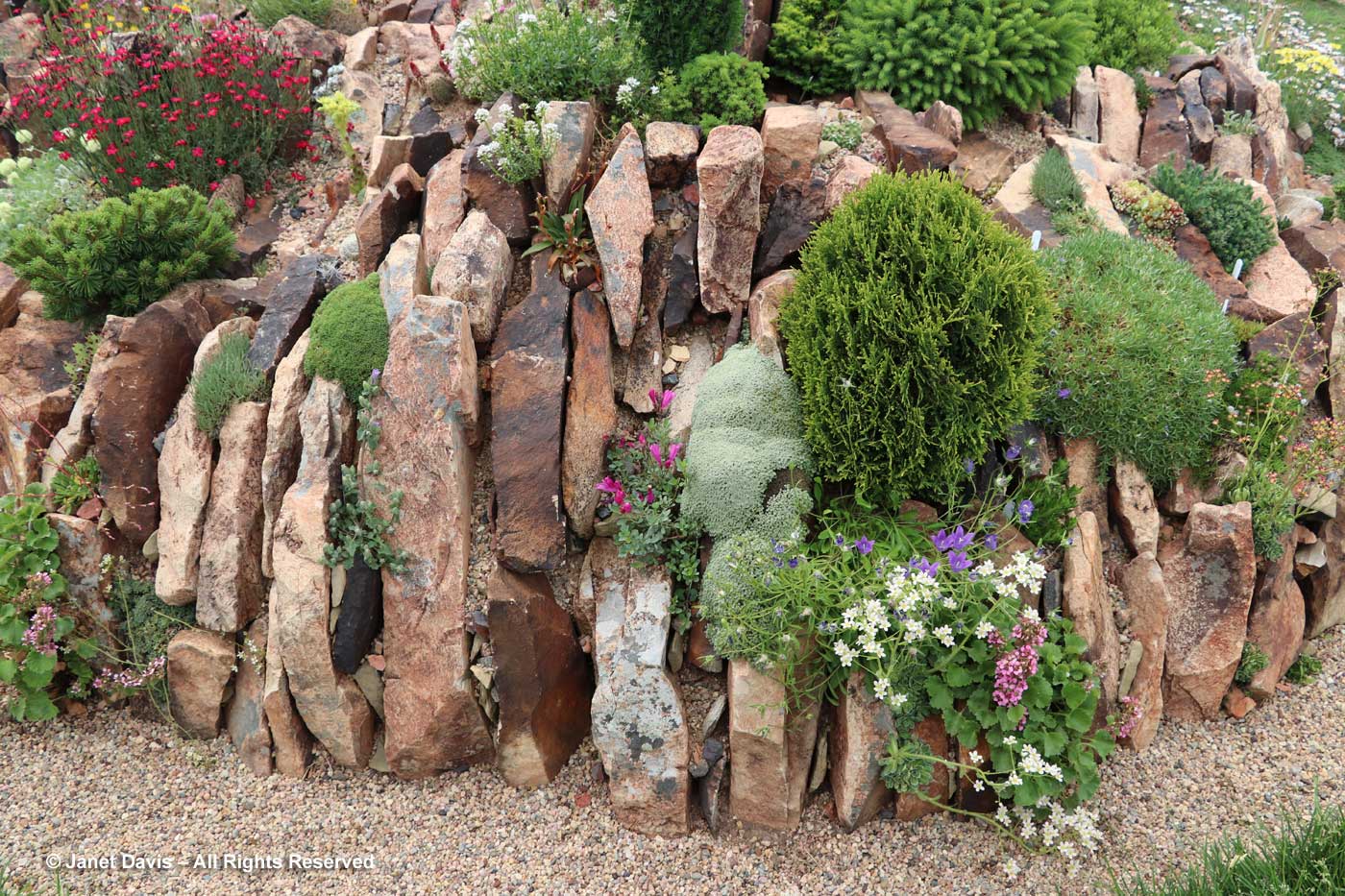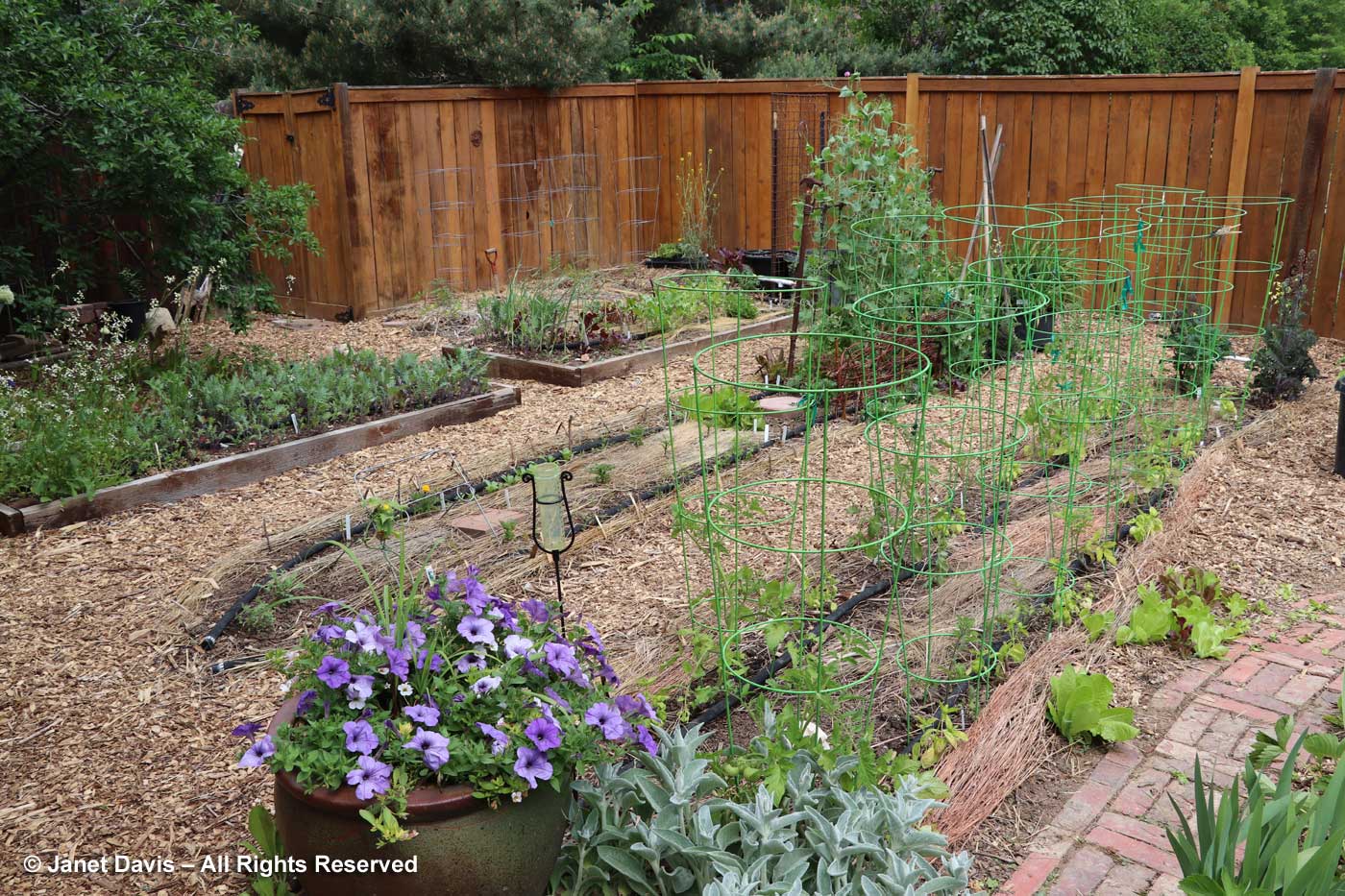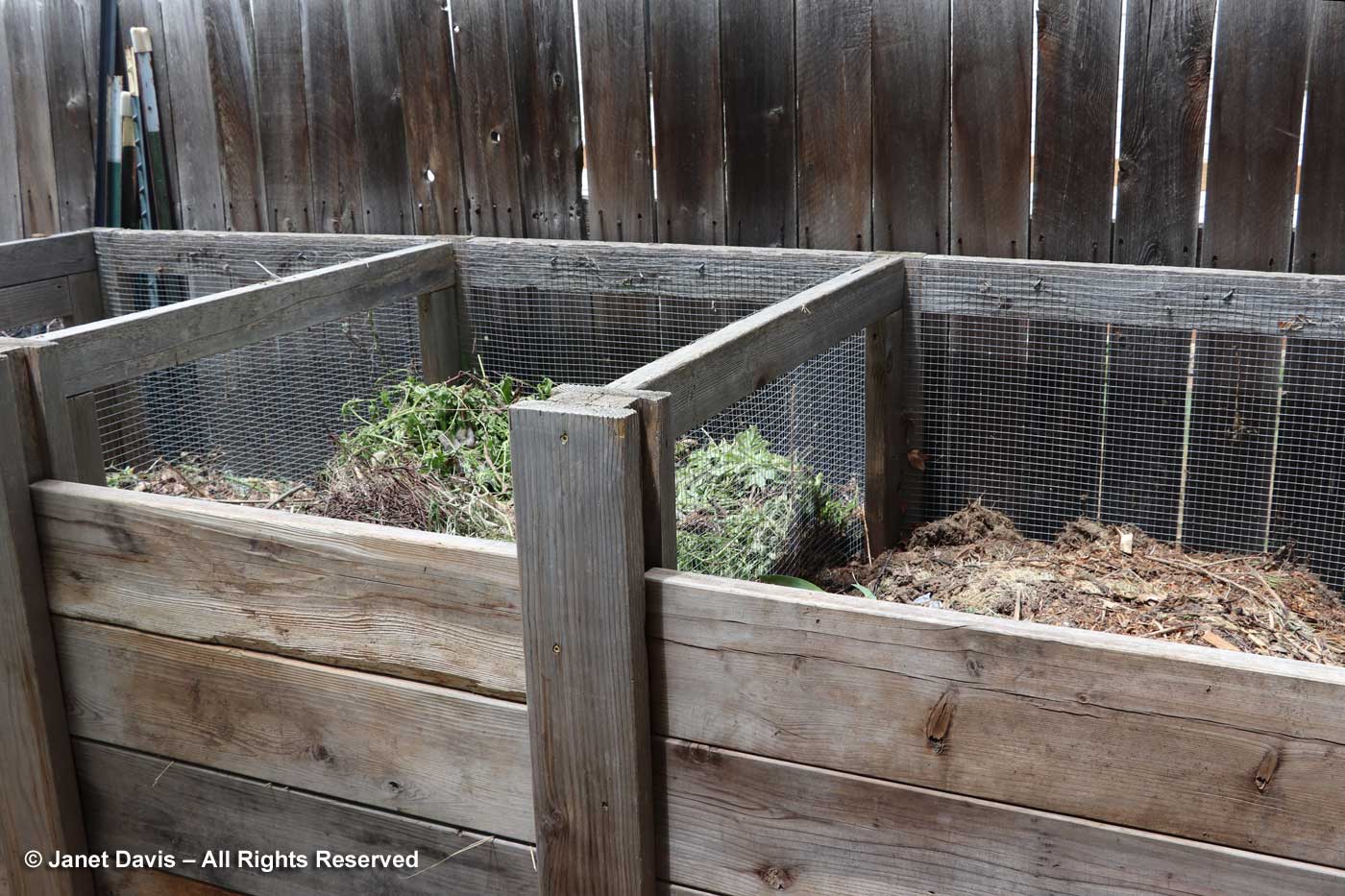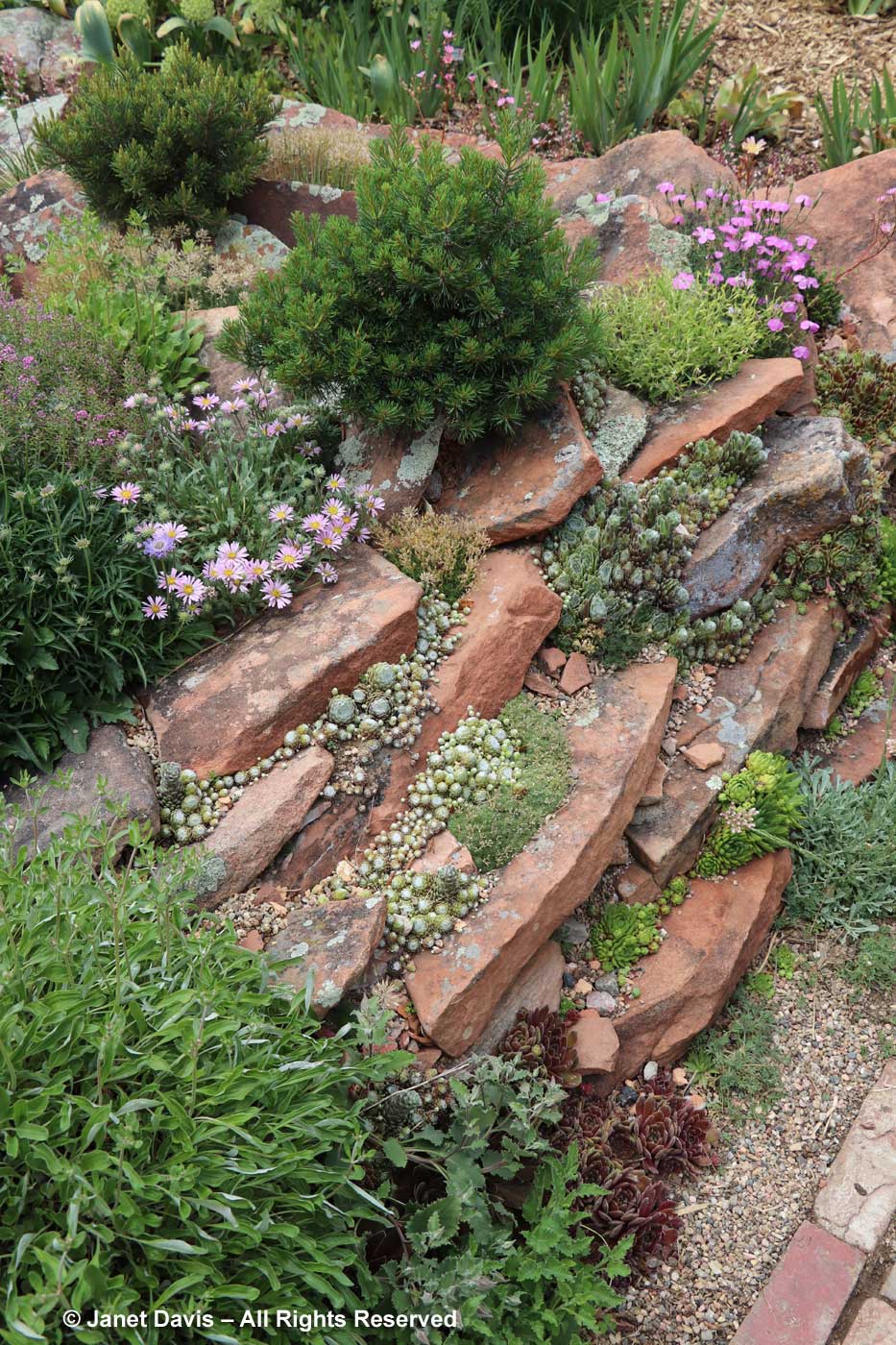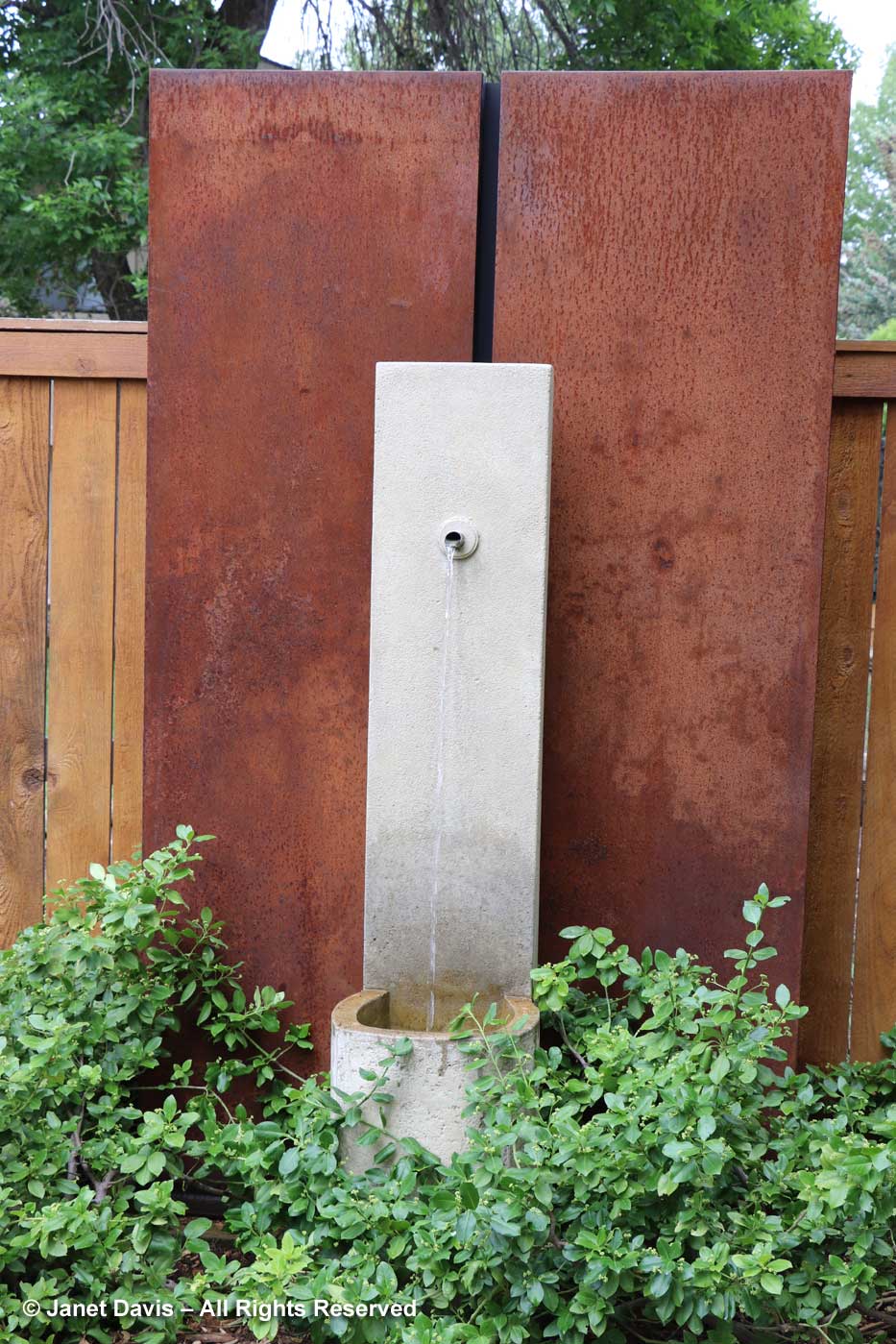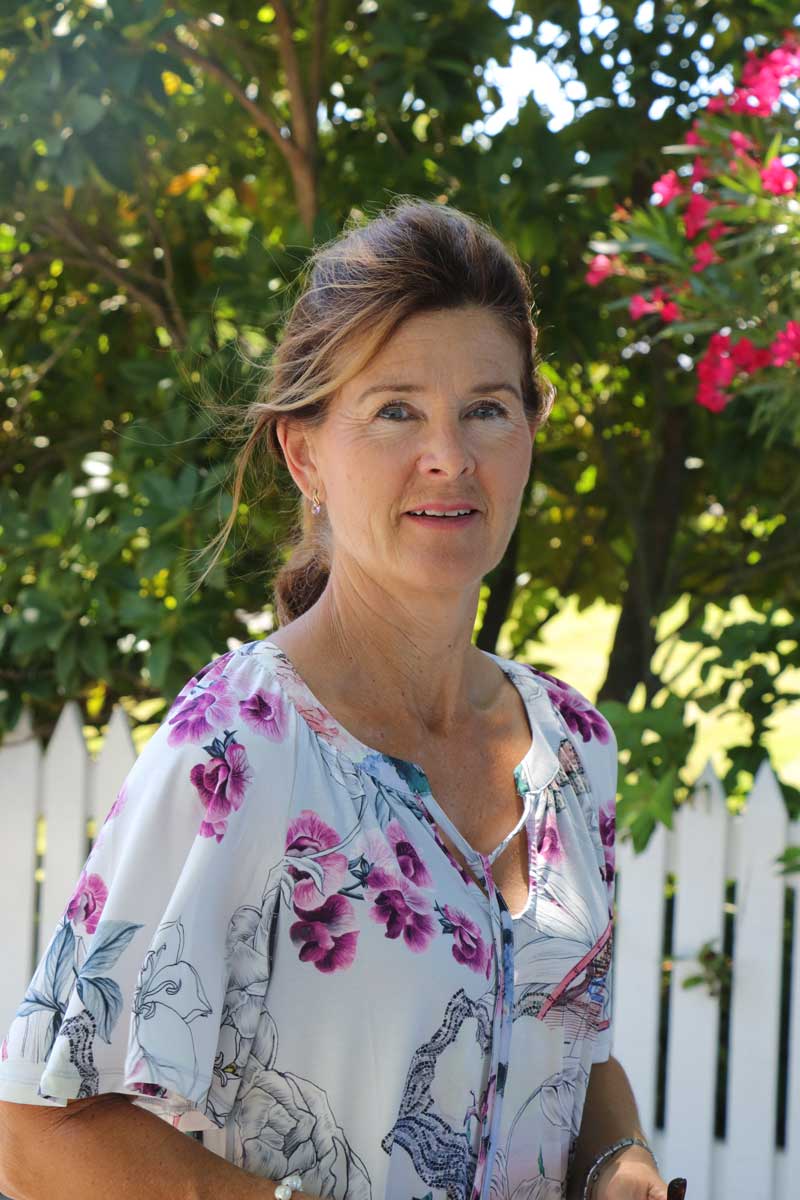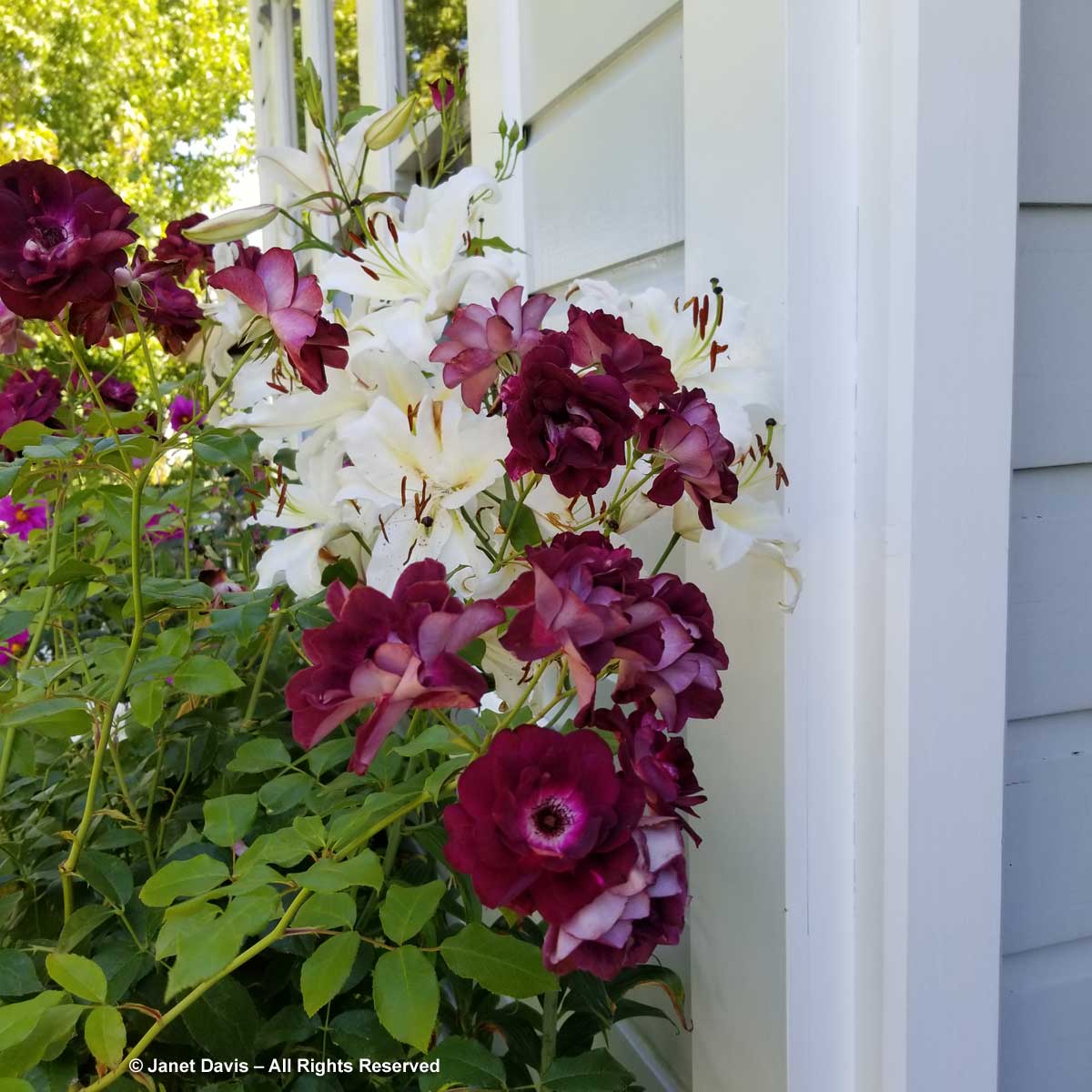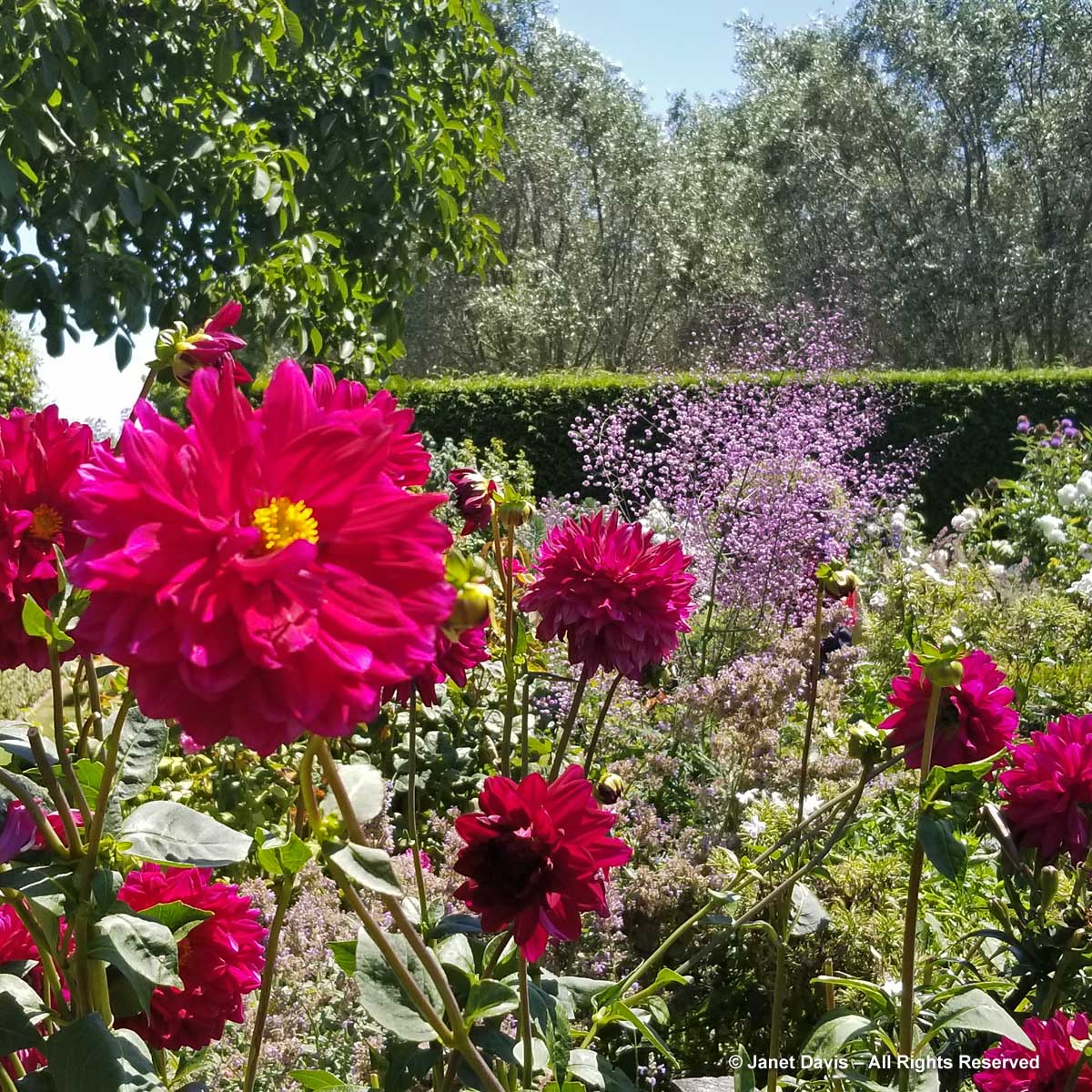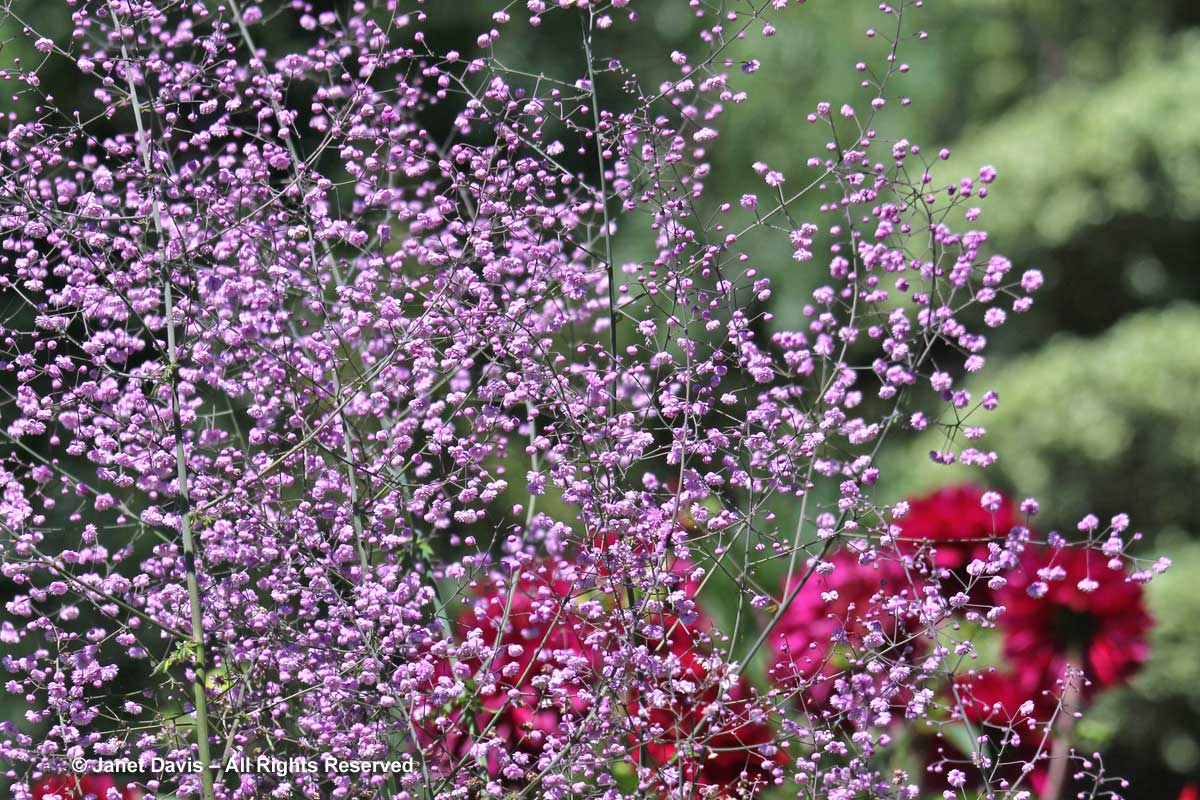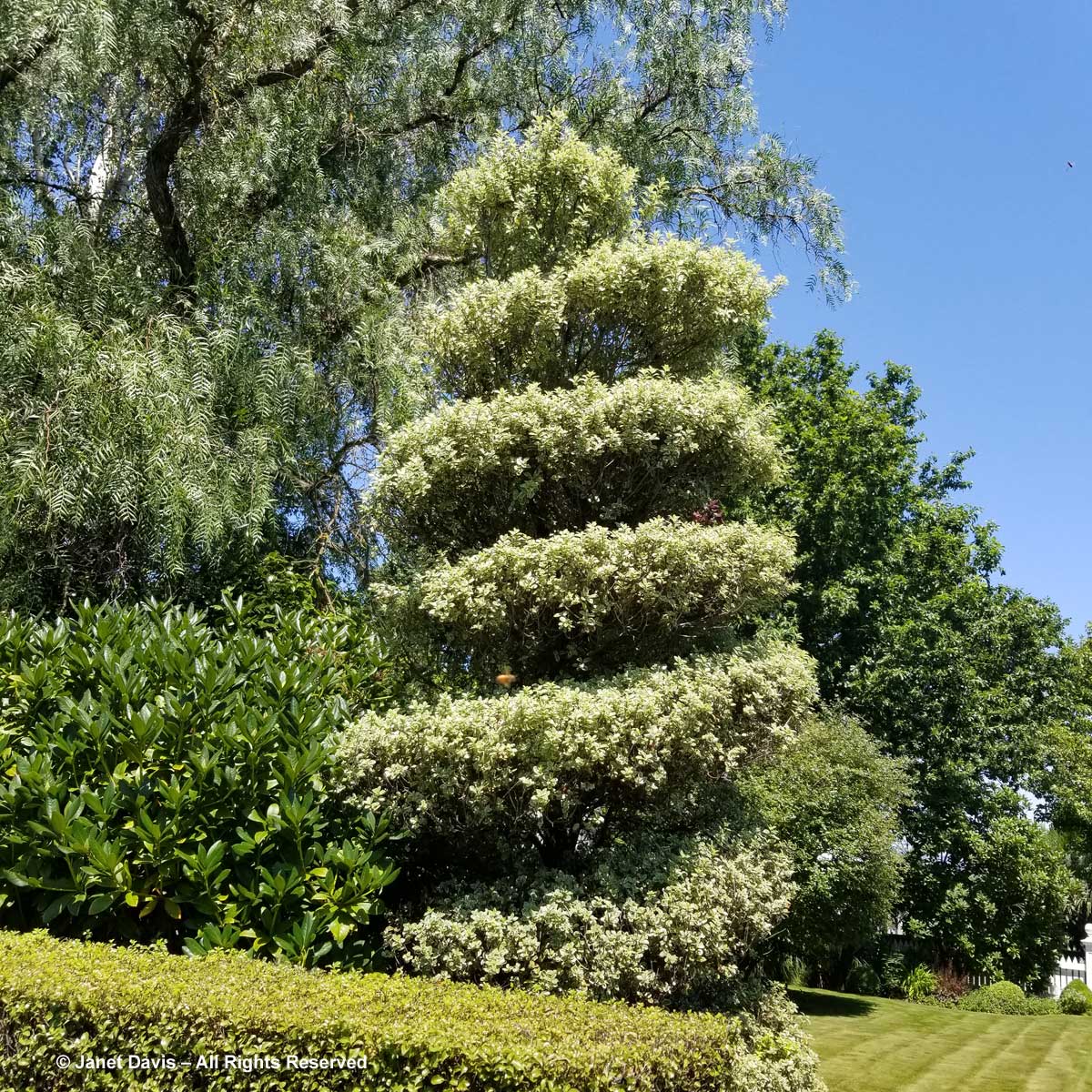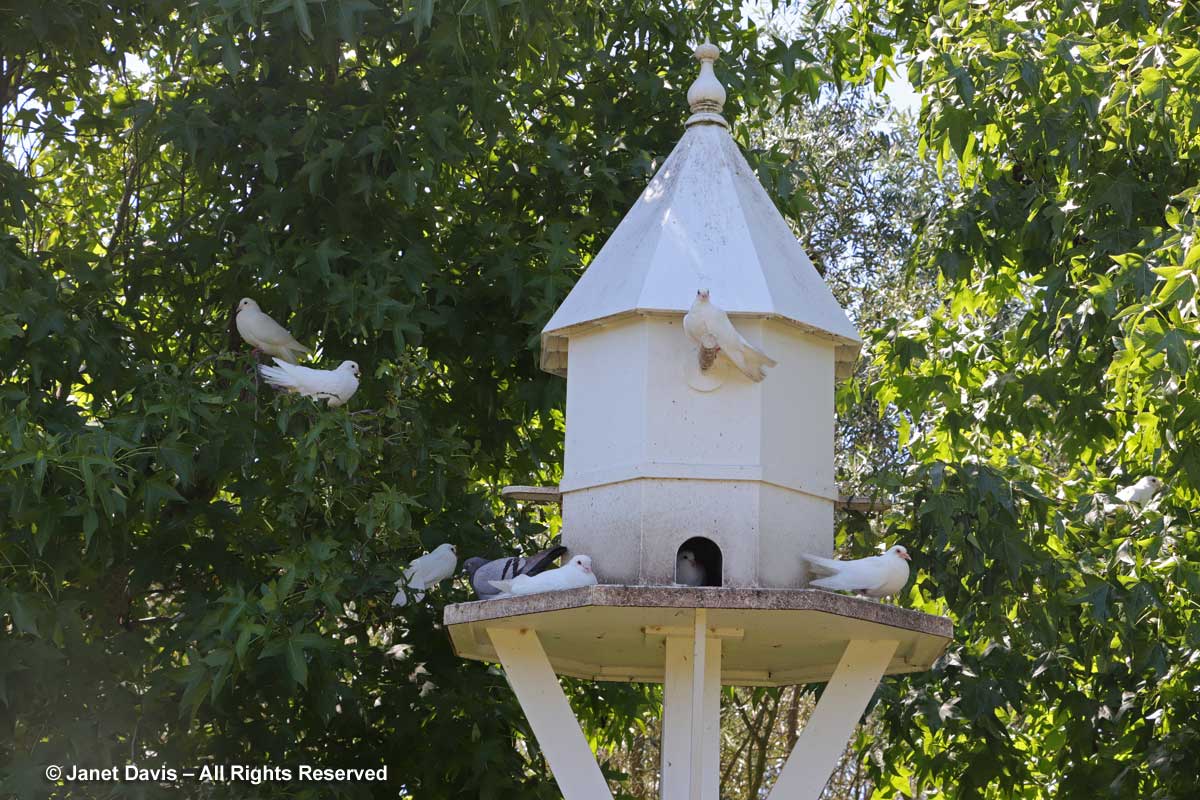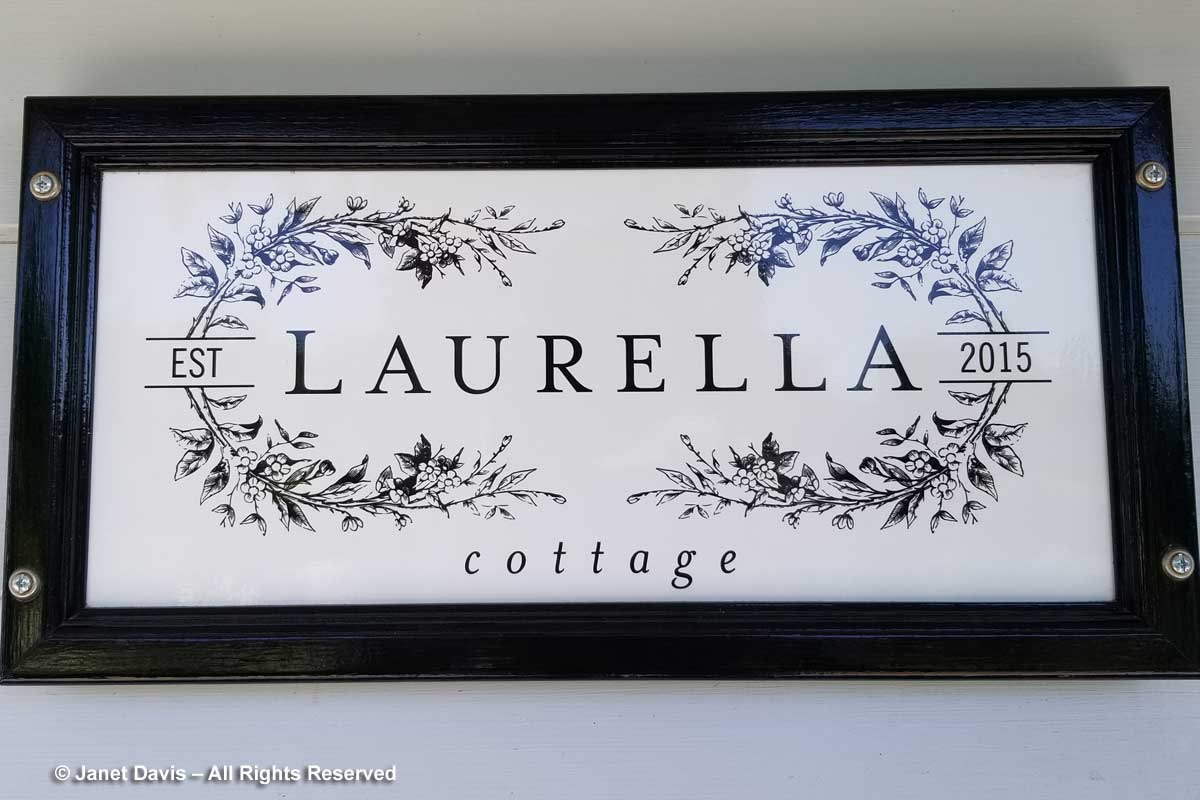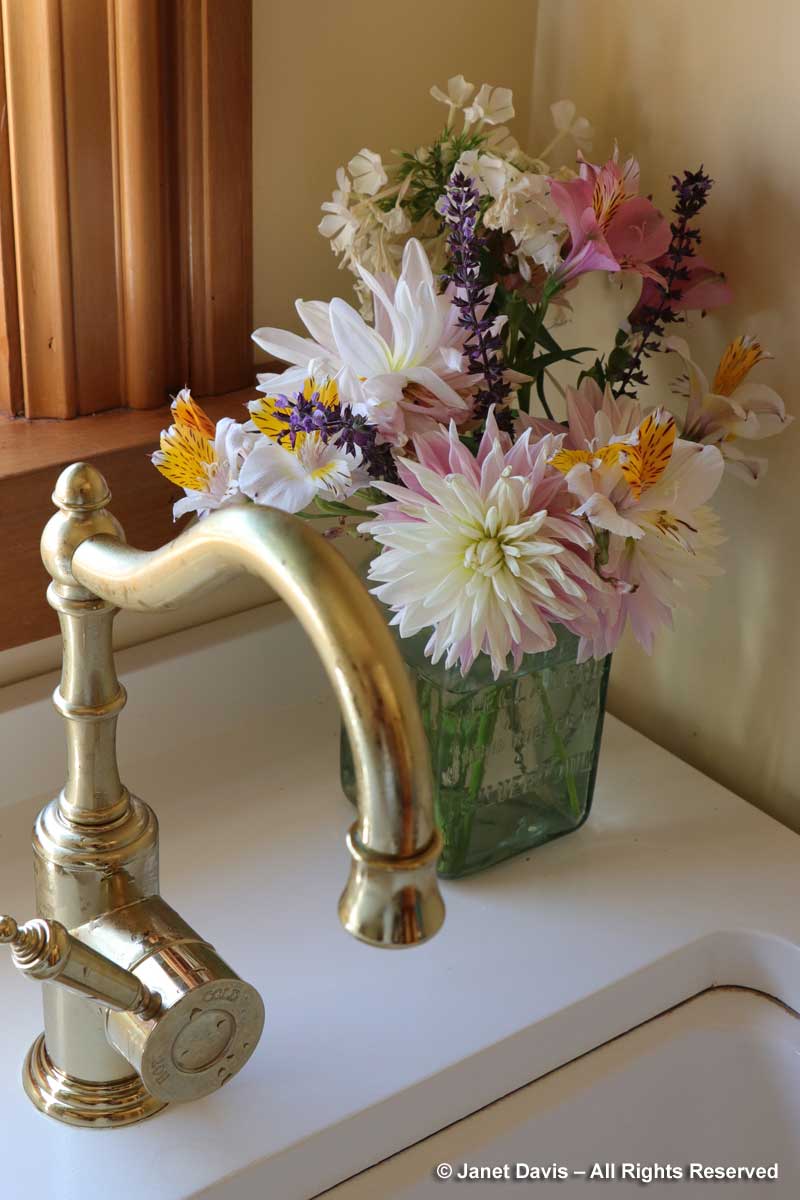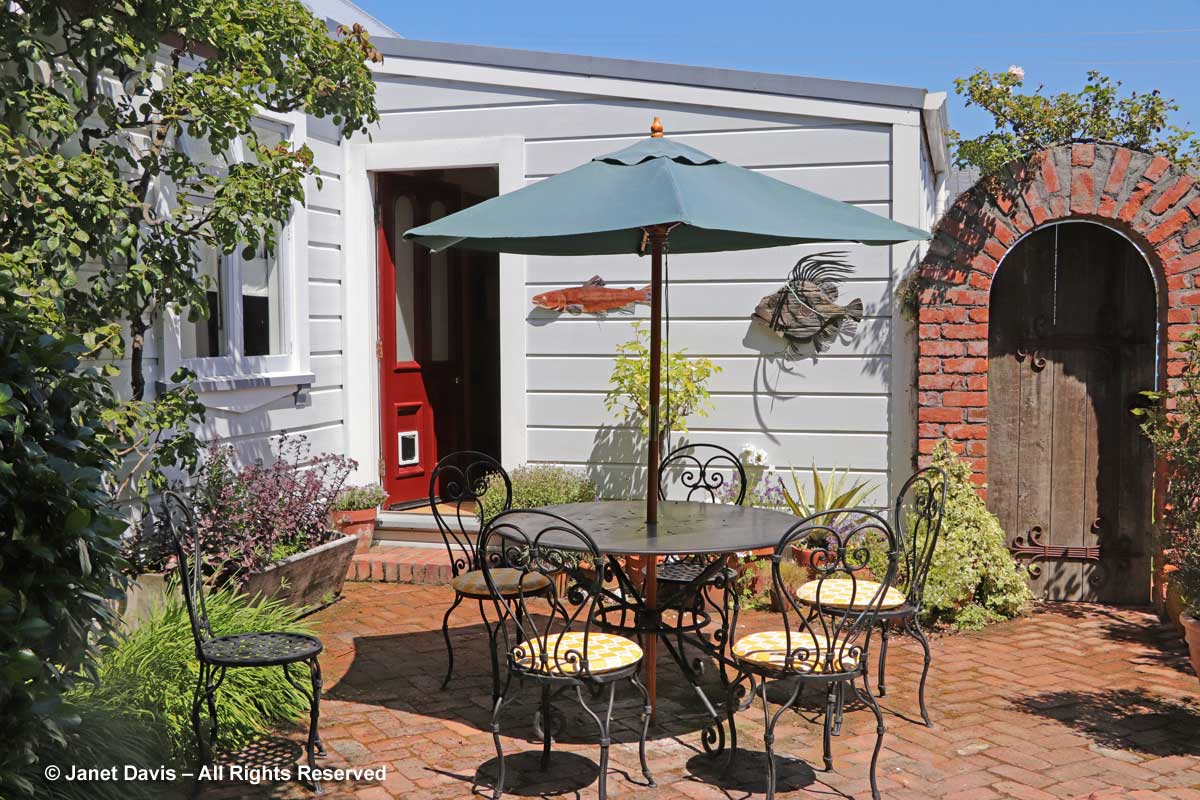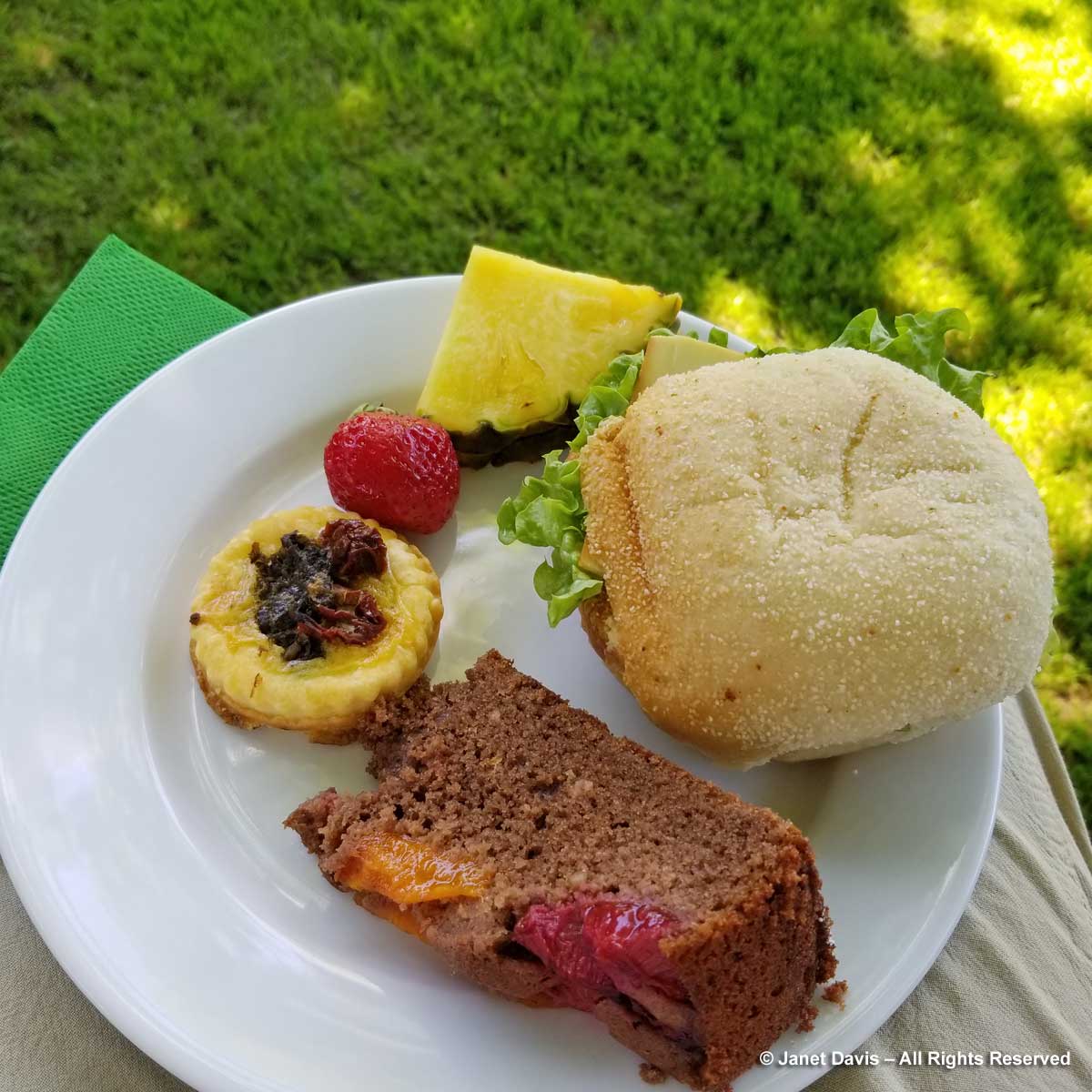What a treat I had back in June, along with more than 70 other garden bloggers during our annual “Garden Bloggers’ Fling”, to visit the beautiful garden of Rob Proctor and David Macke in the Highlands district of northwest Denver – and then to visit it again in softer light, the following morning! So in the midst of a very busy summer up here on Lake Muskoka (during which I’ve scarcely had a moment to revisit my photos) I nevertheless wanted to share images from my visit. If you arrive in June, this is what greets you even before you open the charming front gate.
In front of the house is a “hellstrip” from heaven, below, filled with a drought-tolerant symphony of plants in purples and soft yellows. It’s your first clue that the plantings here have been designed by a master colourist who is also a painter and botanical illustrator. Rob now appears on Denver’s 9NEWS twice weekly as a garden expert, but at one time he was co-director with Angela Overy of the Denver Botanic Gardens School of Botanical Illustration. He also served as the DBG’s Director of Horticulture from 1998 to 2003. As his friend and former colleague, DBG Senior Curator and Director of Outreach Panayoti Kelaidis said in an interview once: “He transformed a sleepy, provincial research garden facility and made us one of the great display gardens in America.”
Bloody cranesbill (Geranium sanguineum) creates soft cushions of magenta blossoms in front of lavender-blue meadow sage (Salvia pratensis), middle left. At middle right is purple woodland sage (Salvia nemorosa).
Bees were everywhere, including this honey bee nectaring on the woodland sage.
Two unusual xeric plants are lilac-purple Kashmir sage (Phlomis cashmeriana) and golden drop (Onosma taurica), below.
At the eastern end of the hellstrip, a brighter colour scheme featured….
….. apricot desert mallow (Sphaeralcea ambigua) with basket-of-gold (Aurinia saxatilis).
A metallic green sweat bee (Agapostemon virescens) was nectaring on the desert mallow, while….
….. nearby, showy milkweed (Asclepias speciosa) was awaiting monarch butterflies.
The word “hellstrip” is usually attributed to Colorado garden designer Lauren Springer Ogden, author of the acclaimed book The Undaunted Garden, among others. She and Rob also co-authored Passionate Gardening: Good Advice for Challenging Climates. In an article she wrote for Horticulture magazine back in 2007, Ogden wrote of the Water Smart Garden she designed for Denver Botanic Gardens, shown in my photo below: “The Denver Botanic Gardens’ former director of horticulture, Rob Proctor, played a crucial role in developing the full potential of the garden. The first couple of years it floundered—a good number of the called-for plants were not actually put in, and it fell under poorly trained and often careless maintenance. When Rob took over, he made it his priority to support the richness of the planting and the high level of care the garden deserved. He let me shop personally for many of the missing plants and add the beginnings of a collection of fiber plants that now brings so much to the dynamic year-round textures of the garden: nolinas, yuccas, agaves, and dasylirions—plants that just a few years ago were rarely used in Colorado gardens and often thought not to be hardy.”
Though I could have spent an hour exploring the luscious hellstrip, I was ready to find what waited on the other side of the gate in the ebullient gardens that surround the 1905 “Denver square” brick house that Rob and David moved into in May 1993.
I was invited in to look at some of Rob’s art. I loved this botanical rendering of a passionflower, one of many of his works hanging in the house.
But I was anxious to see what was out back, so I made my way past Stranger, the stray cat that hung around Rob and David’s garden for such a long time that he first got the nickname, then his new home.
Though Stranger elected to stay behind on the sunroom table, Mouse accompanied me out onto the brick-paved patio.
And what a patio it is, nestled into its own little garden spangled with lilac-purple Allium cristophii. Here we see the first wave of hundreds of containers that Rob and David fill with annuals each season, adding to pots containing tropicals, bulbs, succulents or perennials. Pots with tender plants are lifted outdoors each spring, nurtured and watered all summer, then transported back to the basement in autumn before Denver’s Zone 5 winter winds blow. Cobalt blue – a favourite colour – is the unifying hue here.
Teak benches and comfy cushions abound here and throughout the garden.
Tropical foliage plants mix with colourful annuals and succulents like Sedum rupestre ‘Angelina’ pair with potted lilies. Incidentally, Rob is an expert in bulbs in pots, having written The Oudoor Potted Bulb: New Approaches to Container Gardening with Flowering Bulbs way back in 1993, the year they moved here. It’s one of sixteen books he has authored or co-authored.
Though their property is more than a half-acre with several discrete garden areas, the patio is a lovely intimate extension of the house.
When I visited the first time, Rob, left, in his trademark vest and David, a retired geologist, right, held court out here.
I was impressed that David was able to reach out and pick a succulent pea….
….. from a pot of dwarf ‘Tom Thumb’ peas on the coffee table.
However on my second visit, it was just Mouse and me.
I enjoyed the sound of water from the raised goldfish pond….
….. and the splash of water from a unique watering can fountain set among pots on the stairs to the house.
But I was anxious to head out to explore the garden. When Rob and David moved in 26 years ago, the first thing they did was cut down eight “half-dead Siberian elms”. Said Rob in a 1995 article for American Horticulturist, he wanted to build perennial borders. “Because of the relatively formal look of the late Victorian Italianate house, I chose a strong, geometric layout of long borders. Occasional half circles soften the straight lines. Within this framework, I indulge in the controlled chaos that we associate with traditional herbaceous borders.” He carved out two rectangular beds each measuring 16 x 60 feet (4.9 x 18 metres) with an 8-foot wide strip of lawn in between. He then designed a backdrop of 12 brick columns – six per bed – connected by lattice screening and had a mason erect them on deep concrete footings. That resulted in four 8 x 60 foot perennial beds, two of which are visible below. At the far end on the property’s south boundary line is the gazebo, built atop an old carriage house and featuring a winding staircase to the flat roof and a shady dining area within. “Climbing the staircase,” wrote Rob, “it’s possible to view much of the garden from above.”
Mouse followed me dutifully out into the garden.
The colours here in June were exquisite, with purple and blue catmints, campanulas, cranesbills, meadowrues, salvias and veronicas enlivened by brilliant chartreuse. “Borders are like paintings,” said Rob. “Each one starts as a blank canvas. Working with a palette of plants, rather than paints, the possible combinations are limitless. The twin borders that cut through the middle of the garden contain the colors that I naturally gravitate towards – the blues, purples, and pinks.”
Each border held dozens of ideas for combinations. When I visited on June 17th, star-of-Persia onion (Allium cristophii) looked perfect with Kashmir sage (Phlomis cashmeriana)…..
….. and softened the flowers of broad-petaled cranesbill (Geranium platypetalum).
By the way, if you ever want to go down into a taxonomic rabbit hole, take a look at my blog on Allium cristophii.
The bold foliage of American cow parsnip (Heracleum maximum), below, offers a strong contrast to the soft colours and shapes of the central border. Later in summer, the white flower umbels reach up to 8 feet (2.5 metres). In one of the 2018 video clips from 9NEWS, Rob gives some pithy advice on how to handle this phototoxic native – just don’t! Clambering over the lattice in the back of this photo is golden hops (Humulus lupulus ‘Aureus’), one of a number of vines that Rob encourages for its lovely effect. As he wrote: “The golden hops vine needs little encouragement to thread through five or six feet of pink and blue flowers in this border, providing fresh, almost springlike foliage even in midsummer.”
Rob has used the red-leaved rose Rosa glauca as a background feature in one border, less for its single June flowers than for its strong foliage accent in order to enhance the massive beauty bush flowering in the background.
This was the view north along the twin central borders back to the house.
The third long border to the east featured white roses and the tall spires of Verbascum bombyciferum ‘Arctic Summer’….
…… nestled in a snowy cloud of sea kale (Crambe cordifolia).
The fourth long border on the west side is a confection of pinks and burgundies – peonies, roses and cranesbills in June. As it turns west near the immense beauty bush (Kolkwitzia amabilis), Rob gave special consideration to the unique colouration. “The beauty bush, its pale pink blossoms tinged with coral, inspired the color scheme of the surrounding plantings as the border turns to the west”. For the garden nearby, he chose sunset colours in lilies, red valerian, red sunroses, salmon pink nicotine and coral bells mixed with chartreuse and bronze foliage, to name a few.
In fact, he captured all three tints of beauty bush flowers in the cushions on the chairs placed strategically under its flowery boughs. This is colour perfectionism! Because of its size, Rob estimates the shrub was planted fairly soon after it was introduced to the west via Ernest “China” Wilson, who sent seed to Veitch’s Nursery in England in 1901. Flowers did not appear on the first seedlings for nine more years. It became very popular in gardens in the mid-20th century but deserves to be planted in gardens where its size can be contained.
This view melted my heart. And there were bees in that pink rose… scroll down to the video at the end of my blog and you’ll see them.
Clematis recta is a superb June-blooming herbaceous clematis. I’m not sure how Rob manages to keep his upright, but it does benefit from some kind of support, like a peony ring.
Further along, near the nuts-and-bolts of the garden (compost bins, potting shed, etc.) I noted one of Rob’s favourite strategies to introduce a splash of colour into the borders: a well-positioned pot with a bright red annual coleus. He does the same thing with red orach (Atriplex hotensis ‘Rubra’). Later there will be larkspur here.
We’ve arrived at the back where the gazebo is sited on the foundation of an old carriage house. A spiral staircase climbs to the top; it must be a lovely spot to sip a glass of wine and look back on the borders.
Down below, there was a table and chairs under the roof, providing a nice view and much needed shade in Denver’s notoriously hot summers.
Luscious tuberous begonias thrive here.
What a great spot for al fresco dinners – surrounded by tropicals and foliage plants. I loved the louvered panels at the back. And what do you suppose lies behind that dark picket fence?
Well, it’s an alley. A place where most gardeners would be content to create a couple of parking spots and leave it at that. But not David and Rob…. all that sunshine! So they not only reserved places to park their cars, but….
… also designed a potager divided into eight Native-American-inspired “waffle” beds, which are dug down below grade to capture precious rainwater, just as waffles collect syrup.
Bordered in thyme, the beds contain different types of seed-grown vegetables. At the centre of the potager is an artful cluster of pots.
As with every part of Rob and David’s garden, there is a comfy, colour-coordinated place to sit and relax – even in the alley!
Biennial clary sage (Salvia sclarea) is one of many plants allowed to self-seed here.
I loved this succulent-filled strawberry jar in the midst of the vegetables.
I headed back into the garden and made my way down the east side, where an old driveway has been re-imagined as the “gravel allée”. It’s a series of tableaux: sitting areas with colour-matched accessories and plants. Periwinkle blue and rusty-orange… sigh. You can imagine how enchanting this is for someone who called her blog “thepaintboxgarden”!
Such an inviting scene……
Double clematis are often less hardy than small-flowered species and varieties, so Rob pots them up and takes them to a less exposed area for winter.
Speaking of CLEM-a-tis, I liked hearing Rob educate his news colleagues on proper pronunciation of the vine.
Mouse was getting a little impatient for me to leave, so led me down the gravel path….
…. to containers nestled around a birdbath. Have you been counting the pots? I understand there are more than 600!
I’m a big fan of red-with-green in planting design and this section of the path tickled my fancy.
Under the mature trees here was another semi-shaded sitting area set in amongst shrub roses with yet another bench. I loved the row of potted aloes!
Now I was gazing at the house through a delightful thyme parterre herb garden.
I walked around to the south to see the view….
…. and then from the corner nearest the house. This is such a classic design – also created in the lowered waffle bed manner – and so lovely when the thyme…..
…. and the rose are in flower together.
I had a plane to catch later that afternoon, so gathered up my things and headed around the house to the front. There on the west side under the shade of the trees was one final treasure in Rob and David’s garden. It was a patio filled with shade-loving plants adjoining their sunken garden (down the stairs and just out of the photo below). As Rob wrote in 1995: “One weekend, while digging up self-sown tree-of-heaven saplings, we kept hitting brick. We determined that it was the foundation to a building, about 15 by 10 feet. Friends joined us for some urban archeology as we excavated it, finding hundreds of patent medicine bottles, broken china, and a waffle iron designed for the top of a wood stove. The foundation may have supported a summer kitchen or an earlier house, perhaps a farmer’s. We stopped digging at about four feet and, exhausted, decided our sunken garden was deep enough. We mixed in extra-rich compost to nurture the shade-lovers we intended to plant there.”
It was so hot that day in June, I would have loved to settle in the shade on those blue and red cushions and contemplate the lovely caladium. But it was time to go.
So, reluctantly, out I went through the gate entwined with Virginia creeper, to meet my ride.
As a bonus, I created a little musical tour through David and Rob’s enchanting garden, co-starring a selection of the bees that find nectar there:
Rob and David have shared their garden annually for many years now. It’s for a cause near and dear to them – and to Stranger and Mouse, too. And I’m so glad I was able to share their garden with you, too.


